
2023 Review


2023 Review
On the 19th June e Grand Master of the Sovereign Military Order of Malta, Fra’ John Dunlap, was received in audience by Pope Francis at the Vatican. It was the rst meeting since Fra’ John Dunlap was elected 81st Grand Master of the Order of Malta on 3rd May.
e audience o ered the opportunity to review the most important commitments, starting with aid for refugees and displaced persons, increasingly at the centre of the Order of Malta’s humanitarian programmes. Pope Francis listened attentively to the Grand Master’s words, exhorting the Order of Malta to continue its millenary mission of assistance and charity to face the many global challenges.
At the end of the conversation, the Grand Master presented the Pope with a silver medal depicting the birth of the 100,000th child in the Holy Family Hospital in Bethlehem, run by the Order of Malta, last January.
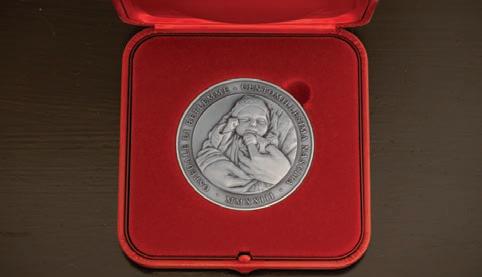
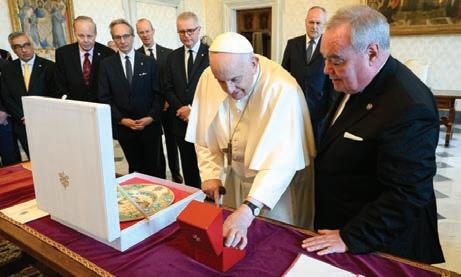



Welcome to the 2023 Australian Hospitaller magazine, the annual review of the Australian Association of the Order of Malta.
It has been a pleasure to document the important work the Order has been undertaking locally, regionally and globally during 2023.
Our Association President, the Honourable James Douglas talks of change in his yearly report and there has been much of this during 2023.
For the rst time in our Order’s history, we have a Grand Master from the ‘new world’. His Most Eminent Highness Fra John T Dunlap, born in Canada and was a member of the New York Bar and the Ontario Bar Association prior to becoming a professed Knight in 2008.
It is no mere coincidence that for the rst time we have a religious superior and Sovereign that has begun his journey in the Order as a volunteer and not through noble family lineage. He now oversees a period of change in the structure and governance of the Order under the direction of the Holy See.

is examination of conscience guide structured around the Daily Prayer of the Order, may be used as a tool to give members a bearing on how they are living their commitments in the Order of Malta.
“With the election of the Grand Master you will nd a sure guide, a guarantor of the Unity of e Whole Order in delity to the successor of Peter and to the Church”, Pope Francis has said.
Lord Jesus, ou has seen t to enlist me for y service amongst the Knights and Dames of St John of Jerusalem
e intent of the recent constitutional reforms we have seen are essentially spiritual while maintaining the sovereignty of the Order. Our professed members are the ‘spiritual heart’ of our Order and are essential to maintain our charism and spiritual origins, especially during times of change.
e Australian Association of the Sovereign Military Hospitaller Order of St John of Jerusalem of Rhodes and of Malta
9. Have I failed to show up for works of the Order due to lack of interest, laziness, or failure to give space in my life to the Order?
Members of Executive Council:
1. Lord Jesus, remembering commitments I made to you when I entered the Order, have I disappointed your trust in me in any way?
A wish for a renewed focus on vocations for professed Knights of Justice has been made clear by the Holy Father and the increased focus of the role of priories and spiritual development of all members in pursuit of Christian perfection and personal sancti cation.
As you can see, our cover story is the ‘Stola’ of the professed. We hope that this insight into one element of the tradition of our Knights of Justice will add to our understanding of their role as our spiritual leaders and prayerful pillars of our Order.
President:
e Hon James Sholto Douglas KHD (Ob)
Vice President: Daniel Kwok KGCMG (Ob)
Chancellor: Scott Robert Samson KMG
Treasurer: James Gurry KMG
National Hospitaller: John Murphy KMG
Give me the strength I need to carry out this my resolve, forgetful of myself, learning ever from y holy Gospel a spirit of deep and generous Christian devotion, striving ever to promote God’s glory, the world’s peace, and all that may bene t the Order of St John of Jerusalem.
Hospitaller Northern Central Region:
Let us pray for vocations of the professed and commit ourselves to further deepen our faith and strengthen our resolve to serve those in most need.
I humbly entreat ee through the intercession of the most holy Virgin of Philermos, of St John the Baptist, Blessed Gerard and all the Saints, to keep me faithful to the traditions of our Order.
Pope Francis shared this following wisdom from his address to the recently elected Sovereign Council: “By caring for the sick, you recognise in each of them the su ering of Christ whatever their origin, nationality or religious belief. e works must be well organised and well managed but above all they must be a sign of Christ’s charity, which is like a mold you must have for all the works performed.”
2. Have I actively modelled myself a er the examples of our patrons Our Lady of Philermos and St John the Baptist, our founder Blessed Gerard?
John Murphy KMG Publisher
3. Have I regularly served those in need, especially the poor and sick, in the tradition of our founder and predecessors throughout the history of our Order?
Be it mine to practise and defend the Catholic, the Apostolic, the Roman faith against the enemies of religion.
Publisher: John Murphy KMG
4. Have I consistently and ardently practiced the Catholic faith – in prayer, Eucharist and Confession, in retreats, in learning about my faith, and in works?
Editor: Monique Gaist
Sub editors: Daniel Kwok KGCMG (Ob)
5. Have I failed to stand up in word and action when attacks against our faith are made whether in ignorance or hostility?
Christine Clancy Design and Production: Blake Storey
6. Am I a credible witness of the Catholic faith?
Be it mine to practice charity towards my neighbours, especially the poor and sick.
7. Have I been unloving or disinterested to those close to me in my life?
8. Have I been indi erent to those in need, especially the poor and the sick I see, as well as others in need – the homeless, lonely, marginalised, displaced – all who are lowly and vulnerable in our community?
Dr Maria Randazzo DMG (Ob)
Hospitaller North Eastern Region:
Danny Higgins KMG (Ob)
Hospitaller Central Eastern Region:
10. Have I regularly made the e ort to expand and deepen my understanding of the holy Gospel and let the Word of God penetrate my heart?
Dr Stephen Christie KMG (Ob)
Hospitaller South Eastern Region: Paul Hoy AM KSG KGCMG
Hospitaller Central Southern Region: Noel Mifsud KMG
11. Do I love God with all my heart, soul, and strength? Is God the centre of my life, and so, do I love all other people, things, and activities in light of my rst love of God?
Hospitaller New Zealand: Bevan Killick KMG
Delegate of Communications: Nigel Kassulke KMG
12. Have I been a peacemaker, building and supporting positive relationships among fellow members, staying out of gossiping, scandalising, quarrelling, and politicking?
Vice Delegate of Communications: Anthony Gerada KMG (Ob)
National Communications Manager: Michelle Rees
13. Have I actively pursued opportunities to help the interests of the Order of Malta?
Communications Associate: Joseph Grogan KMG
Subpriory of the Immaculate Conception
honorem.
Regent: Professor David Kissane KGCMG (Ob)





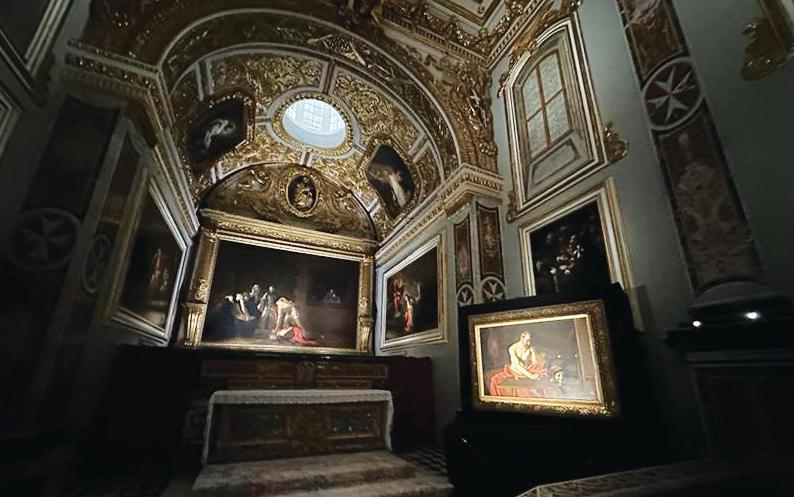

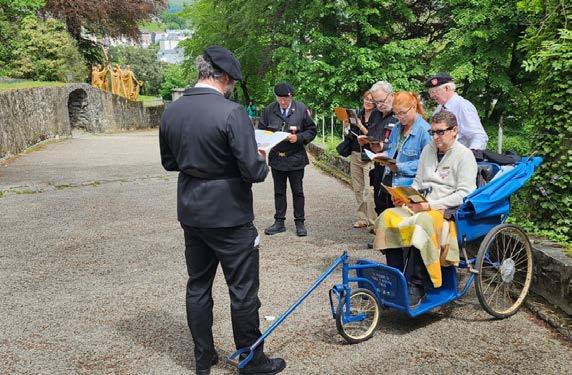
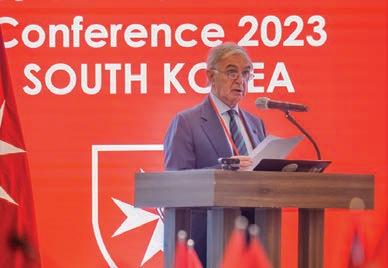
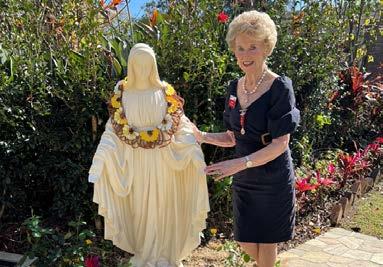
60 Book Review
Review of Splendour & Devotion: e Art collections of the Order of St John
62 Obituaries
Remembering members who passed in 2023
68 Asia Paci c Conference e 12th Order of Malta Asia Paci c Conference
50 e History of the Polish Association
Looking at their works over the century
71 Consistency and Change
In the life and mission of the Order of Malta
76 Our Lady of Philermos Rose and Hymn
Our Lady of Philermos Rose project
79 Examination of Conscience
Daily Prayer of the Order
Family

By John Paul Sonnenon KM American Association
A renewed focus on the calling to the professed life of a Knight of Justice, Knights who have made vows of poverty, chastity and obedience, gives us an opportunity to learn about this unique vocation and some of its ancient traditions.


Anyone who has attended liturgical rites of the Sovereign Military Order of Malta (SMOM) in places like England or Rome can appreciate the visuals, the high level of pageantry, and colourful symbolism particular to the Order. What many do not know is that the Order of Malta is the only lay religious order in the Church and it has some of its own liturgical traditions.
Professed members, including the Prince and Grand Master, have a unique liturgical tradition prescribed by the Order’s Caeremoniale: they are clothed with a oneof-a-kind lay vestment of sorts known as the “stola.”
ey receive this symbol of their profession and part of their habit when they make solemn profession, a very rare and ancient ceremony. Few professed knights exist. e stola hangs from a sling attached at the back of the neck while wrapping around and resting on the le forearm, similar in a very broad sense to a maniple.
“ is garment re ects two injunctions of Our Lord: “Whoever wants to be my disciple must deny themselves, take up their cross and follow me” (Matthew 16:25); and “Take my yoke upon you, and learn from me; for I am gentle and lowly in heart, and you will nd rest for your souls. For my yoke is easy, and my burden is light” (Matthew 11: 29-30).
e stola is a literal yoke, hanging from the back of the neck, and comprises embroideries of all the instruments of the Passion, from the Cross itself, carried high on the Professed’s back; to the knotted cords

with which He was scourged, and dice with which they cast lots for His clothes at the bottom end, hanging over the le arm. It also includes the words spoken by Our Lord on the Cross.”
Members of the Order re ect on the stola and meditate on the rich symbolism of its embroidered images. By the merits of His saving Passion we are redeemed by His Most Precious Blood. e instruments of His Passion and other relics of the Passion and death bring to mind the sacri ce of Calvary and our baptismal promise, that we will be born again with Christ through the glories of his Passion, death, and Resurrection.
e long list of images include the wood of the cross, the spear and sponge, the crown of thorns, the 4 nails, the hammer and nail pincer, Veronica’s veil, the seamless garment of Christ, the palm branch of victory, the cock that crowed at Peter’s denial, the casting of lots or dice thrown by the soldiers, the cruet with vinegar o ered as drink to Christ, the thirty pieces of silver of Judas, the violence of the sword, the kiss of betrayal, the pillar of scourging, and the instruments of ogging and beating. Last, but not least is the prominent Maltese cross from Amal with its 8 points, a reminder to members of the importance of the eight Beatitudes.
God bless and reward the professed members of the Order. May they continue to deny themselves and learn from Christ by carrying His Cross; and let us ask Our Lord to send an abundance of fresh vocations of professed members to the Order. At the drama of every Mass we o er ourselves to Christ (the O ertory), we die with Him (the Consecration), and because we die with Him we receive new life (Holy Communion).
May all of us be inspired by the stola, worn by professed members, seen at liturgical events generally seated in the sanctuary or in the front pews. May all Catholics take note of

the holy words seen on the stola taken from the 7 last words of Christ: CONSUMATUM EST and SITIO (“It is consummated”) in John 19:30 and (“I thirst”) in John 19:28. By meditation on these holy words may we be inspired by the ignominy of the cross and its glorious triumph.


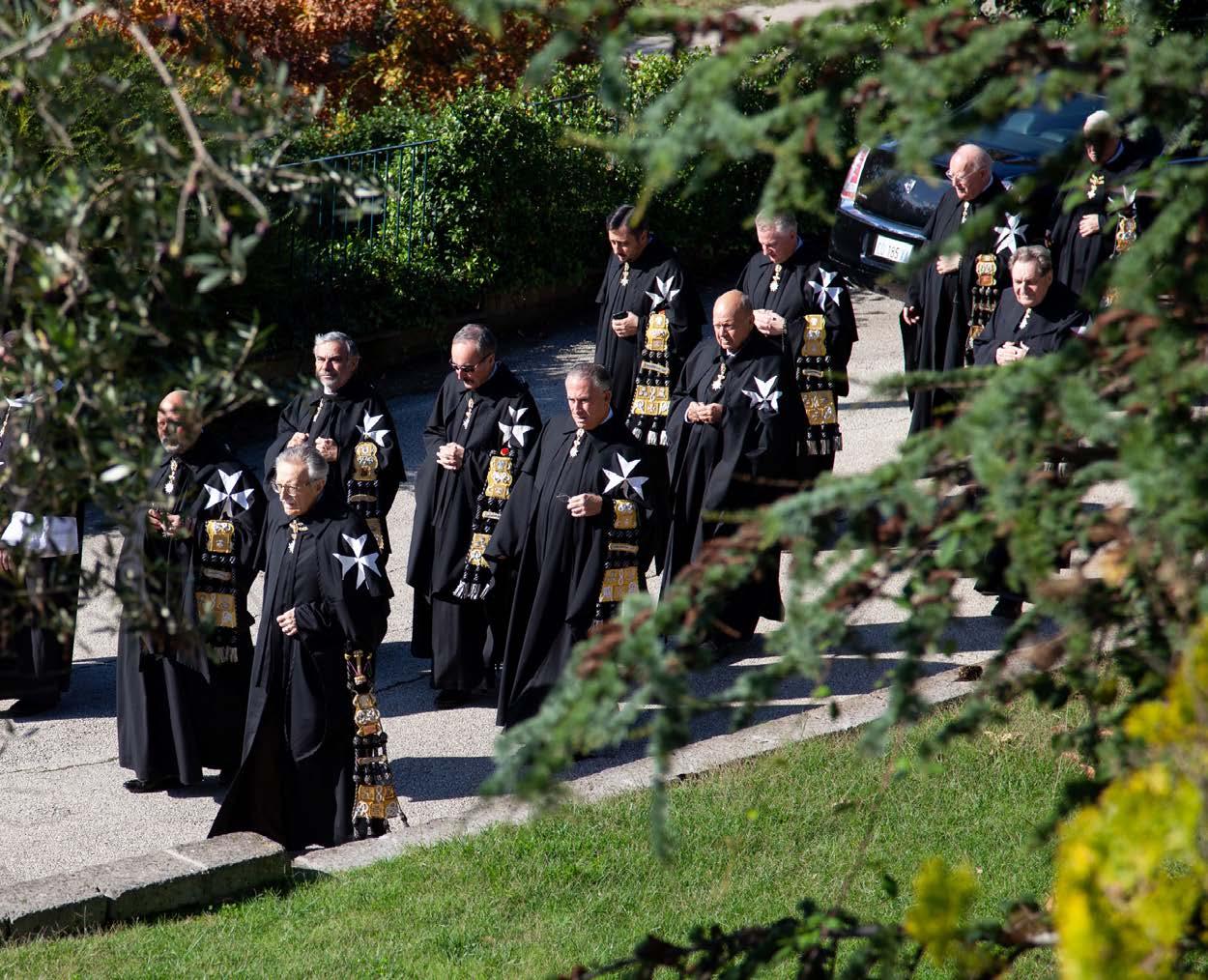

One of the distinctive signs of the professed knights of the Order of St. John of Jerusalem is the cord or stola embroidered with the Instruments of the Passion which is worn attached to the neck of the choral dress. e Ceremonial of Profession, approved by Urban VIII and still in force today, explains that it is imposed on the new religious of the Order as a perennial reminder of the bitter Passion of our Lord Jesus Christ, who su ered for us on the Cross, reminding you o en that this is the Rope with which he was bound; these were the Scourges, with which he was beaten, this is the Column, where he was bound, and bitterly scourged; these were the Dice, and this the Sponge, and nally this is the Cross upon which our Lord Jesus Christ su ered for us, which has to be your guide, and teaches you in all your undertakings, and for all the time of your life.
e cord therefore symbolizes the yoke of Christ (Matthew 11,25-30) that “is easy, and light, and will lead you to eternal life, if you are able to tolerate it with that patience, and with that charity, which he expects of you, as a true Religious, and as an honored knight”. Gioacchino Quadri di Cardano
ank you to the Grand Magistry communications o ce, e Grand Priory of England and our two authors John Paul Sonnenon and Gioacchino Quadri di Cardino.
e Hon James Sholto Douglas KHD (Ob) re ects on a year of change. e new Constitutional Charter and Code in particular, gives us all an opportunity to be open to our Holy Father's guidance and renew our commitment to our vocation.
We live in an era of change – the only constant is change as the cliché goes.
Recently I was privileged to attend an inspiring interview with the Czech “priest/ prophet” Fr Tomáš Halík conducted by Fr Frank Brennan SJ. Fr Halík has recently published a new book, A ernoon of Christianity: e Courage to Change. Austen Ivereigh discusses it in a recent article in e Tablet, saying:
“ e time has come for Christianity to transcend itself,” Halík writes: to move out beyond its existing mental, institutional, and cultural boundaries, to ask how the Spirit is acting, to nd a new cultural home. It’s what Jorge Mario Bergoglio of Buenos Aires told the cardinals just before they elected him, that the Church is called to “come out of itself”, to open up to the peripheries, and receive the new thing the Spirit is doing.”
We in the Order are well placed to participate in that form of change as part of the Pope’s “ eld hospital” view of the Church. While a spiritual home for members, the Order is also our “cultural home” within the Church. Our mission to care for the poor and sick and to sustain the faith aligns very directly with His Holiness’s approach.
How then is change manifesting itself in the Order?
Change in the Organisation of the Order With us change was imposed by the new Constitutional Charter and Code promulgated by the Pope on 3 September 2022. Its principal focus was on the renewed importance in the life of the Order of the roles of the professed knights and conventual chaplains. We are blessed that several of our members are considering whether they wish to become professed knights. We are also considering how we may be able to assist them in that process.
A group of new High Charges
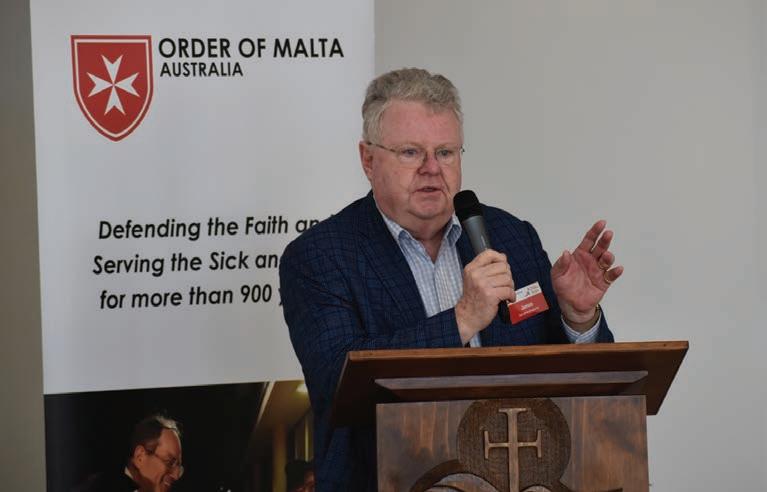
announced in September 2022 have been con rmed in o ce by the votes of a Chapter General held near Rome in late January 2023. I was privileged to attend as one of the 15 elected presidents with the Regent of our Sub-Priory, Confrère Professor David Kissane. I reported on that meeting in last year’s Australian Hospitaller.
Since then we have also attended the Council Complete of State at the beginning of May 2023 where Fra’ John Dunlap was elected as our rst Grand Master for a number of years in a popular result at a meeting lled with con dence for the Order’s future. We expect that he will visit us in 2024 to help celebrate our 50th anniversary in Australia.
Cardinal Ghirlanda, the canon lawyer so heavily involved in the dra ing of the new Constitutional Charter and Code, was, shortly a er, announced as the new Cardinal Patronus of the Order.
We are continuing to engage with the Grand Magistry about the consequential changes that will be required in our local Constitution. Our own changes to our local structure and Constitution in 2021 have at least made us familiar with the process. e Statutes of the Sub-Priory will also require amendment in consultation with the Grand Magistry.
Our Strategic Plan was distributed
in 2022 and has assisted our planning from 2021 through to 2024. Many people contributed to its development but may I mention Confrères John Murphy and Daniel Kwok in particular. One of its aims is to increase the membership of the Order, something to which all members can contribute.
While in Perth during the year for the Royal Commission into Defence and Veteran Suicide I was able to meet members of the Order there including Confrères Dr Michael Shanahan and Dr Andrew Cichy. With the assistance of our former Vice-President, Consoeur Professor Michelle Campbell of Notre Dame University we are seeking to extend the Order’s membership in Western Australia.
Part of our work has involved the production of handbooks for the year of preparation, spiritual formation, spiritual accompaniment and for chaplains. Again, Daniel Kwok and John Murphy have had much to do with their compilation and production. at work has been recognised by being used at the Grand Magistry as a base reference for the creation of formation documents for all members of the ird Class and for chaplains across the Order.
We have also adopted numerous policies available on the website. I wish to mention our former Chancellor, Confrère
Scott Samson, for his energy in developing those policies and documents to help us make the Order’s operations here as professional as possible. He was ably assisted by other members of the Executive, in particular our National Treasurer, Confrère James Gurry, our National Hospitaller, Confrère John Murphy, and Confrère Bevan Killick, our New Zealand Regional Hospitaller.
We are working with our sub-organisations in ailand and South Korea, with the recommendation and support of Grand Chancellor, to move them into “Foreign Delegation” status, and from there to develop into Associations of their own. As Foreign Delegations, they will be selfmanaging units but still remain under our oversight as the competent entity. We are working with them to adapt their constitutions to meet the Grand Magistry’s requirements.
Biennial Meeting at Brisbane and Southport In June we held our biennial meeting in Brisbane and at the Gold Coast. Organised very successfully by Confrère Richard Palk and his committee, its theme was “Modern by Tradition”. e rst three speeches focussed on consistency and change in the Order – in our life and mission, our spiritual development and the changes in the new Constitutional Charter and Code. Archbishop Coleridge’s address on consistency and change in the Order was particularly inspiring as well as typically learned. We then turned to an examination of our ethos, modern by tradition, delivered by Consoeur Professor Tracey Rowland, our renowned theologian, receiver of the international Ratzinger prize for that discipline in 2020. Hers was an outstanding speech greatly appreciated by the audience.
e focus then shi ed to the works of the Order in palliative care, so signi cant in our South Eastern Region, the clinic in Timor Leste and elsewhere internationally, through Malteser International. We have been successful in raising funds for national and international disasters in recent years and are delighted to see those moneys being used so well, for example, in the Ukraine in association with MI. We continue to develop our ideas with MI about how best to formalise our relations in the future. I can mention that our members Maurice O’Connell, Elizabeth and Nicholas Trongale had courageously served in Ukraine assisting with refugees.
e conference proceedings included a bus trip to Southport to nd out more about the proposed Order of Malta Community Care Centre in that city. is brainchild of our chaplain and parish priest of Southport, Fr Gerard McMorrow, and the North Eastern Regional Hospitaller, Confrère Danny Higgins, will provide another example of our work for the homeless also exempli ed by our Coats for the Homeless program and the meal kitchen developing so successfully through our Central Eastern Region at Bondi with Fr Anthony Robbie and Confrère Steve Christie and our Mobile Community Hub, a joint venture with Australian Catholic University in Melbourne.

OF THE SOVEREIGN MILITARY HOSPITALLER ORDER OF ST. JOHN OF JERUSALEM OF RHODES AND OF MALTA
Promulgated 3rd September 2022
e spiritual side of the Order’s work was informed by Confrère Dunstan de Souza’s exposition of the Lourdes experience – such a focus of the spiritual and practical work of the Order internationally. All of us should go to it at least once. In 2023 we went with our own malades for the rst time.
Professor David Kissane also spoke to us about the work of the Sub-Priory in enhancing our spiritual lives. It is a body made so much more signi cant by the recent constitutional changes. Confrère John Murphy then rounded out the program with a report on the progress of our work through the lens of the strategic plan.
Elections and the Executive Council is biennial meeting was also the rst occasion on which we needed to call an election for new members as a result of the new 2021 Constitution which provides for about half the Executive Council membership to retire at each biennial. May I thank our vice-president, Consoeur Professor Michelle Campbell, our Chancellor, Confrère Scott Samson, our Northern Central Region Hospitaller, Confrère Seàn Parnell and our South Eastern Region Hospitaller, Consoeur Margaret O’Donnell for their sterling work in the years leading up to this meeting.
ey have retired and not o ered themselves for re-election but have earned our immense gratitude for their energy and concentrated
Le : e Hon James Sholto Douglas KHD (Ob) presenting at the 2023 Biennial Assembly in Brisbane.
e orts while in o ce. I am sure we shall be relying on their assistance in the future too and foresee their continued usefulness in areas where they already have signi cant experience, such as with the charitable works of the Order locally and internationally, the Dili clinic in particular, the history of the Order and the recruitment of new members.
eir replacements, respectively Confrères Daniel Kwok and Frank Zip nger, Consoeur Dr Maria Randazzo and Confrère Paul Hoy had all been of great assistance to us already over the last few years and have been contributing very e ectively to the newly formed ExCo. Confrères Dr Steve Christie, the Central Eastern Region Hospitaller, and Bevan Killick, the New Zealand Regional Hospitaller, while required to o er their resignations, were eligible for re-election and were returned unopposed. We are extremely grateful to them for doing so and look forward to their continued contributions to our discussions. In fact no election was needed as all nominees for the positions to be elected ended up being unopposed.
e important unelected position of communications delegate, formerly held by Confrère Daniel Kwok, is now held by our eminently well quali ed Confrère Nigel Kassulke. at is not a position
on the Executive Council itself but an important role to assist us generally in our communication with the Order in Rome and our sister associations and delegated groups in the Asia Paci c as well as to the general public through our website and social media forums. Our Vice-Delegate of communications, Confrère Anthony Gerada, has also volunteered to continue in that role and to apply his great general and IT expertise to our aid.
Our national communications manager and only employee, Mrs Michelle Rees, remains to be mentioned. She has now been with us for well over 10 years and provides much of our corporate memory, administrative talent and expertise in running our website and our fundraising. We are greatly indebted to her.
Unfortunately I was unable to attend this very successful conference which is the subject of a report elsewhere in this magazine.
Catholic University/Order of Malta history
During 2023 we have negotiated and recently concluded an agreement with Australian Catholic University for the creation of a self-study program dealing
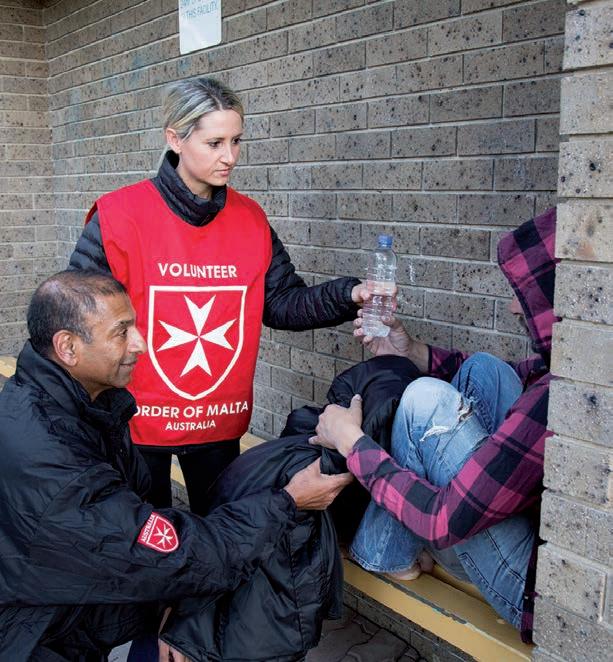
If you would like more information about leaving a bequest to the Order of Malta, please email info@orderofmalta.org.au
with the history of the Order through a dedicated website. is was developed through the energy and initiative of Associate Professor Darius von Guttner Sporzynski, a European member of the Order at ACU’s Canberra campus, with the assistance of Confrère Scott Samson. We look forward with anticipation to experience the results of the project. It should be a great help in assisting members to learn more about our history.
Unfortunately, two of our former presidents and much-loved confrères, Dr Ian Marshall and David Jackson AM, KC, died during the year. eir obituaries appear elsewhere in this magazine.
Our rst president, however, Confrère e Hon Dennis Mahoney KC, achieved the 50th anniversary of his membership on 6 December 2023. It is so encouraging to see that he retains a continuing interest in the life of the Order.
Finally, may I extend my thanks to the members of the Executive Council. It remains a very harmonious body working energetically for the advancement of the Order.
e Hon James Douglas KHD (Ob) KC President Australian Association of the Sovereign Order of Malta
A BEQUEST TO THE ORDER OF MALTA IS TO GIVE HOPE TO THE FUTURE
Your support can make a real difference to those who need it most.
The Order of Malta has been serving the sick and the poor for over 900 years. By making a bequest to the Order, you will help us continue this work.
The work of the Order of Malta to assist the sick, poor and suffering relies on the generosity and kindness of individuals who make donations. To expand and develop our work with confidence we need funds in place to finance our projects and respond rapidly to emerging needs.
Leaving a bequest is a way of giving that costs nothing during your lifetime. By making a bequest to the Order of Malta in your will you are ensuring we can continue to serve the sick and the poor for years to come.
Maxims of Blessed Adrian Fortescue, Patron of the Grand Priory of England, taken from his Book of Hours.
Adrian Fortescue was born around 1480, the son of Sir John Fortescue of Punsbourne, Hertfordshire, England. A cousin of Anne Boleyn, he was made a Knight of the Bath in 1503 and was held in favour by King Henry VIII, taking part in the Wars of England against France in 1513 and 1523. Widowed once and married twice, he had seven children. In 1532 he was received as a Knight of Devotion into the Order of Saint John of Jerusalem, of Rhodes and of Malta. In 1539, he was obtained for high treason without trial by an act of Parliament which condemned y persons who opposed the ecclesiastical policies Henry VIII. He was beheaded on Tower Hill, London, on 9 July, together with e Venerable Sir omas Dingley, a Knight of the Order of Saint John of Jerusalem. e Order of Saint John of Jerusalem has considered Sir Adrian to be a martyr of the Order and has promoted devotion to him at least since the early seventeenth century. Pope Leo XIII declared him Blessed on 13 May 1895.
Above all things love God with all my heart. Desire His honour more than the health of thine own soul. Take heed o en with all diligence to purge and cleanse thy mind with Confession, and raise thy desire or longing from earthly things.
Be you houselled (receive Communion) with entire devotion.
Repute not thyself better than any other person, be they never so great sinners, but rather judge and esteem yourself most simplest.
Judge the best.
Use much silence, but when thou needs must, speak. Delight not in familiarity of persons unknown to thee. Be solitary as much as is convenient with thine estate. Banish from thee all judging and detraction, and especially from thy tongue.
Pray o en.
Also enforce thee to set thy house at quietness.
Resort to God every hour.
Advance not thy words or deeds by any pride. Be not too much familiar, but show a serious and prudent countenance with gentleness. Show before all people a good example of virtues.

Be not partial for favour, lucre or malice, but according to truth, equity, justice and reasons.
Give fair language to all persons, and especially the poor and needy.
Also be diligent in giving of alms.
In prosperity be meek of heat, and in adversity patient. And pray continually to God that you may do what is His pleasure.
Also apply diligently the cooperations of the Holy Spirit whatever thou hast therein to do.
Pray for perseverance.
Continue in awe of God, and ever have Him before thine eyes.
Renew every day thy good purpose. What thou hast to do, do it diligently.
‘Stablish thyself always in well-doing. If by chance you fall into sin, despair not; and if you keep these precepts, the Holy Spirit will strengthen you in all other things necessary and, thus doing, you shall be with Christ in heaven, to whom be glory, laud, honour, and praise everlasting.
Blessed Adrian Fortescue, pray for us!






Professor David Kissane, KGCMG (Ob) reports on e Subpriory of e Immaculate Conception.
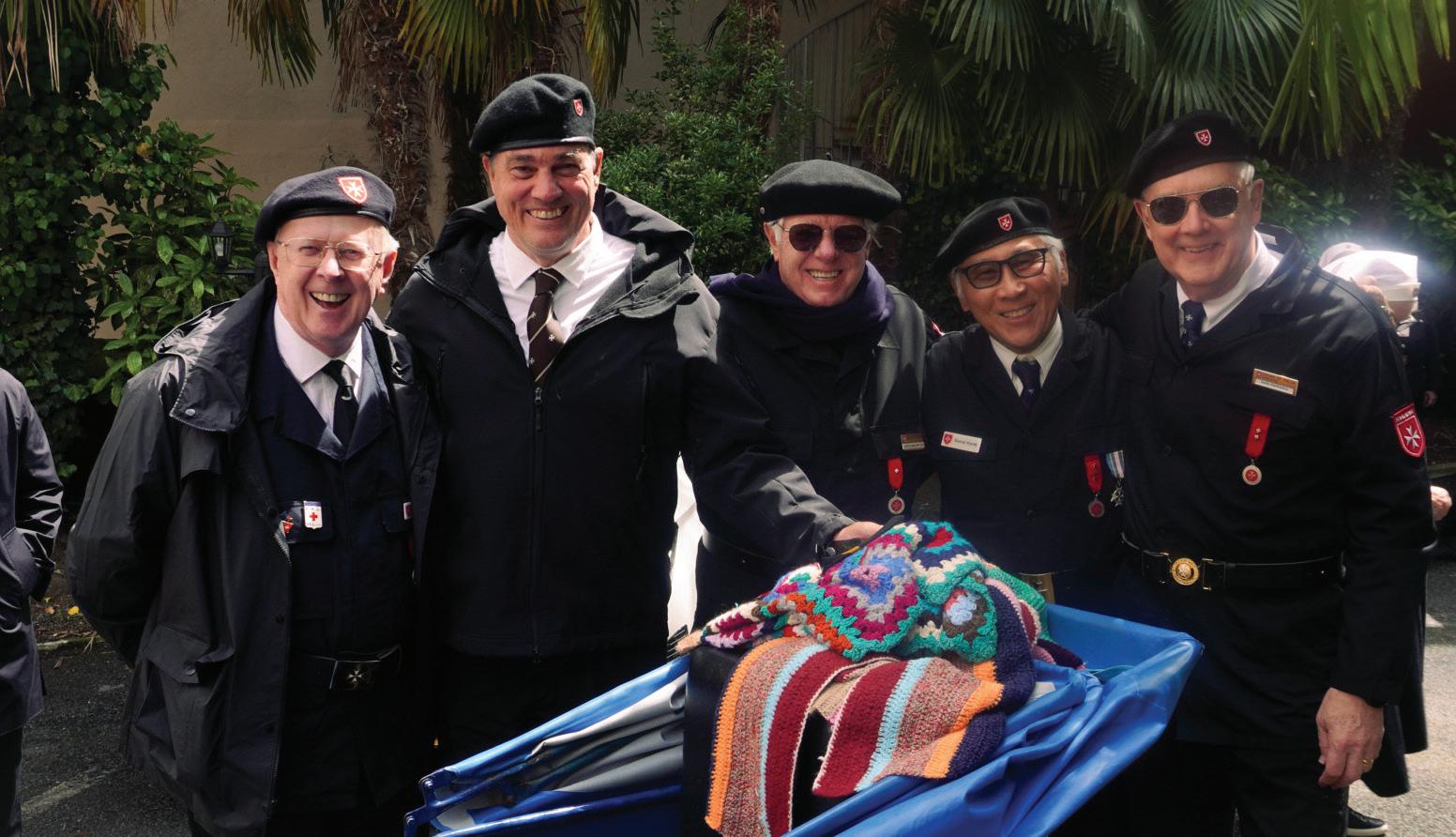
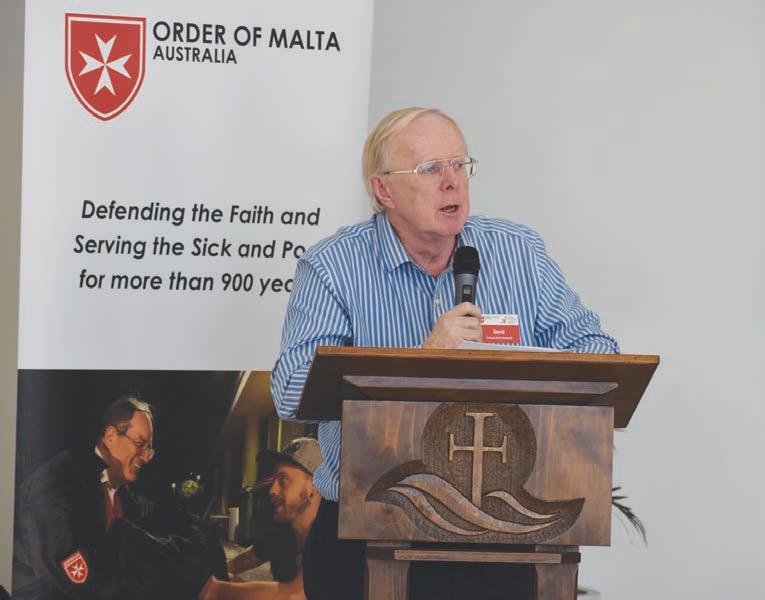
The Subpriory strives to promote a deeper spirituality and nurture the formation of members across our Associations. In the Asia Paci c Region, our members are drawn from the Order of Malta in Australia, Hong Kong, e Philippines, Singapore and ailand.
Members are active in the Hospitaller works of our Order and its liturgies, as well as striving to guide our ongoing spiritual formation through annual retreats, fortnightly Subpriory rosaries, monthly re ections by Chaplains and daily praying of the O ce and attendance at Mass.
Subpriory retreats were again well attended and occurred in three regions in 2023, expanding to four regions in 2024.
Constitutional Charter and Code and new Grand Master
e new Constitutional Charter and Code placed our Professed Knights at the heart of our fraternal life, with a call for at least three Knights of Justice in each Subpriory, thus creating a mission of growth and opportunity for our Order. is search for
new vocations is needed to preserve the religious heart of our Order. A new Council of the Professed now advises Sovereign Council in place of the old Government Council.
During early 2023, an Extraordinary Chapter General was convened in Rome to adopt the Constitutional Charter and Code promulgated by His Holiness Pope Francis on 3rd September 2022, and elect a new Sovereign Council. en, on the 3rd May 2023, a Council Complete of State was convened and elected His Most Eminent Highness, Fra’ John Timothy Dunlap (born April 16, 1957) as Prince and 81st Grand Master of the Sovereign Military and Hospitaller Order of St John of Jerusalem, of Rhodes, and of Malta. Born in Ottawa, Canada, His Most Eminent Highness is the rst Professed Knight from the Americas to be elected as head of the Order of Malta. A er taking his oath of o ce, HMEH spoke of making “a profound spirit of service and with the solemn promise of a constant commitment” to our mission of Tuitio Fidei et Obsequium Pauperum that unites us cohesively.
e other High Charges elected by the Chapter General included H.E. the Venerable Baili Fra’ Emmanuel Rousseau as Grand Commander, H.E. Professor Don Riccardo Paternò as Grand Chancellor, H.E. Fra’ Doctor Alessandro de Franciscis as Grand Hospitaller and H.E. Don Fabrizio Colonna as Receiver of the Common Treasure. Later in the year, the Holy Father appointed H.E. Gianfranco Cardinal Ghirlanda, SJ, as Cardinal Patronis.
ese profound changes to Our Order have ushered in an era where the Grand Priories, SubPriories and Associations have been invited to revise their Statutes to bring them into line with the CC & C 2022 and guide the Order forward with this renewed commitment to the spiritual life.
One of the changes to the new Code is that, a er a Year of Probation, members seeking to take their Promise of Obedience do so with an initial Temporary Promise for a term of three years, which can therea er be renewed for two further three-year terms before it can be made in perpetuity.
During 2023, ve members took their rst Temporary Promise of Obedience:
Consoeur Dr Maria Salvatrice RANDAZZO, Confrère Alastair James FURNIVAL, Confrère Anthony Frederick Laurence KROHN, H.E. Amb Confrère John Anthony Gerard McCARTHY, and Confrère Benjamin P. SARMIENTO of the Philippine Association all took Promises of Obedience on 24th June in the Mary Immaculate Church, Ashmore, in the State of Queensland. We congratulate them for responding to this call and becoming members of the Second Class.
Subpriory Council and Activities
e Council met quarterly throughout the year to review the needs and activities of the Subpriory and what help it could provide to our Associations.

Great support was provided by our Vice-Regent, Confrere Damian Benson, Our Chancellor, Consoeur Dr Jennifer Dunlop, Rosary Coordinator Confrere Anthoiny Gerada, Formation Guide Confrere Daniel Kwok and Consoeur Lilian Antonelli.
I am most grateful for the very willing and fraternal support of the Council as the Subpriory has grown. We also thank most deeply our Chaplains who have led retreats, celebrated the Eucharist, o ered spiritual directorship to members, provided Saturday morning re ections and done much to nurture and help our Order and Its Members. Our Patron, e Immaculate Conception, has been a constant support helping us to welcome the guidance of the Holy Spirit in all that we do.
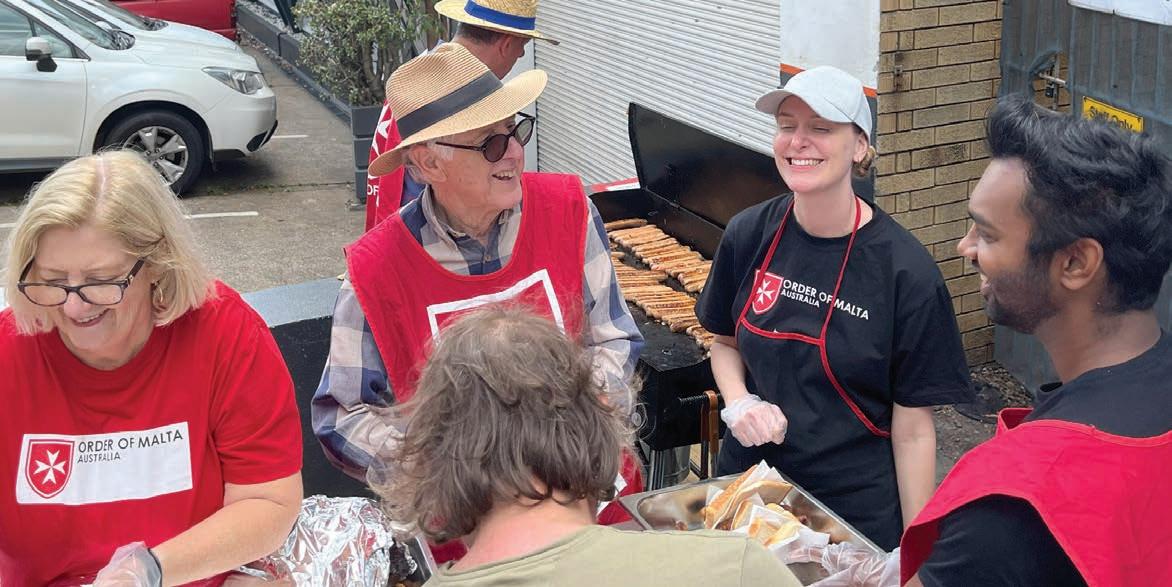
The North Eastern Region was active throughout 2023 in both hospitaller works and spiritual activities. Members, volunteers, and families have been keen to contribute to the many facets of Order endeavours.
Coats for the Homeless
e cooler months once again saw the coats program come into its own. e coats are making a substantial di erence to the comfort and well-being of members of society who are unable to nd suitable shelter. As 2023 turned cold, the cost-ofliving crisis has a ected the most vulnerable in our community. Increasingly we have families sleeping in cars because they must choose between rent or food. Older single women who have survived relationship breakdowns and, in many cases, have not had an opportunity to provide for their retirement are nding there is little support available.
e Order of Malta coats are welcomed wherever we have made them available. ey are recognised so much so that we have
individuals assisting in purchasing the coats and arranging distribution in areas where they have rst-hand experience of need. An example of this was a lady who was familiar with the coats and purchased eight cartons (96 coats) to distribute in a particular location in the Brisbane CBD.
While delivering coats to our partners at Fred’s Place in Tweed Heads run by the Lismore Diocese St Vincent de Paul Society, one of their clients recognised the Order’s shield with the eight-pointed cross. He was heard to say, “ ank God the good coats have arrived”.
Over 1000 coats were distributed by Order members, volunteers, and partners. We are especially grateful to Rosies Outreach Services “Your Friends on the Street” who assisted in getting the coats distributed throughout Queensland.
National Biennial Conference
e North Eastern Region had the privilege to host the 2023 National Biennial Conference in Brisbane and the Gold Coast coinciding, as is tradition, with the Feast of
Saint John the Baptist in late June. ree of the region’s four new members were invested in a Mass held in their parish at Mary Immaculate Church, Ashmore. One of the new members commented a er that the spirituality contained in the investment ceremony had been far more moving than they could have anticipated.
e Biennial Conference overall, but especially the liturgical events, were greatly enhanced by the presence of His Excellency e Prelate, Reverend Monsignor Jean La tte. Bishop Jean has become a close friend of the Order in Australia, and we thank him for his support and guidance.
During the Biennial program, Members were taken to view the site of the Proposed Southport Catholic Care Centre (SCCC) in Davenport St, Southport. is site has been purchased by the Southport Catholic Parish. Negotiations are well advanced for the Order of Malta to administer a centre dedicated to helping the disadvantaged people of the Gold Coast. e Centre will provide meals, clothing, showers, and laundry facilities. It is scheduled to open in the second half of 2024.
Special thanks are extended by the North Eastern Region to volunteers from the Southport Catholic Parish for their contribution to the National Biennial during our working session at Labrador, the SCCC site visit and the Investiture Mass.
Emmanuel City Mission (ECM) roughout 2023 on the second and fourth Sundays of each month, Members and volunteers have provided dedicated service to ECM’s guests. ECM is an outreach program by the Emmanuel Community of the Archdiocese of Brisbane to disadvantaged people in inner city Brisbane.
e Order of Malta has become the reliable partner ECM has come to trust, serving breakfast, and cooking up a lunch barbeque. We assist with providing clothing but most importantly we are there to listen and o er acceptance for people who everyday feel society excludes them.
Members and volunteers have been generous in answering the call to attend ECM for several special events during 2023. In response to Pope Francis’ World Day of the Poor, we served a special breakfast with a few extra treats. Members also provided donations of men’s and women’s underwear. Hundreds of items were donated allowing guests some basic dignity. Christmas Eve saw members and volunteers assist in providing a celebratory lunch. A special breakfast was also provided on Christmas Day with a wonderful atmosphere of joy on a day that can be di cult for so many.
Towards the end of the year, the Order’s partnership was enhanced by the arrival of the very popular “Order of Malta” aprons and the muchwelcomed “Order of Malta” awning.
Emmanuel Community members and their guests are asking so many more questions about our Order. We take great pride in speaking of e Order’s activities and spirituality, not just in our region, but throughout Australia and the World.
During 2023 the North Eastern Region’s muchloved member Confrère Dr Ian Marshall AM AE KC*SG GCM (Ob), passed to eternal life. Ian was for so many years the personi cation of the Order of Malta in our region. His service as Queensland State President was an important time for our members. He is remembered for his love and respect for the Order, his depth of knowledge of its history and customs and his enthusiasm to share this. We also thank Ian’s wife Judith who was a wonderful friend to our Order and support for Ian.
e 6th of June allowed members to remember Confrère Ian and Confrère David Jackson in a Memorial Mass as past national presidents. e
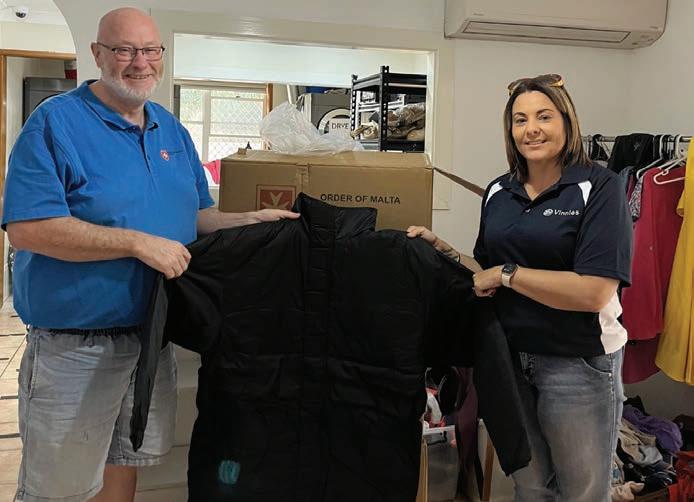

traditional Memorial Mass for all deceased members of our region was celebrated in November. Conventional Chaplain Ad Honorem, Bishop Ken Howell was appointed by e Holy Father as Bishop of Toowoomba in 2023. Bishop Ken granted the Order of Malta the privilege of attending the Installation Mass at St Patrick’s Cathedral on the 11th of July.
e Order is active in the Toowoomba Diocese through the Coats for the Homeless Program. We look forward to working with Bishop Ken to nd opportunities for the Order to commence hospitaller works and encourage membership in our fraternity.
Le
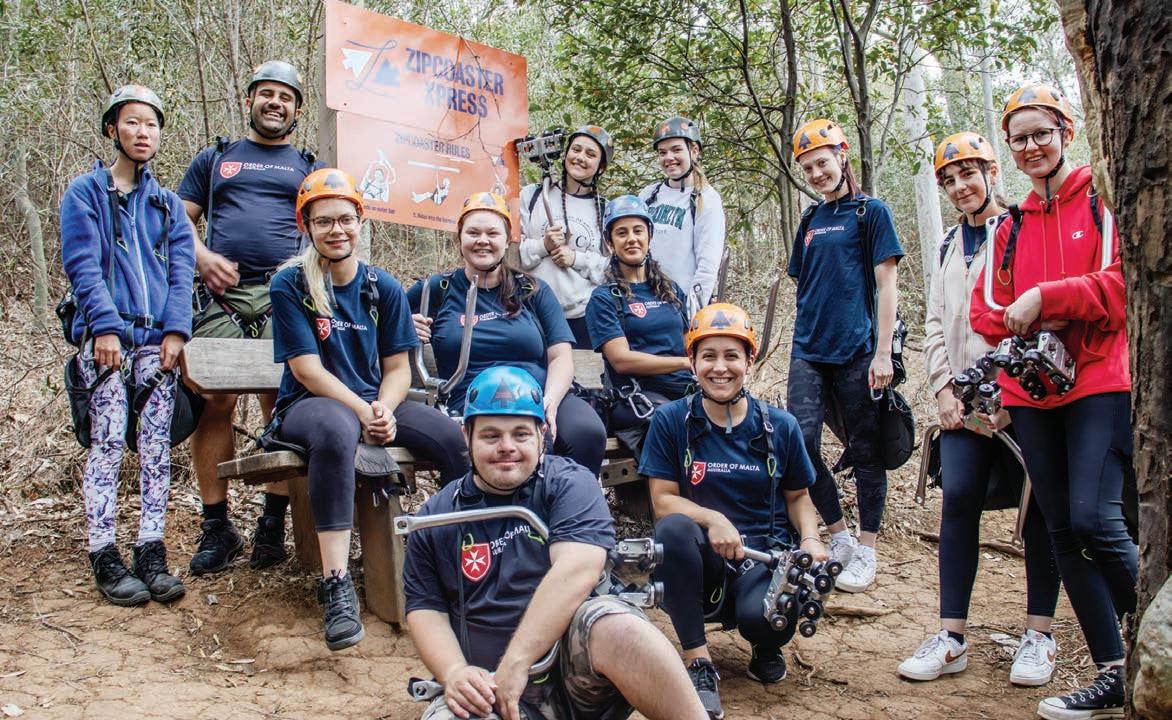
During 2023, the Members of the Central Eastern Region consolidated and deepened our various charitable and spiritual works, in what was the rst full calendar year without the COVID-19 restrictions impacting us in any way. We were truly blessed for a wonderful year of growth and opportunities.
As is well known, Members of the Order of Malta make two key undertakings:
• to care for our Lords the poor and sick; and
• to defend the Catholic, the Apostolic and the Roman Faith against the enemies of religion.
In 2023, the Central Eastern Region continued to discharge these, our duties, through our works and through public proclamations of our Catholic faith.
Our Works
e Members of the Central Eastern Region undertake a wide range of charitable activities. Whether it’s giving out “Coats for the Homeless” for those in need in our local neighborhoods, distributing food and other supplies to the less well o , or simply performing ad hoc works of mercy as the need arises – for example, raising funds when natural or man-made disasters strike in Australia or around the world. However, our main organised and scheduled activities are our Community Care Kitchen, our Community Care Vans and our Camps for disabled youth.
Bondi Community Care Kitchen
e Bondi Community Care Kitchen (“BCCK”) celebrated its 2-year anniversary in December 2023. e
BCCK is now a well-loved part of the local community in Bondi, providing a nourishing meal with tea, co ee and desert for all those in need in the local area. Typically serving between 20 and 30 guests every single Wednesday evening throughout the year, the kitchen is sta ed by Order Members and Volunteers who travel from all over Sydney to be part of this growing and tight-knit community of guests and volunteers.
Our Chaplain Fr Anthony Robbie, the founder of the BCCK and Parish Priest of St Patrick’s Bondi which hosts the Kitchen, opens the meal with grace and then rolls up the sleeves of his priestly garb to serve the guests, help wash up or, quite regularly, to provide guidance to some troubled soul. Guests of the BCCK truly receive the best Catholic charity can o er.
Darlinghurst and Parramatta Community Care Vans
e Central Eastern Region runs two Community Care Vans; one from Darlinghurst – run by Confrère Tom Cutler, which covers the inner-city areas; and one from Parramatta – run by Confrère Neville Zammit, which covers Western Sydney. Both Vans are sta ed by a small army of Members and Volunteers, who use the Vans to reach out to the vulnerable of their respective areas and provide them with much needed coats, supplies and other care. Work has begun on expanding the reach of our activities in Western Sydney, where there is so much demand. Further, the Darlinghurst Van is periodically driven to Newcastle by Confrère Mark Dorney so that its services can be provided to the needy in that ever-growing regional city.
Following last year’s successful Youth Camp for disabled young adults and teenagers, which the Central Easter Region hosted at the Pope Benedict XVI Retreat Centre at Grose Vale, our National Hospitaller Confrère John Murphy organised for a National Youth Camp to be held at the same venue in November 2023. e Camp was again wildly successful, with Members from other Regions joining Central Eastern Region Volunteers and Members to help the guests and to run the Camp. Special thanks goes to our Chaplain Fr James McCarthy, who again attended the entire Camp and o ered Mass for the Camp participants.
For ordinary Catholics like our Members, defense of the Catholic Faith today In Australia starts with simply being Catholic in public and doing so as a group. Providing support to each other and not hiding the light of our precious Catholic faith under a bushel. We must proclaim the Faith, by our actions and by our words.
To that end, in 2023 the Central Eastern Region continued to engage in programs of deeper spiritual formation, of prayer and acts of reparation as part of, and so as to continue to strengthen us for the battle of defense of the Faith. For example, we together prayed a Novena to Saint Michael in reparation for 2023 Sydney World Pride activities, which will serve as a template for similar activities in the years ahead.
Our 2023 retreat, again held in conjunction with the Sub-Priory of the Immaculate Conception at the Mount Carmel Carmelite Monastery at Varroville, emphasised the importance of standing together and supporting each other in publicly proclaiming the one true Faith.
We again marched in both the Archdiocesan Corpus Christi procession and march for the Day of the Unborn Child. ese processions and marches are
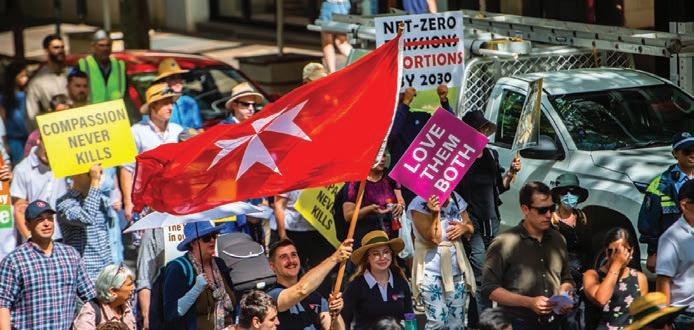
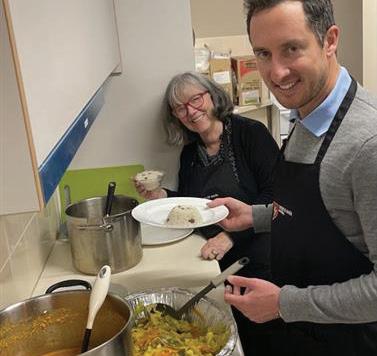
now an integral part of our annual Calendar.
We again o ered Mass to celebrate the Feast of Blessed Karl of Austria, an honored Member of the Order of Malta and a Saint whose popularity continues to grow around the world as an example of a noble Catholic leader in contrast with today’s growing disillusionment with our current leadership class and their non-Christian world views.
Finally, in addition to many public Masses held throughout the year, our 2023 Lourdes Day Mass o ered by our Conventual Chaplain Ad Honerem Archbishop Anthony Fisher, was the biggest and best it has been in recent years. We plan to continue to grow this event in the years ahead as it represents the best the Order has to o er: participation in the holy sacri ce of the Mass, helping the sick and at the same time providing spiritual healing and a public witness to the Faith.
In conclusion, 2023 was a wonderful year for the Members of the Central Eastern Region. We had ample opportunities to discharge our duties to care for our lords the poor and the sick, and to defend the one true Faith. Deo gratias!
Bottom
OOn behalf of the Regional Council of the South Eastern Region, it is with great pleasure and profound gratitude that I present this report to our members, volunteers, and all those interested in the hospitaller and spiritual endeavours of the Order of Malta.
Lourdes Masses in Aged Care
Our initiative to bring Lourdes into local communities involves organising and conducting special Lourdes Masses within Catholic aged care homes across the South Eastern Region.
Held monthly, these Masses see participation from six or seven dedicated members of the Order, along with a Chaplain. Typically, between 30 to 40 residents attend each Mass, engaged and upli ed by the Blessing of the Sick. Additionally, our members provide a more personalised spiritual service by visiting 10 to 15 bedbound residents in their rooms, o ering them Communion and the Blessing of the Sick over them. is personalised approach ensures that all who wish to participate are included, regardless of their physical mobility or health conditions.
Coats for the Homeless Program
In Melbourne, this initiative is spearheaded by dedicated members of the Order alongside a committed team of student volunteers from the Australian Catholic University (ACU) and Newman College at e University of Melbourne. Each winter, our teams engage directly with the city’s homeless population—especially rough sleepers—encountering up to 100 each night. e program operates consistently on Tuesday and ursday nights, facilitated by two to three members of the Order and three volunteers per session. Beyond the physical distribution of coats, our program emphasises the importance of personal engagement.
Order of Malta and Eastern Palliative Care
Members of the Order actively participate in EPC’s award-winning volunteer program, which includes a variety of supportive roles
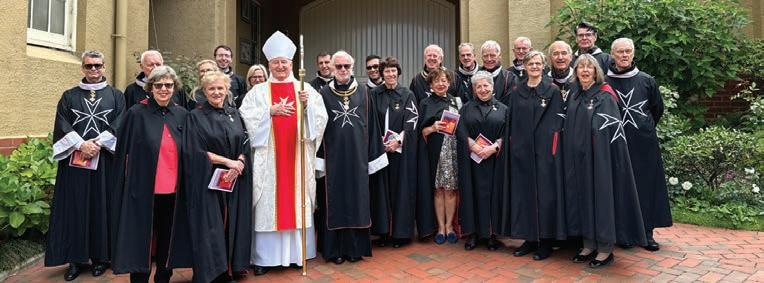
tailored to enhance the quality of life for clients. A standout initiative is the Biography Program, where members assist clients in documenting their life stories.
Our members’ engagement extends beyond administrative support; they are directly involved in the compassionate care of individuals, embodying the Order’s charism of service to the sick. .
Feast of Our Lady of Philermos and Mass for the Faithful Departed
e Mass was a profound expression of our heritage and devotion, followed by a congenial morning tea hosted by Newman College. A particularly memorable moment was the presentation of the Grand Cross “pro piis meritis” pro Merito Melitensi to Father Gerald O’Collins AC SJ, in recognition of his extensive service to the Church, the Order and the Australian Subpriory. Father O’Collins’ contributions have been instrumental and honouring him re ected the deep gratitude felt by all.
Our Mass for the Departed, aligned with the Feast of All Souls, provides a solemn opportunity to re ect on and celebrate the lives of those members and their families who have passed. Held on Sunday, 5 November at the Carmelite Monastery in Kew, this gathering was marked by reverence and remembrance, again attended by two dozen members.
Monthly Vigil Masses
Held at the Carmelite Monastery in Kew on the ursday evening preceding the rst Friday of each month from February
through December, these gatherings o er a re ective pause from the daily hustle and serve as a vital link in strengthening our commitment to our shared values and missions.
Following the Mass, members are encouraged to gather for a meal at the Elgin Inn nearby. is transition from a formal spiritual gathering to an informal social interaction is seamless and signi cant, fostering camaraderie and allowing members to engage in personal discussions and shared experiences. ese dinners are as much a part of the tradition as Mass attendance and play a critical role in building a supportive community within the Order.
e South Eastern Region has been organising an annual Lourdes Day Mass since 2000. is Mass is speci cally designed as a healing service and has grown from smaller venues to the signi cantly larger St Patrick’s Cathedral, re ecting its increasing importance and community reach.
e Lourdes Day Mass is the most visible public event organised by the Order in the region, consistently attracting over 2,000 attendees each year. e event’s success is bolstered by substantial support from the Church hierarchy, including Archbishop Comensoli, the chaplains of the Order, and the Vicar-General’s o ce. is strong ecclesiastical backing highlights the event’s signi cance within the wider Church community and underscores the Order’s position within ecclesiastical and societal circles.
Order of Malta and ACU Community Hub collaboration
Since the establishment of the “community hub” program in 2022, the Australian Association of the Order of Malta and the Australian Catholic University (ACU) have fostered a pioneering partnership. is initiative, developed through a memorandum of understanding, aims to implement a series of engagement initiatives designed to assist and upli groups experiencing disadvantage and marginalisation within our society.
e Mobile Community Cafe, situated in the heart of the Agg St public housing estate in ornbury, has become a pivotal community engagement initiative over the past eighteen months.
e cafe operates every Tuesday morning, creating an inviting space at the community centre where residents can gather to enjoy a cup of co ee, snacks, and warm social interactions. is weekly event is strategically timed to coincide with SPAN’s delivery of fresh and packaged food, drawing a larger crowd to the community centre and encouraging residents to engage more deeply with one another and the services available.
Mercy Community Palliative Care Initiative
e working group for Mercy Community Palliative Care has been instrumental in orchestrating volunteer activities that serve the western parts of our city.
At the close of 2023, Mercy Community Palliative Care had 41 volunteers, a number that is small compared to the 220 volunteers at Eastern Palliative Care, covering a similar geographic scope. is disparity highlights a signi cant opportunity for growth, particularly as most of Mercy’s volunteers are located around the inpatient unit at Werribee Hospital, with very few in the densely populated inner regions.
To address this, in early 2024, members of the Order, following introductions by Vicar General, Very Rev. Joe Caddy, conducted a series of talks at local parish masses to appeal for new volunteers. ese e orts resulted in the successful engagement of local communities at parishes including Strathmore, Moonee Ponds, Sunshine North, St Albans, Kings Park, and Melton. Additionally, a targeted training program was initiated by Jim Creaner in Kings Park, which trained 12 new volunteers, with 25 more awaiting future sessions. e plan to expand this volunteer base continues with more parish appeals scheduled for the third quarter of the year.
Calvary Kooyong Volunteer Services
e collaboration with Calvary Health Care to develop a volunteer service capable of delivering a wide range of palliative care services is chaired by Anthony Reeves. is partnership has already seen the recruitment of

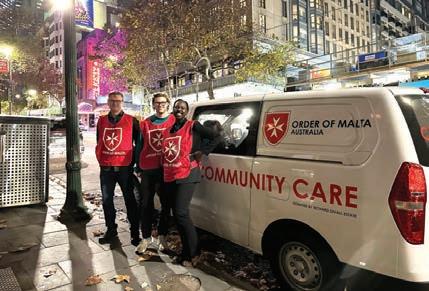
seven members of the Order and 60 other volunteers who have made signi cant contributions to the lives of palliative care clients. is team’s presence and support through such a critical and vulnerable part of the clients’ lives have been invaluable.
Looking ahead, we have set ambitious goals for the next 12 months to further increase the involvement of the Order’s members and to develop additional volunteer programs that can further enhance the services provided to palliative care clients.
Annual Film Fundraiser
e Annual Film Fundraiser has consistently been a signi cant event for the South Eastern Region, bringing together members of the Order for a shared a ernoon of lm and fellowship. is gathering not only strengthens our community bonds but also plays a crucial role in generating additional funds needed for EPC to extend its services beyond the limitations of government grants.
Historically, this event was adeptly organised by Lady Gobbo, who skilfully balanced the proceeds to support both the Order’s involvement with the East Timor medical clinic and EPC. Over the years, these lm events have successfully raised approximately $25,000, which has signi cantly contributed to both causes.

Founder Blessed Fra Gerard was prophetic in his re ection that Our fraternity will last forever because the soil in which it is rooted is the misery of the world, and — if it should please God — there will always be those who will labour to reduce su ering and make the misery of the world more endurable.
In his Encyclical Fratelli Tutti, on October 3, 2020, Pope Francis invited us to re ect on Saint Francis, who expressed the essence of a fraternal openness that allows us to acknowledge, appreciate and love each person, regardless of physical proximity or where he or she was born or lives.
In 2023, Members of the Order of Malta humbly o ered prayers, works and support to those in need and su ering across the globe.
South Australian Confrere Maurice O’Connell visited war-torn Ukraine throughout 2023. His hands-on support of war victims, his courage and humility resonated with Blessed Gerard’s calling and that of the Prophet Micah 6:8 to act justly, love faithfully, and walk humbly with God
Our members in South Australia supported the Order’s Coats for Homeless Project. In August 2023, 36 coats were distributed among grateful recipients who visited the Adelaide Day Centre. Coats
were delivered to Hutt Street Homeless during their breakfast program to over 40 attendees. In Western Australia, coats were distributed as far away as Kalgoorlie, with Simon Transport and St Vincent De Paul assisting with the 600km journey from Perth.
Members of the Southern Central Region sincerely thank all who donate generously to the Coats for the Homeless on behalf of the coat recipients. We especially thank our National Hospitaller Confrère, John Murphy, who generously assists with logistics and prayerful support. We pray this article will a rm our generous sponsors and Order members who work tirelessly behind the scenes to make coat delivery possible.
Confrère Henry O Connor served the sick and poor by assisting with Fred’s Van, a service that prepares and serves meals for the homeless. Confrère Andrew Cichy in Western Australia worked generously with St omas More College volunteers, distributing care packages to people in need. Care packages were also distributed in SA, and members will assist with Christmas hamper preparation.
Order members are “obliged to work on and deepen their spiritual life continuously”. (Regulations and Commentary V). In 2023, members
committed to spiritual development through Mass, retreat, re ection, and monthly participation in national online rosaries and re ections.
On 13-15 October, members gathered for three days of retreat, re ection, prayer, and spiritual direction at the Sevenhill Centre of Ignatian Spirituality led by Father Rob Morris SJ. Our gratitude is extended to retreat organiser Consoeur Mary Kennedy.
A special mass in the home of Chaplain Fr Allan Winter was held in May in Memoriam of our departed former National President Confrere Ian Marshall. Our service to the poor and sick is, as it should be, a humble, o en hidden service. ere are occasions, however, when our ministry is public, not for self-grati cation but to promote the Order and attract new membership.
Knights and Dames of the Order in SA led the 2023 Marian Procession on Sunday, 21 May. e Marian Procession began in 1949 and is Australia’s longest consecutive Catholic event. is year, the Procession celebrated 74 years and over 2,000 people processed through the streets of Adelaide. A re ection in the Southern Cross Catholic
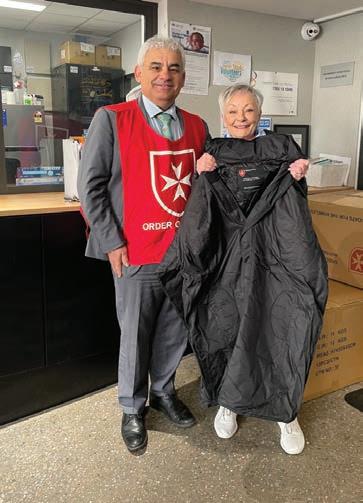

newspaper re ected that the simplicity has always been and will remain in the gathering, praying the rosary and coming together in community to be a public witness of our Catholic faith.
In February, members attended the Lourdes Day Mass at St Francis Xavier Cathedral and distributed Lourdes water to the sick and dying. As Regional Hospitaller, I spoke to the congregation about the history and works of the Order. I also shared a personal re ection on my pilgrimage to Lourdes as a member of the Order. Confrère Michael Shanahan in WA assisted with awarding the Order Sponsored University of Notre Dame Australia Goodie Bioethics prize in Western Australia. On 22 October, many parishes in the Adelaide Archdiocese published an article on the history and works of the Order to celebrate the Order of Malta World Day on 14 October.
Our regional chaplains, Fr Allan Winter and Monsignor Kevin Long, serve the Order and its members with great humility. In SA, Fr Alan led each monthly meeting with a Gospel re ection and generously opened his home and heart for members to celebrate Mass. Monsignor Long supports the Order in WA through prayer; his connection with Notre Dame University is also invaluable. An online meeting was also held with the University of Notre Dame sta members, National President Confrère James Douglas and former Vice President Consoeur Michelle Campbell, to encourage membership to the Order.
On 11 November, 2023, our much-loved South Australian Chaplain, Monsignor Robert Aitken, passed away into God’s loving care. Members of the Order attended the funeral Mass at St Francis Cathedral on 24 November, 2023. In a letter to our National Executive, I wrote:
It was with great sadness that I was informed of the passing of our dear Chaplain and friend, Monsignor Robert Aitken.

Monsignor joined the Order of Malta in 1975. He served faithfully as our Chaplain, leading us in Mass, guiding us in prayer, rosary and spiritual re ections and sharing in the works and life of the Order in fullness.
e Monsignor was a gentleman and gentle man of immense compassion and faith who profoundly in uenced my life and the lives of all members of the Order of Malta. He undertook the role of Order Chaplain with great sincerity, dedication and love. His passing is with deep sadness and great joy for having known and loved this humble servant of Our Lord.
Monsignor Robert Aitken’s life and the Order’s work in 2023 were faithful to Blessed Fra’ Gerard’s call to reduce su ering and make the world’s misery more endurable. I o er this report to God in thanks to Monsignor Aitken and to all members, volunteers and supporters of the Order who resonate with the Gospel challenge to love one another:
“ en the King will say to those on his right, ‘Come, you who are blessed by my Father; take your inheritance, the kingdom prepared for you since the creation of the world. For I was hungry and you gave me something to eat, I was thirsty and you gave me something to drink, I was a stranger and you invited me in, I needed clothes and you clothed me, I was sick and you looked a er me, I was in prison, and you came to visit me.’ Matthew 25
From le to right: Members of the region participating in the yearly retreat at the Sevenhill Centre.
Regional Hospitaller being active in the Coats for the Homeless program.
Members attending the Lourdes Day Mass at St Francis Xavier Cathedral.
Top right: Monsignor Robert Aitken.
During the 2 year period from the beginning of 2022, the Region has been working to extend the scope of service to our Lord’s the poor and sick in the NT. e members and volunteers’ consistency and commitment in serving those who live at the margin of NT society have become an expression of compassionate Christian love. So de ned, the service is delivered in a manner that respects the dignity of those we have the privilege to serve.
Distribution of Coats and Blankets to the First Nations People in Alice Springs and Santa Teresa
Several members and volunteers have delivered coats and blankets in Alice Springs and Santa Teresa to local First Nations People. In addition, some members have travelled out to Hart Range for distribution. Hart Range is located 210km northeast of Alice Springs and the weather at this time of the year is characterised by dry cold nights and cool days. e donations have been well received.
Hygiene pack distribution, donation of playground equipment and Day of the Poor celebration
e distribution of hygiene packs and the donation of playground equipment to several First Nations women’s shelters in remote communities in the NT have been coordinated with Charles Darwin University, via the direct involvement of one of our volunteers. Further, on the Day of the Poor, dignity bags— lled with sanitary products: sanitary pads, shampoo, toothbrush, toothpaste, deodorant, soap as well as small towels and socks—were gratefully received by the most marginalised of our brothers and sisters in Santa Teresa, Alice Springs and Darwin.
e intergenerational sewing project in Santa Teresa
e intergenerational sewing project aims at providing a safe space at the Spirituality Centre in Santa Teresa, where First Nations Arrernte women can strengthen relationships and work together in a sewing activity which enables elders to work with
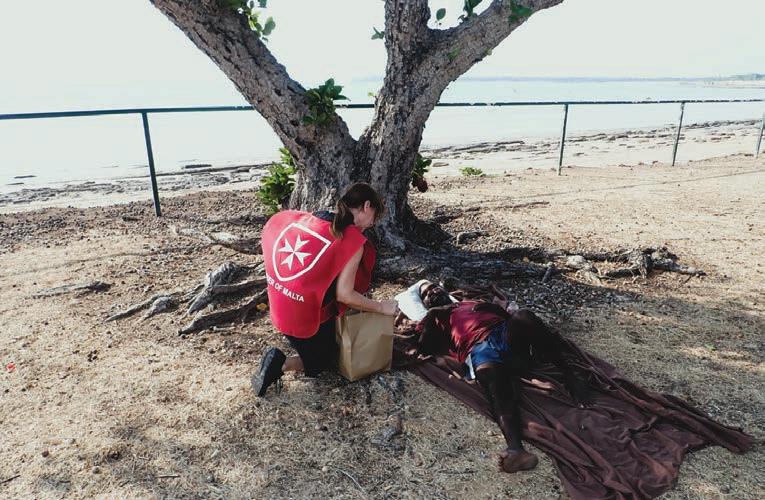
young women to reinforce the values of their cultural paradigm. A member of our Region is coordinating the project, while the Northern Region is providing sewing material and equipment. Intergenerational sewing workshops are run over a threeweek period for younger and older ladies to design and create products together within a safe and welcoming workshop environment for young women, which facilitate interaction with older family members and give them an opportunity to spend some quality time together. Further, the selling of the products can provide income for participants.
Monthly food service-compassionate outreach to homeless e program is designed to deliver a nutritious meal to a diverse group of people living rough, usually camped in bushland on the edge of the city or in the park areas where many of the homeless camps are. ey are o en found in places that makes them less visible to authorities or the public for a variety of reasons. As a result, they are not always easy to nd. By seeking out the homeless we o en
stop to ask them where they are from and what brings them there. eir life journeys deeply touch our hearts and as we serve and listen, we learn about lives de ned by courage and resilience.
A wide variety of people can be found living rough: First Nations People from remote communities, who are visiting Darwin and have nowhere to stay, o en escaping violent situations in their communities; impoverished people, without any, or at least very little, income, who are unable to change their economic situation on their own, either because of geographic location, lack of technical skills or by holding outstanding debts which cannot realistically be paid in full; ‘hidden’ homeless, who are not physically without shelter, but do not have a permanent home; mentally ill and handicapped people, who have a medical condition which prevents them from being able to adequately support themselves. In addition, occasionally, we serve ‘seasonal’ homeless, who are those with seasonal employment, such as farming jobs, or those a ected by natural disasters and the occasional runaway. ese men and women had homes and a su cient living
resource, but due to circumstances beyond their control, they have lost or were forced to give up their physical possessions. e seasonal homeless generally are seen as able to recover from their situation when provided with aid and time.
Sam’s re ection on his experience of sleeping rough in the NT is emblematic: “My life on the street is living in a ‘I do not know’ dimension: you feel powerless as you don’t know what’s going to happen next. You’re at the margin, with no material and spiritual resources, only a step away from falling into an abyss of cold, endless darkness, vulnerable to physical, emotional, and psychological abuses”.
Last year, the North-Central Region has extended the reach of the food service to the homeless living rough in Palmerston, a satellite city of Darwin, situated approximately 20 kilometres from Darwin and 10 kilometres from Howard Springs and the surrounding rural areas. For this purpose, 100 meals are prepared and two teams, including members and volunteers, distribute food in both the Darwin City and Palmerston regions on the same day. As part of the Christmas distribution, we also included a sanitary pack.
e members are assisted by a dedicated and compassionate team of 15 volunteers. e Region would like to recognise and thank the volunteers who assist the members of the Order with the meal preparation and distribution. Without their assistance the service would be restricted.
Spiritual retreat
e annual retreat was led by Chaplain Emeritus Bishop Eugene Hurley. e theme of the retreat was based on the Encyclic Amoris Laetitia and members and volunteers were gi ed with a powerful re ection by Bishop Hurley on how the Church must be an expression of the merciful, compassionate, and unconditional love of the Heavenly Father.
Defence of Faith
Contribution to the Unity and Yarning
Confrère Paul Maher makes regular contributions to Unity and Yarning, via a series of articles entitled “CHURCHBITES”. One of Paul’s Articles greatly contribute to divulge the presence of the Order in the NT. e Unity Magazine is a quarterly publication by the Catholic Diocese of Darwin, while Yarning is the online diocesan monthly newsletter.
Two members of the Region serve in the Diocesan Voluntary Assisted Dying Reference Group (‘ADRG’) and are assisting the Group in the analysis of the proposed NT VAD framework and dra ing written submissions to the NT VAD Expert Committee.
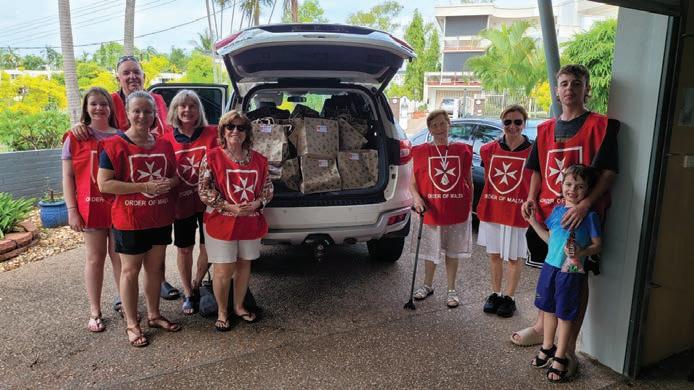

e service is targeted to assist the most vulnerable and marginalized in the NT. It is aimed at promoting social justice and to defend the sanctity of life and human dignity. Mainly, the service provides administrative assistance with ling and submissions of application (mainly in the eld of migration and minimum age pension) to old, unwell, poorly educated, illiterate and migrants. Social support is also provided, through referral to a formalised network of governmental and Catholic Agencies, such as Centrelink and CatholicCareNT.
e Northern members and volunteers have been very active in the community caring for some of our most disadvantaged First Nations poeple, taking on a wide variety of new projects and initiatives.

Year 2023 shall be remembered as the year of change as the Order of Malta Korea (OMK), had its rst major leadership change since its foundation in April 2015. Our founding president Silvano Yongmaan Park resigned a er serving OMK for 7 years and Francisco SK Lim took over the role as our second president in unanimity. Taegon Andrea Kim is the new Chancellor, replacing Francisco’s previous role, while eresa is now replacing Taegon Andrea’s previous role as a Treasurer, followed by William YI Shin who is replacing eresa’s previous role as an Auditor. Veronica’s role as a Hospitaller remained, given that 2023 is the year OMK hosts Asia Paci c Conference in Seoul, Korea for the second time.
is decision was made along with other directional decisions during OMK’s 2023 General Assembly held in March, where the members agreed on the needs to; 1) meet on a regular basis with spiritual purpose, and 2) strengthen our spirituality as a group to regain intimacy and sense of community a ected by the long-lasting COVID-19 years. We were blessed with a new member, Andrea KH Nam, who was formally approved by the Sovereign Council in October, but also
had two members leaving OMK before their investiture. is was alarming enough for the existing members to re ect on where we are, what we are missing and what to do next. Hosting an APAC event was a challenge even without such dilemma, however we decided to use this opportunity to bring the members closer back to the pre-COVID-19 time.
As discussed and decided, we quickly formed a preparation committee for 12th
APC, Investiture Mass in early spring and with the help of Confrère Daniel Kwok who assisted us every step of the way, we were able to not only pull o what felt like an impossible event, but also rea rm the spiritual bond which we once thought had weakened.
e 12th Asia Paci c Conference
From the 18th to the 22nd October 2023,
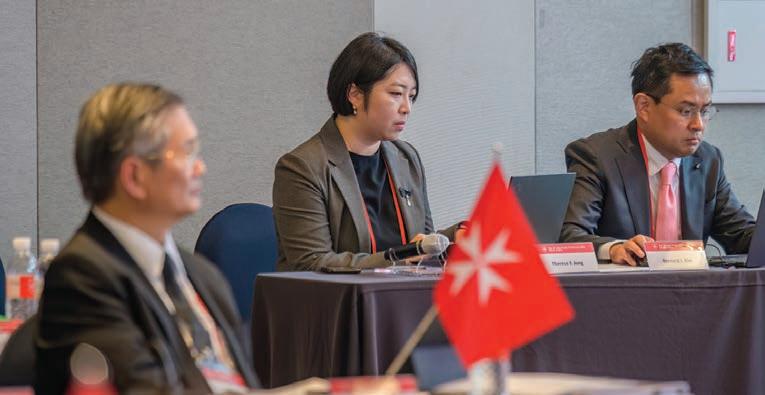
members of the Order of Malta Korea hosted 55 delegates for the 12th Annual Asia Paci c Conference of the Order of Malta. e event took place this year at May eld Hotel, Seoul, Korea.
Delegates from across the Asia Paci c region attended, as well as High Charges from Grand Magistry, H.E. e Grand Chancellor Ricardo Paternò di Montecupo, H.E. Receiver of the Common Treasure Fabrizio Colonna, H.E. and e Prelate Monsignor Jean La tte; and on behalf of e Grand Hospitaller Fra’ Alessandro de Franciscis, Ivo Granizni, Chief of Cabinet. ey were accompanied by Confrère Baron Eugenio Ajroldi di Robbiate, the Director of Communications and Mrs. Daniela Bonucci, the Chief of the Order’s Internal A airs Department. e theme of the conference was “Whatever you do for one of the least you do for me” and the agenda focused on priorities and plans at both a national and international level for both the Order of Malta’s charitable works and sustainability and developing as an Association of the Order of Malta.
Hosting a regional conference for the second time and also realising that this is the rst o cial event for OMK since the Korean government declared endemic in June 2023, the members of OMK contributed what they can with profound passion and devotion. It had allowed us to identify all kinds of talent, diversity and energy within us, also allowing us to grow into a much stronger team. Regardless of the end result, the sense of achievement reminded us of what brought us together in the rst place and naturally, where to head next. We gained perspective, courage and most of all, con dence.
Also, witnessing how the region has grown and developed over time, tirelessly helping the poor and the sick with such enthusiasm was inspirational. Speci cally in a sense that nothing, even wars and viruses can stop you, as long as you are doing God’s work, because He will show you the way. It was a humbling experience for us all, thanks to everyone who shared their focus and progress with great vision aligned with the Order’s charism.
In the evening of the 21st of October, following the 12th APC, OMK’s third Investiture Mass took place at Jeoldusan Martyrs’ Shrine Cathedral, presided by Cardinal Andrew Yeom Soo-jung. ree confrères and one consouer were invested, of whom two were our own. e ceremony was beautifully conducted at a historic location and we are especially grateful to the Australian team for their generous leadership and heartfelt friendship.
Following the Investiture Mass, we had yet another special event where our founding president Silvano YM Park, was given the award of Cross of Grand O cer

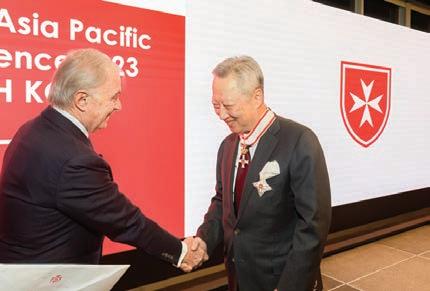
is was the rst time that an OMK member is recognised with an award of such honour, and we were happy to see his leadership being highlighted in that meaningful night.
Spiritual Formation
To strengthen our spirituality as a group, we met on the rst Sunday of every month for OMK Mass, carried out our bi-monthly bible study and held Spiritual Retreat with Fr. Marco Cho every quarter. When the new board was formed in April, we had an audience with H.E. Cardinal Andrew Yeom in May for his blessing, and once again in late October to thank him for his continuous love and support for the Order.
We started our own pilgrimage as a small group visiting mostly Jeoldusan Martyrs’ Shrine, hoping we can invite those in need to this enlightening experience. Re ecting on the history of the Catholicism in Korea and how the church is still perceived as the ‘religion of the poor’ in our country had encouraged us from the core, and this motivated our next project for 2024.
With a stronger team, we aim to start two to three new projects in 2024 that are e ective for those we support and feasible for those who desire to support. Whatever we do, our prayers will be the foundation we run on and we will look back on 2023 for inspiration if we ever feel challenged.
Le : Participants in the 12th Asia Paci c Conference.
Top right: Investiture Mass at the Asia Paci c Conference.
Bottom right: Founding President Silvano YM Park, was given the award of Cross of Grand O cer pro Merito Mlitensi by H.E. e Grand Chancellor Ricardo Paternò di Montecupo.
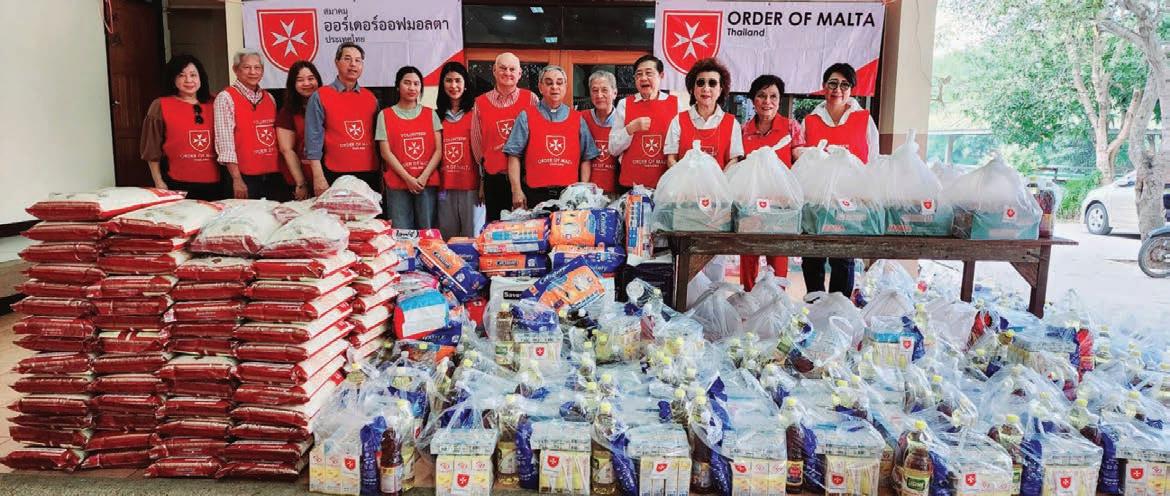
Current organisation
e Order of Malta ailand is truly blessed to continue God’s mission of strengthening the Order’s spirituality and services to the Sick and the Poor through the investiture of a Dame of Magistral Grace, Consoeur eresa Pringprao Sirisant. She had been appointed earlier in October 2018 and was invested in South Korea in October 2023.
Despite being primarily a Buddhistdominant country, we have overcome that barrier, and presently, our order consists of 32 people: One Magistral Chaplain, 17 ai Members, two International Members, two Aspirants, two Interested, seven Fulltime volunteers and 1 sta . Finally, we have successfully registered as an association under ai law. is enables us to work e ciently and comply with ai law & regulations.
Completed projects
e Elderly Care project was initiated by our late president, Dr. Maria esese Virachanee Promsunthorn, along with a 10,000 USD grant from the Global Fund for Forgotten People in 2022. ere were four sessions, and due to the COVID-19 epidemic, the rst session started late in June 2022, while the fourth session was completed early in 2023. rough this project,
we supported 155 elderly individuals living alone in Nakhon Nayok province, ailand. e activities consisted of two onsite seminars, two community visits, health assessments, and knowledge sharing for self-care at home, emphasising holistic health improvement in four dimensions: health, recreation, integrity, cognition and peacefulness. Additionally, practical elderly care training was provided to approximately 100 rotating volunteers.
Ongoing projects
Wheelchair project is project has been ongoing since 2016 and remains essential, as there is still a signi cant number of people with disabilities in need of wheelchairs. To ensure the distribution of wheelchairs to suitable individuals, we have sought assistance from the dioceses to assess the needs. is year, we provided a total of 96 wheelchairs to 10 dioceses nationwide. Since 2016, we have supported a total of 333 wheelchairs.
Blanket Donation
Although ailand is a tropical country, some areas experience cool and freezing weather during the winter season. Last winter, we
provided over 5,000 blankets to needy people in the northern and northeastern parts of ailand.
Slum Klong Toei visit
Additionally, many members, along with volunteers, visited residents of the Klong Toei slum to distribute ready-to-eat food, toys, necessary items, and share God’s love.
Spiritual formation
Monthly Formation
Our Chaplain, Fr Carlo Velardo, sets up spiritual formation discussions for our members every month, as well as sharing the daily ‘Lectio Divina’ on our social media chat group.
Annual Retreat
Members and volunteers attended a 3-day retreat led by Fr Carlo at Soi Dao Hill, a 4-hour drive from Bangkok in the eastern part of ailand, from August 4-6, 2023. During the retreat, he provided guidance on the maintenance of spiritual life and faith.
e di erence between 2023 and 2022
On 15 March, 2023, members had the opportunity to join and participate in

hands-on activities on the occasion of the “Day of the Poor,” organised by Fr. Adriano at St. Mark’s Church, in suburban Bangkok. is hands-on activity marked the starting point for initiating the “Neighborhood Care Project,” which will not only provide better health conditions for the elderly and the sick around the church community but also create and strengthen the knowledge and skills of future volunteers for the Order of Malta.
Goal for 2024
Refugees at ai Border
ere is a crisis in our neighboring country, Myanmar. For years, there have been uncertain numbers of refugees living in ai-Myanmar border camps.
Malteser International (MI) also participates in helping these people in some camps. us, we have initiated discussions with MI’s representatives in ailand to nd opportunities to collaborate with them in providing medical and humanitarian support to the refugees under ai law.
e Continuation of Neighborhood Care Project e objectives of this project are:
• To initiate the model of family and community selfsupport for the elderly and people with disabilities.
• To recruit and expand the Order of Malta volunteers in communities.
• To strengthen the faith of Order of Malta members.
• To train community volunteers in order to provide appropriate nursing care and promote well-being for the elderly and people with disabilities.
• To increase members’ engagement in hands-on activities and project involvement.
• To use this project as a practical learning experience for everyone involved.

On 15 March, 2023 and 4 November, 2023, members participated in the Mass followed by activities aimed at supporting the elderly, the sick, and the disabled members of the community at St Mark in Pathum ani province, ailand. Over hundred survival bags, soybean milk, diapers, dry food, eggs, rice, children’s toys, and the total of three wheelchairs were distributed. And on 13 September 2023, members, together with nursing instructors, and students from St. eresa International College, Faculty of Nursing Science, volunteered to start training sessions on CPR and proper wound dressing techniques. is activity garnered signi cant interest, with more than 20 community leaders participating.
If this project model is successfully implemented, it can be applied anywhere, helping elderly and disabled people obtain better living conditions, creating trained community volunteers, and enabling communities to become neighborhood-supported communities. In addition, active community leaders can be easily monitored and selected to become our volunteers.
Our vision is to continue helping the elderly, the sick, and disabled people attain better living conditions and to assist communities in becoming neighborhoodsupported communities by implementing the Neighborhood Care Model. We believe that this approach can help attract more volunteers to the Order.
We aim to utilise systems thinking in all projects, considering causes and e ects, as well as direct and indirect impacts. Additionally, we will align our projects with the “Laudato Si” scheme of Pope Francis.
Members and volunteers have been busy with a range of hands on services caring for the most vulnerable in society.

Anei au, tō pou whirinaki. (Translates to: “I’m here, I’ll support you.”)
In Aotearoa New Zealand and in Māori culture, it is usual to start an address or an article with a Whakataukī (proverb). A “pou” is a powerful metaphor and depending on context is a “support, supporter, stalwart, mentor, symbol of support, metaphoric post - someone, a group, tribe, gathering or something that strongly supports a cause or is a territorial symbol, such as a mountain or landmark, representing that support.”
e Catholic Faith can be described as a “Pou” for many people. A foundation and touchstone for many that has endured for millennia. e members of the Order of Malta in Aotearoa New Zealand all share this “Pou”.
We face a variety of challenges with our small numbers of members geographically spread throughout the country. Depending on which statistics are used, around 20% of Australians identify as being Catholic. In Aotearoa New Zealand has about half
that proportion of the population, with around 10% of the population identifying as Catholic. is makes our e orts more di cult when attempting to gain traction. e past year has seen a greater number of our members apply themselves to the works of the Order. I wish to acknowledge our former National Delegate, the forerunner to the position of NZ Hospitaller, Confrère Peter Wood KMG KStJ. Peter has diligently applied his encyclopaedic knowledge of matters pertaining to the Orders of St John to the protection of the symbols and trademarks of both the Sovereign Military Order of Malta and the Most Venerable Order of St John. Peter is a Knight of both Orders and we continued to have an irritant spurious order attempt to operate on our shores. Groups attempting to pass themselves o as credible by using our names and symbols is unacceptable and are an unwanted distraction. Peter’s thankless work across both mutually recognised Orders is outstanding.
Consoeur Abina Pope DMG continues
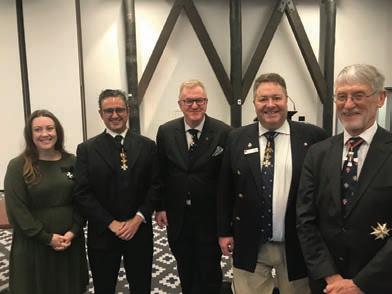

to look a er our safeguarding compliance and organises our retreats and formation.
Confrère Michael Potts KMG, a former Australian High Commissioner to New Zealand, has applied his expertise to the matters of the Honours and Awards Committee of the Australian Association. Confrere Bel ore Bologna KMG has taken on responsibility for fundraising and communications.
Confrere Bevan Killick KMG, a Chartered Accountant, has been appointed to the Audit & Risk Committee of the Australian Association.
Wellington Presidential visit e Australian Association President, the Hon James Douglas KHD KC visited Wellington in his role as Chair of the Australian Royal Commission into Defence and Veteran Suicide. A dinner was held at the Wellington Club and was attended by Christchurch based NZ Hospitaller Bevan Killick KMG, former NZ Delegate Peter Wood KMG KStJ and Simon Manning KMG QSO JP. e evening was most

enjoyable and discussions were wide ranging. e status of potential members and current members was a particular focus.
Chrism Mass Christchurch based members, aspirants and friends attended the annual Chrism Mass at St Mary’s Pro Cathedral on Monday 3 April. is is a permanent annual xture in our diaries.
Johanniter International
Mark Broughton, Chair of the Board of Johanniter International visited Christchurch on 7 March 2023. A meeting was held with the Deputy Chancellor of the Venerable Order, Major Brendan Wood CStJ DSD ED and the NZ Hospitaller to learn more about the various Orders of St John and a discussion around concerns about spurious orders.
Hato Hone (“St John” in te reo Māori / Māori language) the Most Venerable Order of Order of St John
We enjoy warm fraternal relations with Hato Hone, St John in New Zealand. e Annual Venerable Order Founders’ Day Service was attended by the NZ Hospitaller. is marks the establishment of Hato Hone St John in New Zealand.
On 20 May 2023 the Order of Malta was represented at the Christchurch Investiture of the Venerable Order by the Italian Honorary Consul Confrere Bel ore Bologna KMG (second from le ) and the NZ Hospitaller (second from right). ey are pictured here with Chancery Appointee Sonya Marshall CStJ (le ), Deputy Chancellor Major Brendan Wood CStJ DSD ED (centre) and Chancellor John Whitehead CNZM KStJ (right).
On 17 June 2023 the Order of Malta was represented at the Auckland Investiture of the Venerable Order by our aspirant Morgan O’Brien on Saturday 17 June. Pictured are Emeritus Archbishop Sir David Moxon KNZM CStJ, NZ Chancellor John
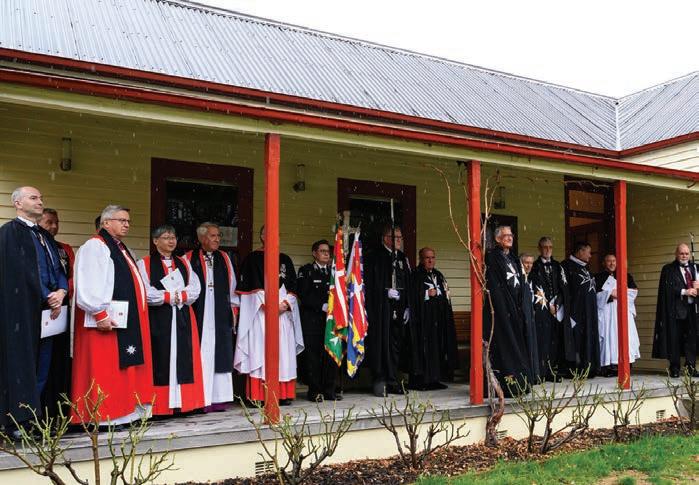
Whitehead CNZM KStJ, Morgan O’Brien (SMOM candidate) and Deputy Chancellor Major Brendan Wood CStJ DSD ED. e Investiture was presided over by the Governor General Her Excellency the Right Honourable Dame Cindy Kiro GNZM QSO DStJ.
On 10 September 2023 the Order of Malta was represented by the NZ Hospitaller at the Most Venerable Order of St John Queenstown Grand Council Welcome Service including the Investiture and Installation of the Chancellor of the Most Venerable Order of the Hospital of St John of Jerusalem.
is was an excellent opportunity to both further connect with our Confrere in the Venerable Order and meet new connections from Canada, South Africa and the United Kingdom.
Pictured are the Chancellor omas Budd GCStJ, the Prelate the Right Reverend Tim Stevens CBE GCStJ, the Lord Prior Professor Mark Compton AM GCStJ, e Priory Dean Emeritus Archbishop the Most Reverend Sir David Moxon KNZM CStJ MMCM and NZ Chancellor John Whitehead CNZM KStJ.
Pictured from the le are Cameron Oxley (Chancellor and Chair, St John Ambulance Australia), Emeritus Archbishop Sir David Moxon, to the right of the ags are Major Brendan Wood (Deputy Chancellor of Hato Hone St John), Professor Mark Compton (Lord Prior, Order of St John and Chair of St John International), Chancellor omas Budd (the newly Installed Chancellor of St John), Dr Steve Evans (Sub Prior of the Order of St John), John Whitehead (Chancellor of the Order of St John in NZ), and Bevan Killick (NZ Hospitaller, SMOM).
e New Zealand Hospitaller Bevan Killick has been active with many engagements during the year with associated entities in the Catholic community and wider Christian a liates.
St John’s Co-Cathedral, the former conventual church of St John, is besides a place of worship also a treasure trove of art commissioned by the Order of St John. Among these works of art are two paintings by Michelangelo de Merisi, better known as Caravaggio. is article is concerned with one of these two paintings, namely St Jerome Writing. Symbolic meaning is replete in the works of Caravaggio, but at the heart of the matter, at least for religious knights of the Order of St John, is a powerful message hidden in plain sight. At the heart of St Jerome Writing is the search for redemption. e sum of the matter can be surmised from a seemingly trivial stone.
Michelangelo Merisi da Caravaggio, better known as Caravaggio, was already a celebrated artist during his lifetime, but he was equally renowned for his rebellious lifestyle and criminal acts, including murder. Yet he remained a sensitive and intellectually ambitious artist, although his religious outlook was as brilliant and ambiguous. It su ces to say here that the life of Caravaggio in Rome could be stitched together from police reports on his violent behaviour and arrests. Caravaggio embodies the dichotomy of a celebrated artist with near-unlimited talent and very limited social skills. Caravaggio could work intensively for some weeks, and then he could disappear for a while in the gritty underbelly of the Campo Marzio where he lived.
Malta
Authors agree that Caravaggio came to Malta with a purpose: his desire for knighthood and redemption, following his escape from the long arm of Vatican justice a er he was suspected of involvement in the wounding and killing of Ranuccio Tomassoni on 28 May 1606, either by design or in self-defence. Caravaggio and Tomassoni had a troubled relationship over a lady, Fillide Melandroni. She was a favoured model of Caravaggio, while Tomassoni was her pimp. A capital sentence was initially issued, valid within the papal
states. is ght activated his ight mode, moving quickly out of Rome and exiling himself to Naples. He stayed and worked there for a year under the watchful eye of his other patron and protectress, Costanza Sforza Colonna. To obtain a papal pardon, he needed a long-term plan. Expressed by Ebert-Schi erer in more detail, Caravaggio had a desire to become a knight, craving a noble status, to match his fame as an artist. At the same time, Grand Master Alof de Wignacourt was planning to engage a court painter. e plan was to sail to Malta, o er his services as a world-famous painter, and try to become a member of the Order of St John. Embedded within the safety of the Order, he could then paint his way to redemption and a pardon. Against all odds, he quite achieved this complicated manoeuvre, although the pardon would reach Caravaggio just a few days a er his tragic death a few years later in 1610.
Caravaggio arrived on 12 July 1607 in Malta, on board a galley of the Order. Also on board was his acquaintance, Frà. Ippolito Malaspina, who would soon commission Caravaggio to paint Saint Jerome Writing. Cutajar also suggests that Malaspina was instrumental in introducing Caravaggio to Grand Master Alof de Wignacourt. Caravaggio produced the full-length portrait of the Grand Master in ceremonial armour and accompanied by a page. Wignacourt was overjoyed with the
By Dr Dane Munro KM
result of his own portrait, and the plan for Caravaggio’s knighthood was set in motion. Since Wignacourt had abolished the only title available to Caravaggio, Cavaliere di Obbedienza Magistrale, Knight of Magistral Obedience in 1604, the low-level title available for non-nobles, a creative initiative was needed. Wignacourt wrote a petition to the pope that he needed his blessing for two candidates who had shown merit and virtue but were not of nobility. His arguments were that he wanted to bestow knighthood on ‘a person of great virtues, honourable and respectful’, while at the same time avoiding to mention Caravaggio’s name. e pope sent his approval within a couple of weeks, showing that he knew that one particular candidate had committed homicide in a brawl (avoiding the word ‘duel’, which was fowned on by the higher ranks, as it was a punishable o ence). I presume that the pope would have received news from his papal spies in the court of Wignacourt. In any case, a er his investiture, the news would have reached Rome sooner or later.
Caravaggio preferred to paint secular and sacred narratives in a vivid and graphic manner. His scenes, especially Biblical ones, stand out through dramatic, contrast-rich lighting and a striking hyperrealism in the rendering of his o en very expressive characters. is mastery of light, his own version of chiaroscuro, the rather high contrast between dark and light, endowed Caravaggio with a rather profound in uence on Western art. He composes and adorns his storytelling composition with strategic use of symbolism, various layers of perception, moments of tension and total command of foreshortening. is allows the viewer to see his subjects in all kinds of unusual perspectives and exposure.
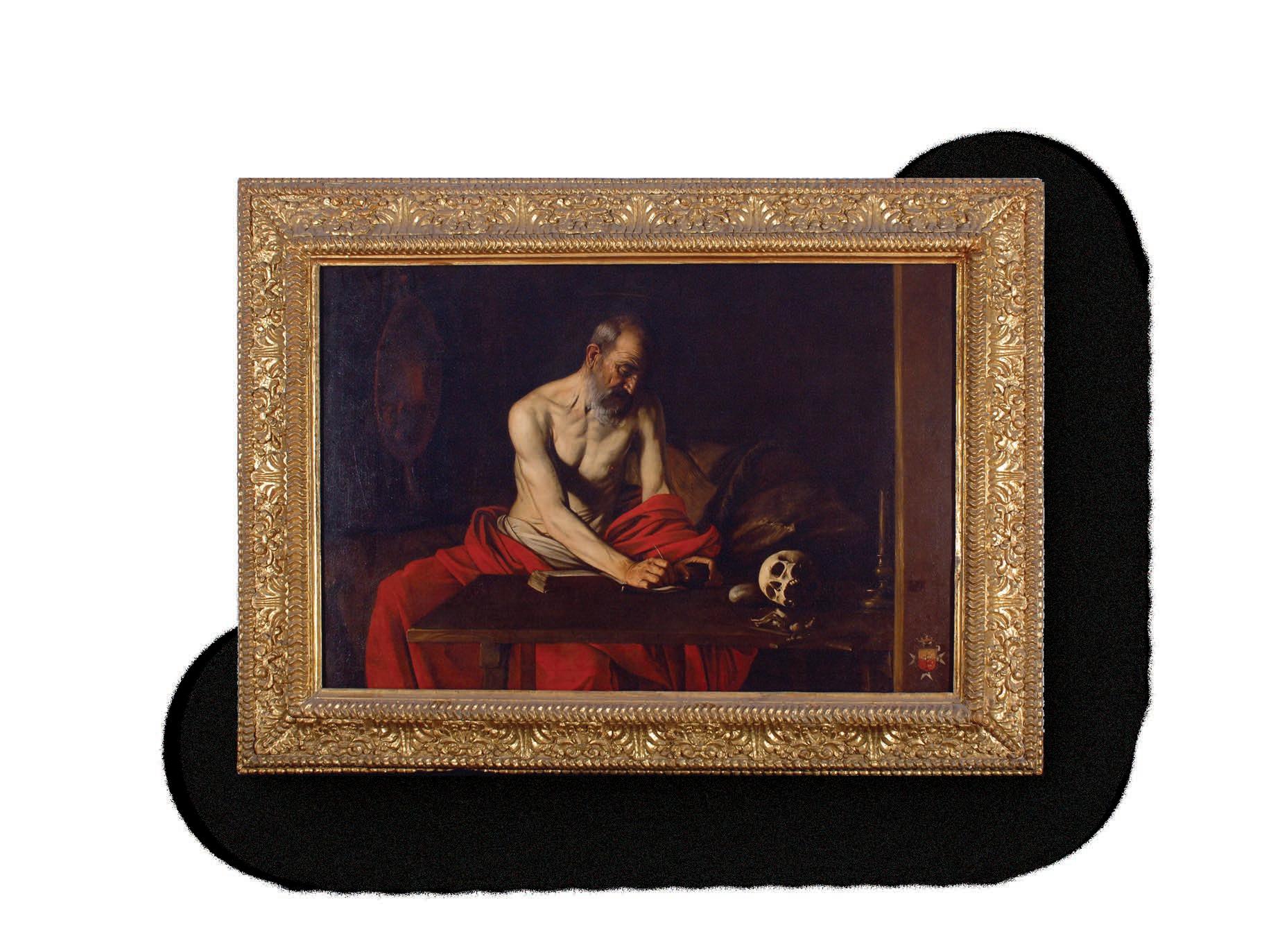
Caravaggio’s patent chiaroscuro is o en achieved by creating a dark, vague

background with a broad brush. In the foreground, some of his larger-than-life characters, or parts thereof, are highlighted with the clever use of a spotlight technique, luce di cantina (lit. translated ‘cellar light’) and very ne brushes, creating hyper realistic details. Cellar light is that kind of intensive directional daylight coming through a small window or sha into a dimly lit space, and in that beam one can distinguish thousands of scintillating small dust particles oating through the air. Such light is used to cra a particular mood, ltering in from a certain direction. His live models were o en dressed in contemporary but worn clothing, accentuating the Christian values of poverty and humility. e grazing light e ect on the subjects reveals many details of their physiognomy or anatomy, as is the case with Caravaggio’s Maltese version of St Jerome Writing. Caravaggio’s masterful handling of chiaroscuro through luce di cantina allows for a great three-dimensionality, intriguing juxtaposition of what can be seen and what cannot. Caravaggio applied symbolism with great care and skill to create layers of perception and moments of tension.
St Jerome Writing
St Jerome Writing is the other painting by Caravaggio at St John’s Co-Cathedral. Much smaller than the Beheading of St John, but not less magni cent, this painting, oil on canvas, measures approximately 118 cm × 85 cm. Similar to the puddle of blood in the Beheading of St John, this painting has also a small but very quintessential symbol, a small stone, around which the story of St Jerome Writing pivots. An anecdote relates that on one ne day, Pope Sixtus V (1585–90) was standing in the corridors of the Vatican, admiring a painting of a penitent Jerome in the desert. In this painting, St Jerome was hitting himself on the chest with a stone. Sixtus V remarked: ‘You do well to carry that stone, for without it the Church would never have canonied you.’ is illustrates that Jerome’s apparently volatile personality was still making some people, more than 1100 years a er his death, doubt on what grounds he had gained his sainthood. Like Caravaggio, St Jerome seems to have had his own share of troubles.
Jerome, the man Eusebius Sophronius Hieronymus (Εὐσέβιος
Σωφρόνιος
commonly called Jerome, came into the world in c. 345/347 in Stridon in Dalmatia, Slovenia. Jerome was born into a well-o Christian family and received a rst-class education, notably at Rome under Aelius Donatus, a Virgilian scholar and Victorinus, a Christian orator. Jerome’s date and place of death is traditional 30 September 420 in Bethlehem.
Jerome and Caravaggio had many things in common, the one a awed saint, the other a awed painter, both creating works of the highest standard. ey both had lived in Rome, where they experienced the dark and violent side of the city. Violence and sexual prowess characterised Caravaggio as much as it did Jerome, and each in their own way, realised that they needed to change their ways, St Jerome writing and Caravaggio painting for their penance.
Jerome had to resist with all his might the temptation of the esh, which led him to do penance. Beginning in 375, Jerome lived for up to four years as a desert hermit in Chalcis, where he o en dreamt of girls and thought about pagan authors. His letter to Eustochium, Letter 22, is full of references to the Song of Songs, virginity and references to classical scholars. Like Caravaggio, he had his own demons to ght.
It has also been claimed that Jerome had translated the whole Bible, however it has transpired that this is not the case. He did translate all the New Testament books from Greek to Latin, but not all the translation from Hebrew to Latin of the books of the Old Testament, are his work, notably those books which St Jerome thought were non-canonical but apocryphal writings. In medieval times, St Jerome was o en depicted as the patron saint of librarians and translators.
e setting of the St Jerome Writing ere are several items in the iconography which suggest that death is imminent. Jerome’s body is one of a man advanced in years and unhealthily emaciated. St Jerome is at work on a book, or rather a codex (loose-sheets bound by a string), writing or translating a text. On the table there are also a skull supported by a stone, a candle which ame has just been extinguished, and a cruci x (with a rather remarkable foreshortening) lies precariously balanced on the rim of the table.
When one looks closer, the whole painting seems to suggest death: a skinny old man, with a very thin halo already appearing over his head, a skull and an extinguished candle are usual end-of-life symbols. However, one may ask is St Jerome not just starting to work on something new? At face value, St Jerome is seemingly
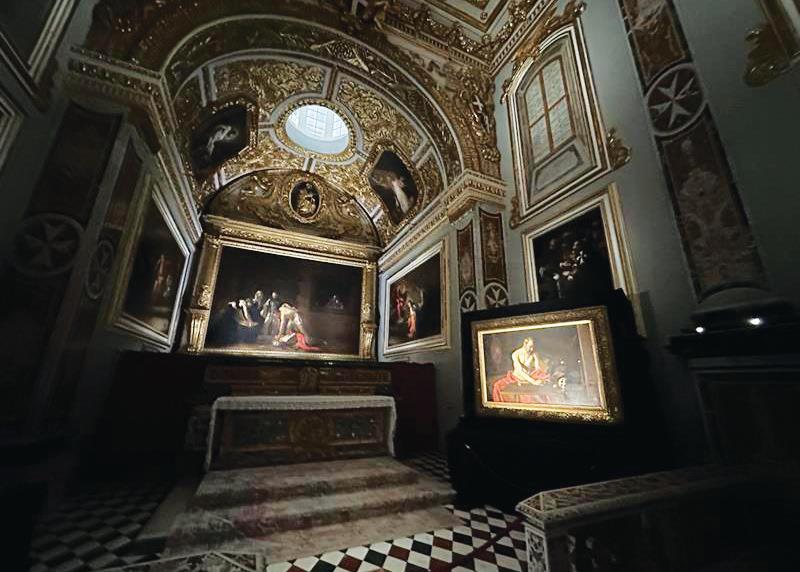
just beginning to work on a codex, just a few pages in from the front cover. Part of the unseen moment of tension is that Caravaggio stages St Jerome translating the Hebrew scriptures of the Old Testament into Latin, creating his Vulgatus. Since Hebrew is written from right to le , St Jerome is not at the beginning but at the end of the codex. He is therefore ‘writing between the lines’, one sentence of Latin from le to right between two sentences of Hebrew. Knowing how to read between the lines has become a common expression.
On the rim of the table rests a cruci x in a precarious, near-impossible balance, representing the volatility and bipolarity both present in St Jerome, sinner-becomesaint and in Caravaggio, sinner-shortof-redemption. e two men had the reputation of being capable of violence and piety at the same time. It also represents a challenge: can Jerome truly edit and translate Christian scriptures or does his passion for pagan Classical authors comes through the cracks notwithstanding his oath to God to stay away from their works? And can Caravaggio control his temper? When St Jerome is ready with the translation and has written the nal full stop, one can imagine that he forcefully closes the codex with the delight of a job well-done, shaking the table. is is the second moment of tension, as this might disturb the delicate balance of the cruci x on the rim of the table, threatening to knock it on the oor. It will mark the end of St Jerome as his death has been heralded by the extinguished candle.
e light and setting of the painting St Jerome Writing was originally on a wall
at the home of Frà. Ippolito Malaspina in Valletta before it was bequeathed to the conventual church. I presume it was mounted over a mantelpiece, as the best way of looking at this picture is when it is at about 2 metres above the oor. is frog’s perspective will reduce the writing arm of St Jerome to the right proportion and then one will also understand how it is possible to look beneath the table from such a close distance.
Light in this painting comes in from le top and goes diagonally down to the right bottom. e dark background is painted with a broad brush, such as the wall and the bed cloth behind St Jerome. e luce di cantina lighting technique, the grazing light, accentuates the body of St Jerome. In contrast, with very ne brushes Caravaggio renders all kinds of rich details of St Jerome’s physiognomy and morphology, which gives the painting a very natural, photographic quality, such as the face, folds in the skin of the stomach, the collar bone, the veins on the arm and hand as well as the reed with which he is writing. St Jerome is only partially clothed in a scarlet robe, a Baroque symbol of saints. His nude upper torso is of particular interest. His posture is compared by Ebert-Schi erer to the statue of the Dying Gaul, another hint that death is looming. is is an acceptable suggestion since Caravaggio knew his classics well. e model sitting for St Jerome was an elderly man with a sickly white torso but with tanned head and hands, strengthening the position that Caravaggio’s models were street people. Choosing such a model also adds credence that Caravaggio knew some of the contents of the Golden Legend, both
regarding St John the Baptist and St Jerome. In Epistle 22.7 (in translation) St Jerome says that: ‘Sackcloth dis gured my unshapely limbs and my skin from long neglect had become as black as an Ethiopian’s.’
According to the Voragin in his Golden Legend, Jerome, had spent years in the desert sun for penitence, gaining a ‘Moorish complexion.’ St Jerome also acquired an emaciated gure, the result of his fasting in the desert. Details such as his collar bone accentuate this. In the same section 22.7 Jerome writes:
Of my food and drink I say nothing: for, even in sickness, the solitaries have nothing but cold water, and to eat one’s food cooked is looked upon as self-indulgence. Now, although in my fear of hell I had consigned myself to this prison, where I had no companions but scorpions and wild beasts, I o en found myself amid bevies of girls. My face was pale and my frame chilled with fasting; yet my mind was burning with desire, and the res of lust kept bubbling up before me when my esh was as good as dead.
Saint Jerome Writing’s main focus is the mortality of the Jerome the man and the immortality of Jerome the saint. He earned his sainthood not just by rendering the Scriptures and making his Vulgate available to a very wide audience, but primarily as a great sinner who found redemption. According to the aforementioned Pope Sixtus V, Jerome’s redemption was his unceasing repenting of his many sins and always wanting to come closer to God.
Hence, for the purpose of redemption earned, the stone is the centre of the painting. Caravaggio props this stone against the skull to prevent it rolling over. It is the stone with which St Jerome would beat his chest when doing penance in the desert. Although the stone is not mentioned in his Letter 22.7 where St Jerome describes beating his chest: ‘I remember how I o en cried aloud all night till the break of day and ceased not from beating my breast till tranquillity returned at the chiding of the Lord’. Notwithstanding the absence of the stone in St Jerome’s own narrative, many paintings portray St Jerome in the desert with a stone in his hand, e.g. Girolamo Romanino, El Greco. Giovanni Girolamo Savoldo, Hans Memling, Leonardo da Vinci etc.
Caravaggio uses the stone to prop up the skull, so prominently displayed on the tabletop, to prevent it rolling over. In art, the skull is the embodiment of memento mori (remember thy death) and also symbolises Adam, the man who introduced human mortality when being expelled from the Garden of Eden. It also stands for intellect, the seat of thought and spiritual perfection, and, of course, as a relic. Besides all these connotations of death, I think Caravaggio also introduced here an element of selfpromotion. When painting a skull which is lying on its side in a three-quarters position, it is notoriously di cult to retain the plasticity and to render the illusion of being round and three-dimensional.
Caravaggio happened to be a master of this technique, and it is not unthinkable that he is rubbing salt on the wound of his colleague painters. One can nearly hear Caravaggio boasting: ‘Commission your next painting with me, because I can do this and my colleagues surely not!’
Caravaggio’s stimulus of Western art is far-reaching and his genius was not always understood. For the members of the Order, in particular the novices, it was essential that they could comprehend the deeper meaning of his work
St Jerome’s stone, with which he tried to beat sin out of his own chest, is of signi cant value for knights. A er all, nobody is perfect, as summed up by Frà Nicola Abri Dezcallar, Grand Prior of Catalonia, whose sepulchral slab is at the entrance to the Oratory. His inscribed text, in Catalan, reads that he thought of himself as a PECADOR MISERABLE, a miserable sinner. According to Frà Nicola’s own beliefs, he would be without doubt staying in Purgatory and was in need of the petitions of the living during Holy Mass at the Altare Privilegiatum to have his deferment in Purgatory shortened. e status of St Jerome as a saint will give hope to the modern members of the Order who have

argued that the founder of the Order, Blessed Gerard, deserves to be canonised. Both St Jerome and Blessed Gerard have in common that they neither created miracles nor died a martyr’s death. St Jerome’s and Blessed Gerard’s embodiment of their faith and piety created institutions for the greater good and bene t of everyone, and the results are still around at present: an edition and translation of the Scriptures since the fourth century and a charitable Hospitaller Order of St John since the eleventh century, today, both miracles in their own right. St Jerome’s other writings, like those of St Augustine, had a great in uence on Christian thought, while Blessed Gerard’s insights have shaped
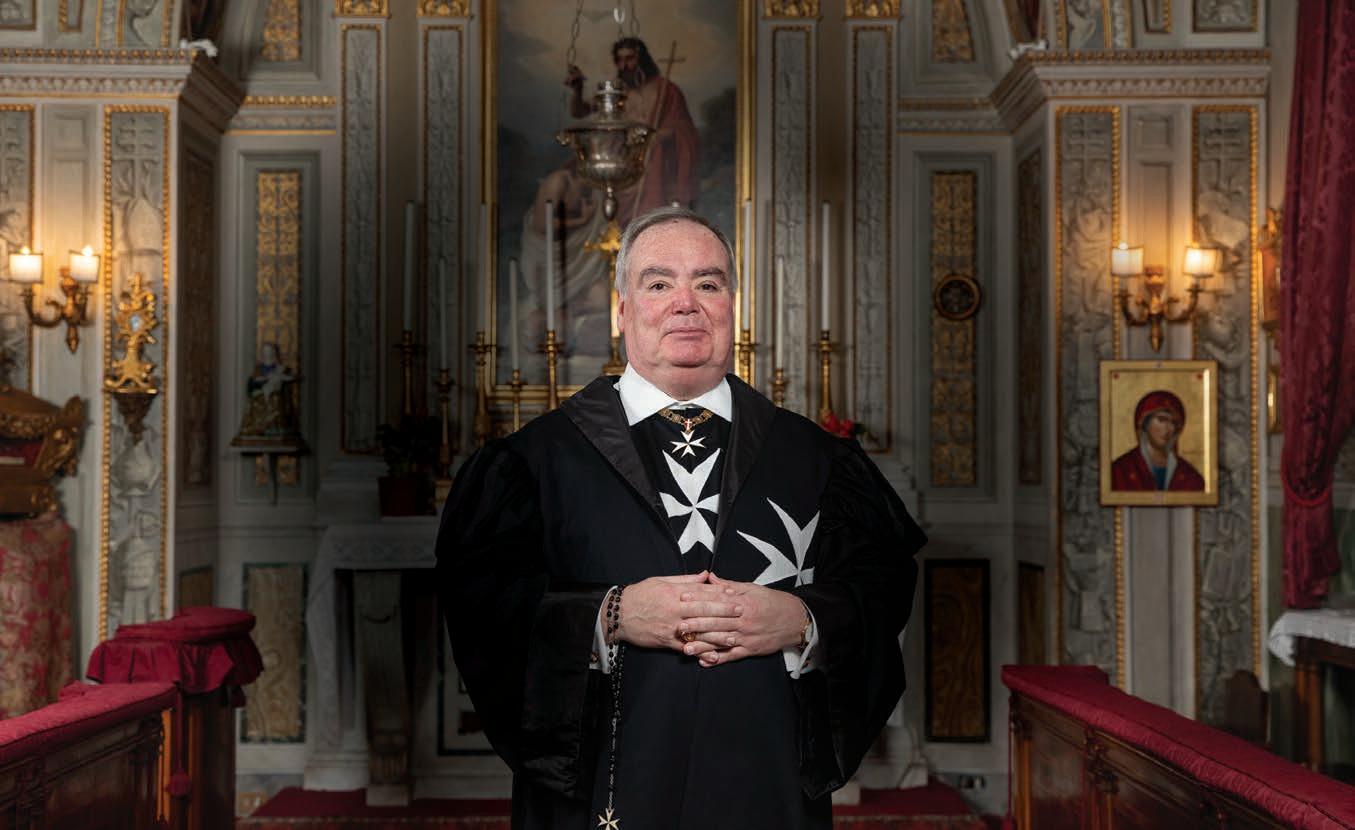
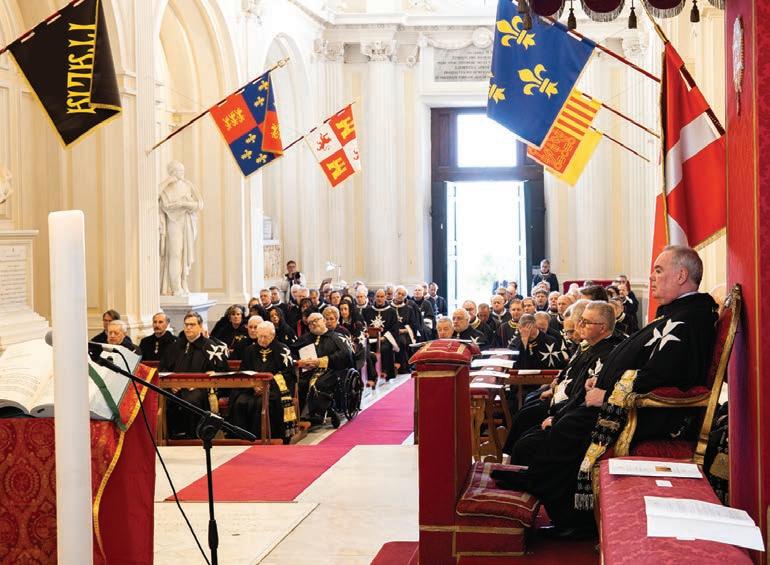
e election of the 81st Grand Master, Fra’ John Dunlap: Best wishes to the Grand Master from all over the world.
The day a er his election as head of the Sovereign Military Order of Malta, the 81st Grand Master Fra’ John Dunlap received numerous messages of congratulation and good wishes from heads of state of European and non-European countries, as well as the embassies of the countries accredited to the Order of Malta.
e election of Fra’ John Dunlap on 3rd May, “opens a new phase in the life of the Order, which under its leadership can engage with even greater energy in its admirable work supporting the sick and the most vulnerable, especially in those areas of the world where the very dignity of human beings appears threatened,” reads the message sent by the President of the Italian Republic Sergio Mattarella, in which particular appreciation is expressed for the
Order of Malta’s “operational promptness in response to crises and emergencies.”
Greetings came also from Spain, with King Felipe expressing the hope that the Order of Malta will be able to continue its “mission of solidarity for the neediest”. In his message, the Austrian President, Alexander van der Bellen, stresses the “admirable solicitude” with which Fra’ John Dunlap accompanied the “reorganisation of the Order”, stating that “the recognition of international sovereignty is of great signi cance for carrying out the Order’s mission especially in crisis areas.”
e German President, Frank-Walter Steinmeier, wished “divine blessing for this important position already held with a sure hand as Lieutenant of the Grand Master in a decisive period for the Order”.
e Order of Malta’s important role “in helping thousands of Ukrainian refugees eeing the war” is highlighted in the telegram the President of the Slovak Republic, Zuzana Caputovà addressed
to the Grand Master. e President of the Republic of Kazakhstan, KassymJomart Tokayev, recalls that “the robust partnership with the Order of Malta is celebrating its 30th anniversary”. Messages also came from the President of the Czech Republic, Petr Pavel, of the Republic of Croatia, Zoran Milanovic, the Albanian President, Bajram Begaj, the Bulgarian President, Rumen Radev, the Estonian President, Alar Kavis, and Katerina Sakellaropoulou, President of the Hellenic Republic, as well as from several other European, African and South American countries, and from George Furey, the speaker of the Senate of Canada, birthplace of the Grand Master.
Not only messages from Heads of State and Government but also from civil and religious authorities, institutions, members of the Order of Malta and citizens worldwide who wanted to congratulate the new Grand Master both by letter and on social media.
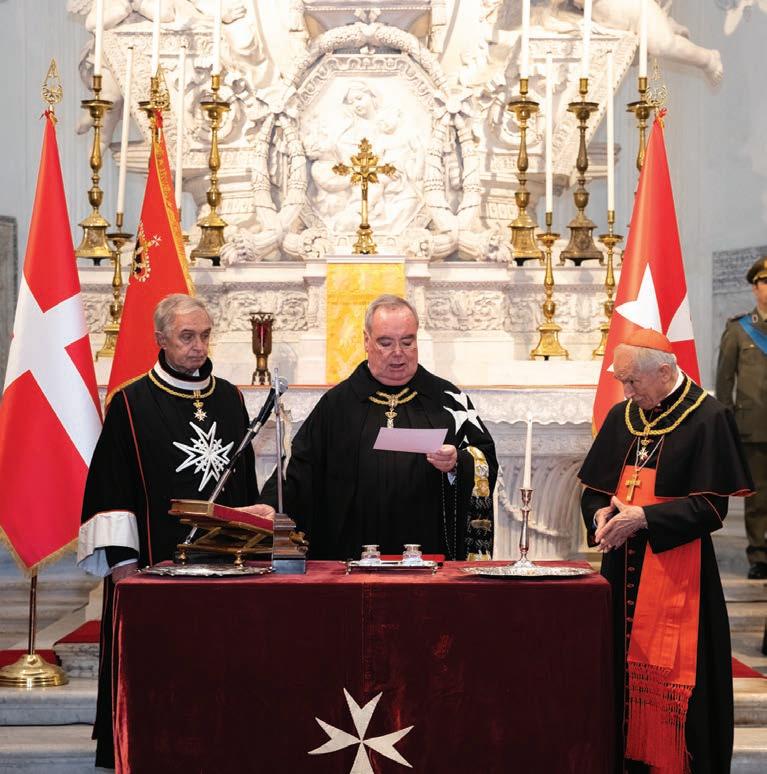
Born in Ottawa, Canada, on 16 April 1957, a er studying in Nice University, John Dunlap graduated from the University of Ottawa and then obtained a Juris Doctor degree from the University of Western Ontario. He was awarded an honorary doctorate in Public Service by John Cabot University in Rome.
Fra’ John Dunlap is a member of the New York State Bar and the Ontario Bar Association in Canada. In 1986, he joined the New York legal rm Dunnington, Bartholow & Miller in New York City, becoming a partner in 1993. He specialises in corporate and immigration law. An internationally respected lawyer, since 1997, he has been legal adviser to the Permanent Observer Mission of the Holy See to the United Nations.
Fra’ John Dunlap approached the Order of Malta and found his religious vocation in the mid-1980s during his volunteer work with patients su ering from AIDS and other diseases at the Cardinal Cooke Medical Center in Harlem (New York). He has volunteered in that hospital every week for the past 30 years.
Admitted to the Order of Malta in 1996, he took his solemn vows as a Professed Knight in 2008. For over a decade he has served the Order of Malta as Chairman of the Committee for the Protection of Names and Emblems and Representative to the Alliance of the Orders of St John.
In 2009 Fra’ John Dunlap was elected for a ve-year term as a member of the Sovereign Council. He was reelected for another ve-year term by the Chapter General in 2014 and then in 2019. He led the Order of Malta as Lieutenant of the Grand Master since June 2022, following the death of Fra’ Marco Luzzago. He was elected Grand Master of the Sovereign Military Order of Malta on 3 May 2023.

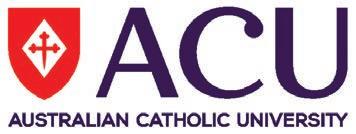
Meet the Tutor: ACU & e Order of Malta teams up with Preston North-East Primary School to develop reading skills.
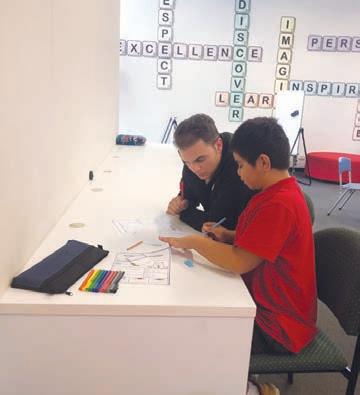
The Order of Malta and Australian Catholic University (ACU) Community Hub in Melbourne, run a Read to Learn program in partnership with Preston North East Primary School. Read to Learn aims to support primary school children from culturally and linguistically diverse and refugee backgrounds, who have also been identi ed as requiring additional support to develop their reading and literacy skills.
Read to Learn involves one-on-one tutoring in weekly sessions during school Term. At Preston North East Primary School, more than 50% of the parents speak English as a second language, with many reportedly struggling to help their children complete
reading and homework tasks. Currently there are 15 primary school students in the program with many more students on the waiting list, the main issue limiting the projects expansion is the number of tutors available. e group of tutors are made up of members and volunteers of the Order of Malta and ACU students as part of their course requirements.
We speak with Order of Malta member, Keiron Long about his experiences as a Read to Learn tutor:
Q: Keiron, tell us about the students you tutor in the program?
A: e program assigns one tutor per student.
e idea is to build a rapport with the student and come to understand their learning needs. Let’s call my Year 3 student “Francesca.” I told Francesca the meaning of her (beautiful) name in Italian, and we google searched her Italian surname and found a town with the same name and then we explored the town on google photos. We did the same with her mother’s English name.
Francesca lives with her grandparents. She nds it hard to concentrate for very long so in between working on a writing or reading exercise, we would talk about her favourite apps, and she would tell me the things she liked most about each App. When Francesca was reading to me, I would explain the meaning of di cult words as we went along and answer any questions.
Q: What impact did you see on the student during the rst term of the program?
A: e one-on-one relationship with a student provides another adult support, even if ever so brie y, to children who in some instances go home to dislocated family environments. Also, in a school class of twenty plus students, individuals rarely have the full attention of the teacher. is is something which the tutoring program provides. I suspect that in the limited time we have each week the positive a rmation we give to the students is far more important than the learning experience.
Q: What do you think the students and their parents/ guardians think of the program?
A: Francesca was happy to be part of the program and wanted to continue when the semester was nished. e other students also seemed keen to continue with the program. Francesca’s Nonna was pleased with the time we were giving to her grandchild and o ered her thanks on the last day.
Q: What impact has the project had on you as a volunteer (and others if you have any insight)?
A: e program reinforced how important a friendly and supportive environment is, if students are to fully embrace any learning opportunities so as to reach their full potential, especially given many students have hurdles to overcome, such as language or family instability.
Q: Did anything surprise you about the student, program or volunteers?
A: I was surprised by how receptive the students were once the program was up and running. e ACU university student volunteers also embraced the program and built up a good rapport with students.
Q: What would you say to anyone considering becoming a Read to Learn tutor?
A: Grandparents would nd it easy as they only need to treat the students as they do their grandchildren. I think anyone who joined the program would nd it rewarding because they would quickly build a bond with their student. However, I think it important to see yourself as a mentor more than a tutor and be willing to be exible and occasionally wander down lanes that


the student may wish to explore. Volunteer positions are now open for semester 2, running from Monday 14 August and runs till Monday 30 October. Session times are 3.15 till 4.45 at Preston North East Primary School. If you are interested in volunteering email info@orderofmalta.org.au for more information.
e Order of Malta and ACU Community Hub rely on the generosity of donors to continue serving the Melbourne community. Gi s of $2 and more are tax deductible for Australian taxpayers and can be made using our secure online donation facility.
Keiron and Mary Long assisting ACU students working with primary school children from diverse backgrounds with their English reading skills.
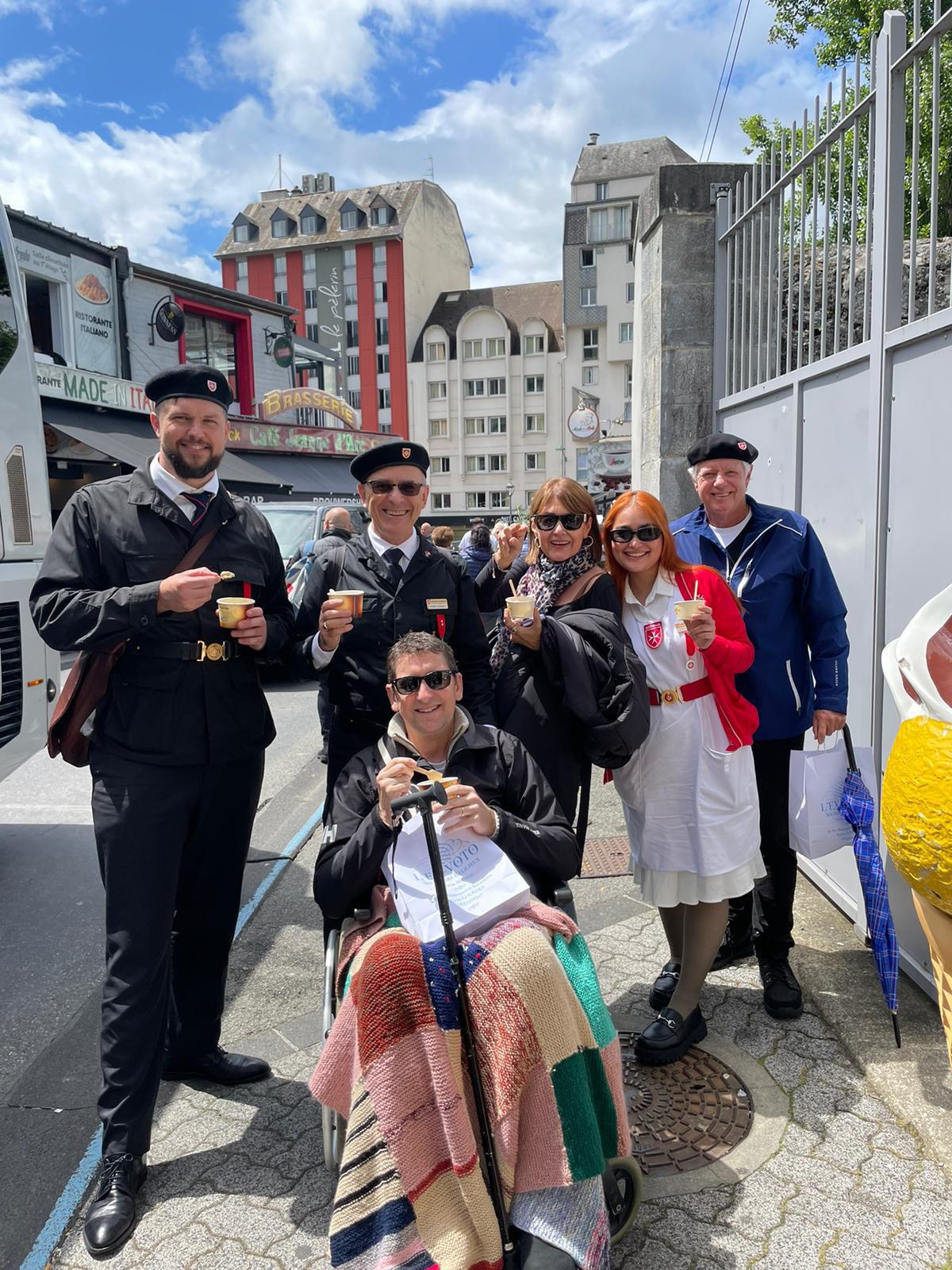

By Jim Rodgers
e Australian Association hosted Malades for the rst time in over a decade on this sacred religious pilgrimage to the Sanctuary of the Lady of Lourdes. Collaborating with our friends from the Hong Kong Association, four Malades made the long trip to France. Here is Jim Rodgers personal account of a corporeal and spiritual journey.

Having not travelled overseas for more than eight years, I must admit that I was nervous preparing to undertake the journey to Lourdes in the South of France. I was unsure how I would cope given my current health challenges, however, I knew that with Denise by my side, we could handle anything. e long ights certainly were very tiring and did test me, but we kept a focus on our pilgrimage.
We arrived in Paris and a er a good night’s rest at the Voco Hotel we met up with our fellow pilgrims and started what was arguably the best experience of our
lives. From the very rst morning, I have never felt so much compassion, care and devotion as I felt with our fellow travellers. Our train journey to Lourdes was a fantastic trip through the French countryside, with our new friends keeping a quiet eye on us the whole timethey were never too far away.
A pilgrimage to Lourdes has always been on Denise’s bucket list, and I have been open to strengthening my faith, so we were both looking forward to the experience. Despite the number of people in Lourdes there was a distinct feeling of peace, tranquility and togetherness.
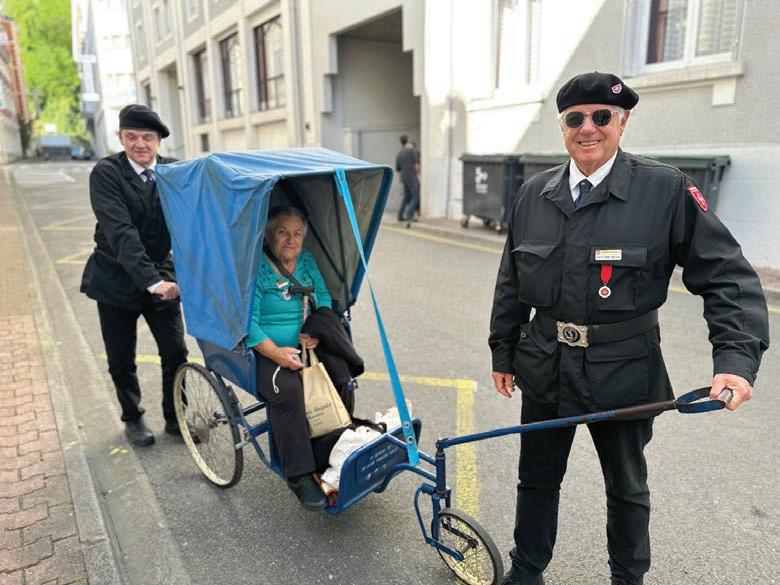
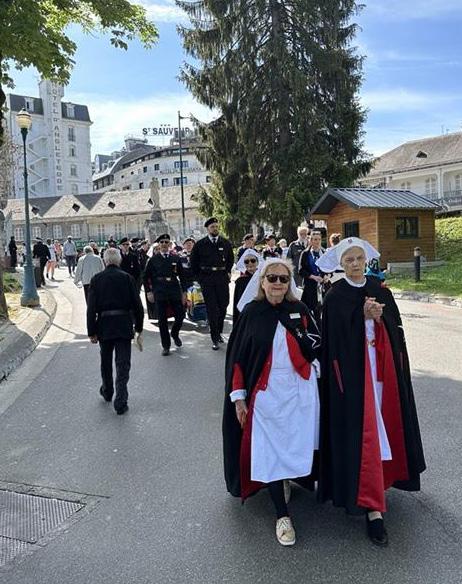
We experienced so many highlights including:
• Mass at the Grotto – the Australian/Hong Kong and American Masses with the opportunity to pass through the Grotto.
• Night procession - which is simply spectacular and very moving.
• Anointing Mass – the healing massparticularly as a Malade.
• Way of the Cross – sharing a deep sense of connection within our group.
• Visit to the Baths – the experience of a partial bathing in the holy water.
• Abbataile de Saint Savin – a very intimate mass in such a historical church.
I think the true essence for me was the acceptance of my situation and being at peace with whatever God has planned for me. I am grateful for the opportunities and experiences
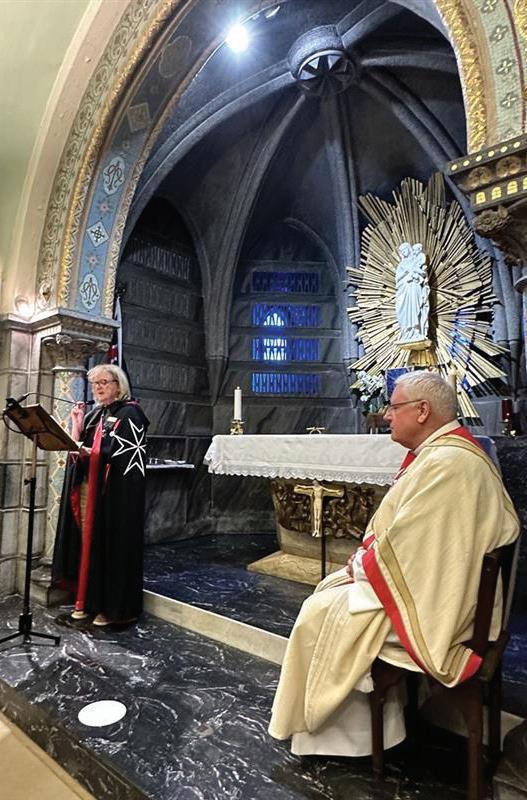

I have had in my lifetime, especially the people I have been able to share it with. I have met many inspirational people during my time from all walks of life, but not one of them has le me as inspired as the Order of Malta pilgrims with whom we shared this journey.
As a Malade, I was surrounded by people wanting to assist with my every need, in fact my team seemed to be able to read my mind and pre-empt what I needed whether that was shade, a blanket or a drink. ey also took all the pressure of caring for me from Denise so as she could get the most out of her pilgrimage.
I experienced many deeply emotional moments throughout the pilgrimage but the most moving was without doubt climbing the di cult and steep path following the
Way of the Cross. With myself in a voiture, everyone took turns pushing and pulling me whilst climbing the path following each of the Stations and taking turns to lead the readings and prayers. At various stages the team shared personal stories and it touched me deeply as they had given up time with their own families and friends to serve us and help make our pilgrimage to Lourdes so memorable.
We are extremely grateful to the Order of Malta for making it possible for Denise and I to experience Lourdes, the pilgrimage and the spiritual connection that such a journey provides. It is such an upli ing experience made all the better sharing it with the dedicated members of the Order.
We would thoroughly encourage anyone to undertake a pilgrimage to Lourdes.


e spirit of pilgrimage has been present since the Order was founded in the 11th century. Since then, the Order has managed hostels and rst-aid posts throughout Europe on the major pilgrimage routessuch as the Via Francigena or the Camino di Santiago – to o er shelter and food to travellers. Every year, the Order’s members go on pilgrimages to Catholic shrines, together with the disabled or sick they assist.
e Order’s pilgrimages included accompanying the sick, sharing love and attention. It is a commitment that characterises every pilgrimage, a life-giving experience.
e most important international pilgrimage is to Lourdes; it takes place every year and is led by the Grand Master. Here, in early May, members and volunteers from 45 countries accompany thousands of sick, elderly and wheelchair pilgrims.
In the Membership in the Order of Malta - Regulations and commentary, Section VI. Admission to the ird Class it is stipulated:
• e recommendation to participate in a pilgrimage of the Order to Lourdes during the Prepartory Year. Should this not be possible, the obligation to make up this pilgrimage within the three years following admission.
Top le : ousands gather for the Marion Candelight Procession.
Top right: Participating in Stations of the Cross.
By Michelle Rees
In 2023, the Australian Association continued its tradition of bringing “Lourdes to the malades of Australia”. Lourdes Masses were hosted in Adelaide, Melbourne and Sydney and welcomed thousands of Australians in need of physical or spiritual healing and support. As ever, those in attendance received a blessing for good health and a bottle of water brought from the shrine at Lourdes.
e rst Mass of the year was held in Adelaide at St Francis Xavier’s Cathedral was well attended. A special thanks to our celebrant Fr Anthoni Adimai SdM for his
inspiring homily and care with the malades. e celebration at St. Patrick’s Cathedral in Melbourne, was particularly special a er a three-year hiatus due to the pandemic. ankfully, the interruption to what has been a longstanding event in the archdiocese calendar did not impact attendance, with Archbishop Comensoli welcoming a congregation of over 3,000. In his homily, he emphasised that Lourdes reminds us that the poor and sick are ‘our true Lords and Ladies, our friends in Christ’.
In addition to the annual Mass at the cathedral, members in Victoria hosted

Masses at aged care facilities around Melbourne throughout the year.
e Most Rev Anthony Fisher Archbishop of Sydney, who is also an Order of Malta Chaplain, presided over the Mass at Mary’s Cathedral in December. e congregation at the annual Mass were joined by thousands online who watched the livestream of this special celebration.
e Order of Malta’s Lourdes Mass celebrations are for the intentions of all Catholic families, but the sick and in rm members of the community are particularly encouraged to participate.

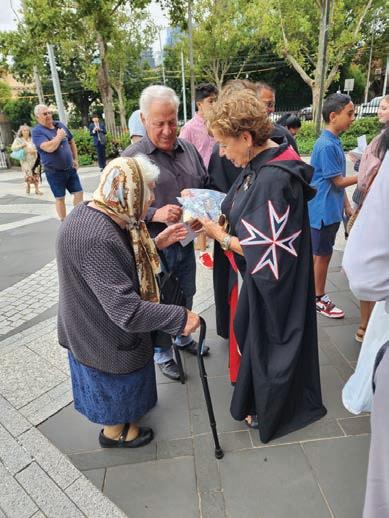



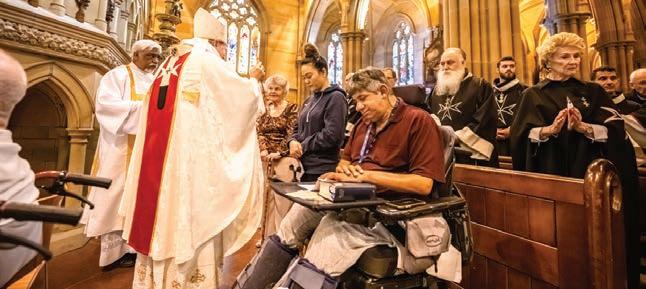



Malteser International’s press o cer Katharina Kiecol travelled with team members from our Middle East department to the Turkish-Syrian border region, which was shaken by the severe earthquake in 2023, and spoke to those a ected in Syria. She reports:
By Katharina Kiecol
It feels strange when we are standing on the Turkish-Syrian border and the earth suddenly shakes beneath our feet. Ever so slightly, but still noticeable – as if nature wanted to remind us why we are here. At the time of our journey, it has been almost a year since the severe earthquakes struck this region. Earthquakes that claimed the lives
of almost 60,000 people and caused millions more to lose their homes and livelihoods.
About 30 kilometers across the border lies the city of Afrin, one of the places most a ected by the earthquakes. e prolonged war had already brought many changes: before 2011, around 35,000 people lived here, but now over 450,000 displaced people have
settled here, too. Ruins and rubble still lining the streets make us feel as if the earthquakes had only just happened yesterday. “ ere is no one from the ruling groups who feels responsible for reconstruction,” explains Dr Mahmoud Mustafa, head of the Syrian aid organization IDA (Independent Doctors Association), our local partner.
A hospital made of tents
We are accompanied on our journey by IDA sta , because without them our entry to Syria would not have been possible. Our rst destination is the eld hospital in Afrin, which Malteser International helped to build and which is run by IDA. “When the earthquakes struck, there was only one hospital for the whole city. Many smaller health facilities were destroyed. An alternative had to be created quickly,” says Dr Mustafa.
Huge tents stand close together in the eld hospital and it is a hive of activity. Patients sit and wait in every room. Even though there are only tent walls around us, the eld hospital has almost everything needed for examinations and treatment: including two operating theatres, a CT machine and X-ray equipment.
I meet Dr Hasan Wazaz in a separate treatment room. I ask him how he experienced the earthquakes back then and how he sees the situation today, and he begins to tell me. “At rst, I had no idea about the scale of the earthquakes. I went to the hospital, and it was completely overcrowded. Ambulances were constantly pulling up and bringing several injured people at a time. Today, most of those a ected in Afrin are still living in tents because their homes have been destroyed. And that’s a big challenge in winter, because it’s cold and people don’t have enough money to heat their homes. is is particularly dangerous for the children’s health. In addition, the people in Afrin are severely traumatized. I have a 21-year-old patient who
lost her husband and brother in the earthquake. She lay under the rubble for days and broke her back and one of her legs. How will she ever forget the earthquakes?”
40,000 people still live in emergency shelters
A few kilometers away, near the Bab al Salam border station, is the Wassim Maaz Hospital, which we helped to build in 2015 and have supported ever since. e journey there is tedious – the roads are barely paved, and we need to stop at checkpoints time and again. In this area, much like Afrin, the landscape is densely dotted with tents. More than 40,000 people still live in these shelters in northwest Syria because of the earthquake, and four million more because of the war. Numbers that only become roughly comprehensible when I think of the fact that there is a person and a story behind each one of them.
Like 40-year-old Muhammed Abdu. I meet him at the hospital, where he is being treated for high blood pressure, free of charge. With some medication in his pocket, he makes his way home and takes us with him. He lives with four of his six children and his wife in one of the camps next to the clinic. He used to live near Aleppo but ed here immediately a er the beginning of the war to bring himself and his family to safety. at was almost 13 years ago. Today, around 26,000 people live in three camps around the clinic. But in the clinic’s catchment area, the number shoots up to one million.

Muhammed Abdu shows us how the earthquakes damaged his small home. Private donors, he says, helped him to repair his house, as there were deep cracks in all the walls. “We are still traumatized. Even though we’re all alive, we are constantly afraid that we’re not safe,” says Muhammed Abdu.
e illusion of safety
Deep-seated fear and trauma are recurring themes during my journey. Even when we travelled to the Idlib region two days later. is region is currently controlled by the radical Islamic organisation Hayat-Tahriral-Sham. For reasons of cultural sensitivity, but also for our own safety, the women in our travel group therefore wear an abaya, an ankle-length dress that is worn over our clothes. It feels unfamiliar, and I’m not as agile as I normally am.
A er crossing the border, we head south to Armanaz. I have never seen so many refugee shelters in such a small space. And this even though the ground is so littered with stones that I can hardly imagine how tents or containers can even be set up here. I meet Dr Ibrahim Al-Khatib at the Armanaz Surgical Hospital run by our partner organisation HIHFAD (Hand in Hand for Aid and Development). Shortly a er the earthquakes he told us how terrible the situation in the hospital was. Today I want
to know how the situation is now. “Looking back, the earthquakes were the worst thing I’ve ever experienced,” says Dr Al-Khatib. “ e situation here was already bad before the earthquakes. Hundreds of thousands of people had ed to this area before the war because they thought they could live here in safety. But then the earthquakes struck, and many lost their homes again, lost family members and friends. It a ected me deeply and I was emotionally worn out,” says Dr Al-Khatib.
People in Syria still need our support! ere is very little media coverage on the situation in Syria, as other crises have taken center stage. But the fear of the people here is palpable. Last year’s earthquake has le people feeling even more vulnerable than they already were due to the ongoing violence, as the seemingly safe regions of Idlib and Afrin had suddenly become a death trap for more than 7,000 people. I return home with mixed feelings. On the one hand, we have seen that our support reaches the people, especially in the medical sector with well-equipped clinics. But on the other hand, it was abundantly clear how great the need is, how much will be needed for a long time to come and how important it is that we do not forget the people in Syria. I de nitely hold them close to my
heart and am very grateful that they spoke to me so openly and shared their stories with me.
is is how Malteser International provided aid in the earthquake regions: Immediately a er the disaster, MI sent an emergency relief team to the earthquake region for rapid coordination of aid and, together with our partner organizations, we stand by the a ected people in Türkiye and Syria.
Health sector:
• In north-west Syria, we support the operation of eight hospitals, including two women’s and children’s hospitals, as well as seven basic health centers in the Idlib and North Aleppo regions. We also help to procure medicines, medical supplies, and diesel for generators in the facilities. 119,099 people received medical supplies, medicines, medical consumables, and orthopedic consumables.
• To ensure that our medical aid also reaches remote areas, we have brought ve mobile clinics to the a ected region with our partner organisation.
• In north-west Syria, we supported the construction of a eld hospital to provide medical care to more than 150,000 people a ected by the earthquake.
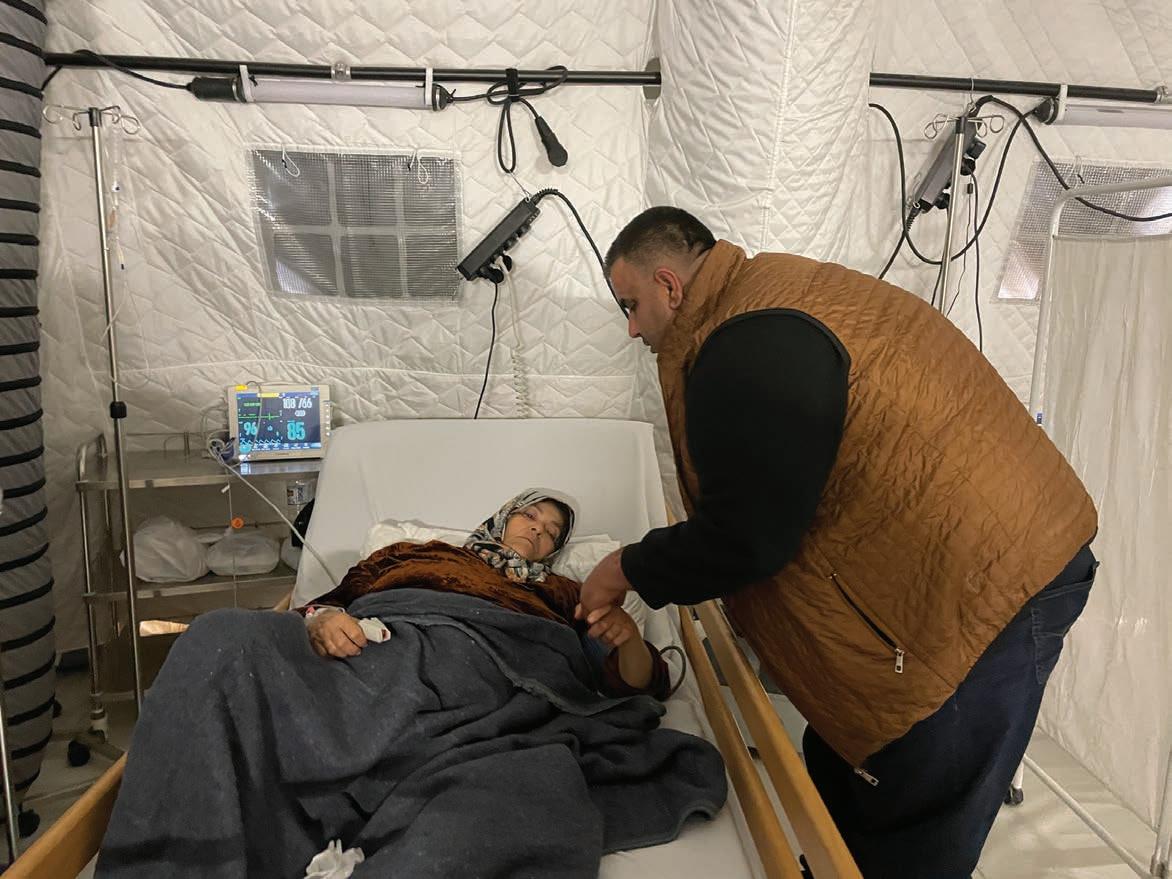

repair of the sanitary facilities and dispose of the waste.
• We build latrines and take care of their maintenance.
• We distribute hygiene kits to families.
• A total of 126 households bene ted from our help.
Food security and improving living conditions:
• 982 households received food baskets.
• 10,103 households received ready-to-eat meals.
• 100 households received cash for food.
• 1,300 farmers received agricultural inputs, fuel for irrigation and training to improve growing conditions.
• 200 households run by women are involved in income-generating activities and support the farmers with the harvest.
• 100 households run by women received equipment and training in vegetable processing.
• 100 households received non-food item kits (including bedding, hygiene kits, kitchen sets, heaters and fuel).
• 1,213 households received drinking water.
Child protection:
• 150 children receive psychosocial support in child-friendly spaces.
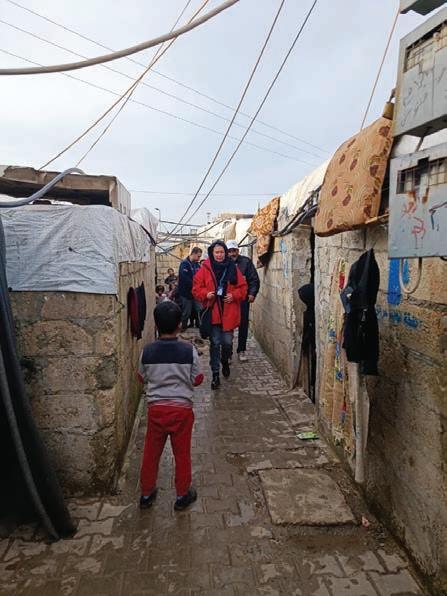
Looking back at the history and the current works of the Polish Association tells an amazing story of courage and service.

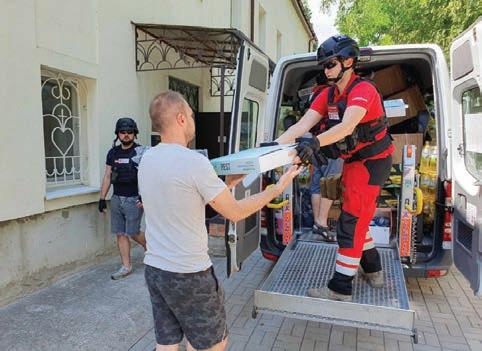

The Polish Association of the Order of Malta presently counts 140 members and about 1200 volunteers. e history of the Polish Association is quite complex. e rst Hospitallers came to the Polish territories in the 12th century, but the Polish Association was created only in the 20th century. Before regaining independence in 1918, the Poles had the possibility to belong to the associations in other countries or in gremio religionis. e Polish Association was formally registered in 1920, but when the communist took the power a er the second world war, the Association was delegalized in Poland and it had to operate abroad, mainly from London and Rome. Only in 1992 it was reactivated in Poland and since then it has built up a sizable network of projects in several cities from the scratch.
In Warsaw-based Assistance Center, the Order’s volunteers prepare and distribute meals to about 40 people twice a week and they hold meetings three times a week for a group of 30 elderly (games, gymnastics, painting, prayer etc).
In Barczewo (northern Poland), a hospital created by the Polish Association provides palliative medical services to 77 patients with neurological conditions, including 15 patients requiring extensive ventilation and 40 patients in a coma or with a minimal cognitive capacity.
In Kraków, Assistance Centre for Disabled Children and eir Families provides a range of specialist services such as speech therapy, autism care, mental and health care. Preschool daily rehabilitation activities are o ered to about 70 children. During 15 years of activity, over 8,000 families with disabled children have been assisted.
In Poznań, the Polish Association’s Centre for Geriatrics and Gerontology’, co- nanced by the city of Poznań, provides support to about 450 patients each year. Also, in Poznań, there are occupational therapy workshops for 50 people with intellectual disabilities. In a nearby town, Puszczykowo, the Polish Association runs a Social Welfare Home for 25 patients with mental and intellectual disabilities, who come for daytime stays.
In Katowice, the Polish Association runs e Educational Assistance Centre. Katowice is also the hometown of the Polish Association’s relief organisation, (MSM – Maltese Medical Service) who works with the homeless, people with disabilities, the elderly and the lonely. Basic rst aid training and quali ed rst aid courses are also organised, as well as the provision of emergency medical care at cultural, sporting, and religious events. 300 medical and paramedic volunteers of the MSM work in 16
Le : Dating back nearly a century ago, ooking at all the work e Polish Association have done to assist poeple in need.
Right: Map of Poland and locations of facilities.

branches across Poland. Each of the branches is sta ed by quali ed professionals, including doctors and nurses trained in the emergency medical care system, as well as paramedics, educators, psychologists, and people trained in providing quali ed rst aid.
In Szyldak (northern Poland), Social
Welfare Home’ treats 100 inpatients with schizophrenia and 16 outpatients. ere are 50 sta , most of whom are quali ed therapists.
In Szczyrzyc (southern Poland), holiday weekly camps for people with disabilities are held every summer. In 2023, 96 volunteers
of the Polish Association took care of 56 participants in a picturesque abbey in the mountains.
ere are also annual events organized by the Polish Association:
• Christmas Charity Events –these are dinners and gi s for the needy, organized around Christmas time across Poland, Ukraine, and the UK. In 2023, they were held in 35 locations for 3325 people, including three locations in Ukraine and three in the UK.
• Charity concerts – two concerts were organized in 2023, in Poznań and in Katowice, and the proceeds were donated to the charity projects of the Polish Association.
ere is also a UK branch of the Polish Association in London, called the Association of the Polish Knights of Malta. It runs a soup kitchen, undertakes numerous initiatives to assist the poor and the lonely, and is active in the formation of Cadets (60 young people in three cities).
From 2022, the Polish Association has been facing a huge challenge of how to address the needs of the people eeing from Ukraine due to the Russian attack. From the beginning of the Russian aggression, 9.36 million refugees crossed the border into Poland. Currently, there is about one million refugees remaining in Poland.

e Polish Association launched a programme of aid to Ukraine on the rst day of the war, i.e. 24 February 2022. e total assistance to date is worth more than 100 million PLN (EURO 22M), and it has been largely possible due to the nancial support from the national associations of the Order of Malta around the world. All the donor funds were transferred to, and e ciently managed by the Polish Association’s medical relief organization, Fundacja Pomoc MaltańskaMaltańska Służba Medyczna (MSM).
At the beginning of the war, the polish association provided spontaneous assistance by helping to receive, feed and provide medical aid to refugees at the train stations and border crossings. about 300 volunteers of the polish association engaged in collection and distribution of food, medicines, blankets, sleeping bags, etc. which were sent to Ukraine. 2 logistics centres were created, sorting the donations from 13 collection points. 519 transports with material support were sent to Ukraine. e medical teams and volunteers provided help at 6 points of medical and social assistance at the railway stations and at the border with Ukraine. 3 000 people were evacuated and 350 were accommodated.
As the war progressed, several main long-term projects were identi ed and are continued:
1. Career assistance and psychological aid in the Center of Professional Activation in Katowice (107 individuals participated in job training programs, out of whom 45 individuals found new occupation).
2. Organization of community centers for families and children (107 participants in Katowice, in Poznań psychological assistance for 420 adults and children and care for 202 children).
3. Organization of Polish language courses, necessary requirement for nding jobs in Poland for 4,975 people (Warsaw, Poznań, Katowice).
4. Specialized medical assistance for 225 Ukrainian children with disabilities at the Order of Malta

Center for Assistance to Disabled Children and eir Families in Cracow.
5. Rehabilitation of 38 unwell Ukrainians at the Polish Association hospital in Barczewo.
6. Organization of recreation for families and children (200 people assisted in Kraków, Gdańsk, Katowice, Poznań).
7. Financing of school meals for 9,135 children in four cities.
8. Aid project in cooperation with the Polish Ministry of Foreign A airs - delivery of 12,750 food parcels to Ukraine.
Since it becomes more and more di cult to put together assistance projects for the Ukrainians as the donations decrease with time, the Polish Association received with gratitude a recent donation from our friends from the Australian Association. It is very appreciated, and it will be devoted to addressing the most urgent needs of the refugees.
Le : Members and Volunteers of the Polish Association teaching rst-aid to a child.
Bottom le : Looking at one of the Order of Malta facilities.
Right: A member serving.
Bottom: A photo of a Polish Association van.


Pope Francis has appointed the Reverend Monsignor Luis Manuel Cuña Ramos as the new Prelate of the Sovereign Military Order of Malta on 21 December 2023.
Monsignor Cuña succeeds Monsignor Jean La tte, appointed Prelate of the Order of Malta by Pope Francis in July 2015. e Order of Malta’s Grand Commander Fra’ Emmanuel Rousseau thanked Monsignor Jean La tte for his eight years as Prelate of the Order, wishing him “a fruitful ministry for the future”. For his part, Monsignor La tte expressed his “gratitude for having been able to serve the Order throughout these years. It has been an honour and a joy”.
Many members of the Australian Association and Associations in Asia Paci c have met Monsignor La tte in Lourdes and in the Asia Paci c Conferences as well as in the 2023 Assembly of the Australian Association. We express our thanks to him for the spiritual care he had given to our Chaplains and to members. We know he took particular care in developing his homilies for the many Masses he presided over for us. Many warm memories will be with us for a long time. Monsignor La tte’s nine years as our Prelate had been intense
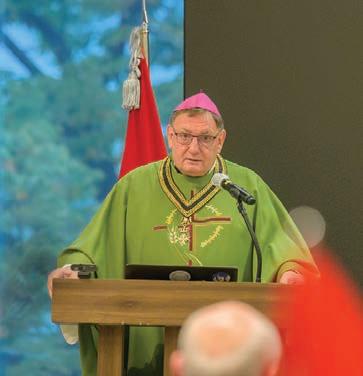

with work taking him to most of the Associations around the globe.
We welcome Monsignor Cuña and look forward to many years of friendship with him.
He was born in 1966 in Orense (Galizia) in Spain, and has spent most of his life in Italy, mainly in Rome, where he was awarded a doctorate in Ecclesiastical History and carried out archival studies. He was ordained a priest by St. John Paul II on 14 June 1992 for the diocese of Orense. A er spending two years in his diocese, he returned to Rome to work at Propaganda Fide Historical Archives, where he remained for almost a quarter of a century. He was a visiting professor at the Ponti cal Urban University and at the Ponti cal Gregorian University. Since 2012 he has served as historical consultor of the Dicastery for the Causes of Saints. ree years ago, he returned to his hometown to serve as Episcopal Delegate for the Cultural Heritage of the Bishopric of Ourense.
Since 2013, as Magistral Chaplain and Spiritual Caregiver, he has actively participated in the Order of Malta’s works, as well as taking part in its numerous pilgrimages to Lourdes and Loreto.
Monsignor Cuña succeeds Monsignor Jean La tte, appointed Prelate of the Order of Malta by Pope Francis in July 2015. e Order of Malta’s Grand Commander Fra’ Emmanuel Rousseau thanked Monsignor Jean La tte for his eight years as Prelate of the Order, wishing him “a fruitful ministry for the future”. For his part, Monsignor La tte expressed his “gratitude for having been able to serve the Order throughout these years. It has been an honour and a joy”.
According to art. 22 of the Constitution, the Prelate is responsible for the Order’s clergy in the exercise of their priestly function and ensures that
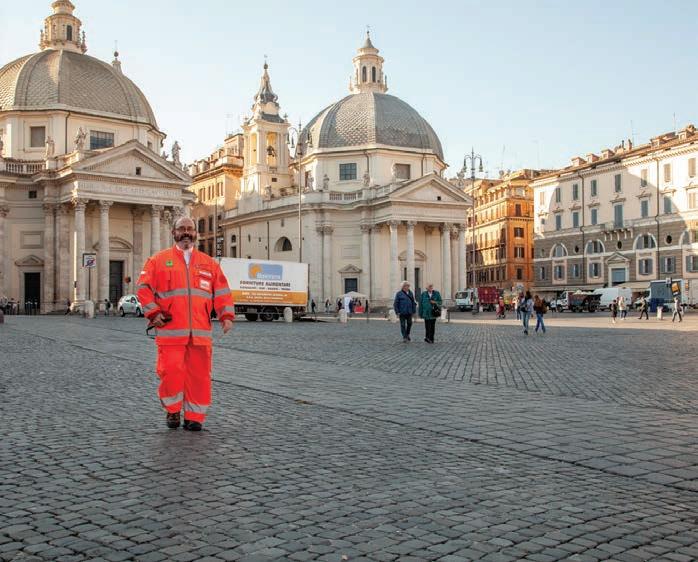
the religious and priestly life of the chaplains and their apostolate is carried out according to the Order of Malta’s discipline and spirit. He supports the Grand Master, the Grand Commander and the Coordinator of the Second Class in supervising the religious life and devotion of all members and all aspects relating to the spiritual nature of the Order’s institutions and works. e Prelate is appointed by the Supreme Ponti a er consulting the Cardinalis Patronus. At each session of the General Chapter and the Chapter of Professed, the Prelate presents a report on the spirituality of the Order’s clergy.

By Michelle Rees
Looking at the wonderful work done by our volunteers for young people with disabilities, the tradition of our youth camps continues at Benedict XVI Retreat Centre, Western Sydney.
In November 2023, the fourth Order of Malta Australia Camp for Disabled Youth was held in Sydney. is camp was by far our biggest yet, with disabled guests travelling from across Australia to experience three days of unique challenges and activities in a supportive, fun environment.
e Order of Malta Youth Camps aim to bring together young people with
disabilities, volunteers and carers to experience of fun, form friendships and overcome personal barriers. To ensure the camps are accessible to all disabled youths aged 18 – 35, we provide accommodation, food and activities at no cost to the participants.
Participants at the 2023 camp included some experienced guests and carers who have attended our previous
camps and some anxious but excited rst-time attendees who. e guests were also supported by our Order of Malta volunteers that included students from Australian Catholic University.
On day one, the 87 participants were welcomed at Benedict XVI Retreat Centre, Grose Vale at lunchtime and were quickly thrust into action with ‘Survivor Olympics’ which involved games and challenges
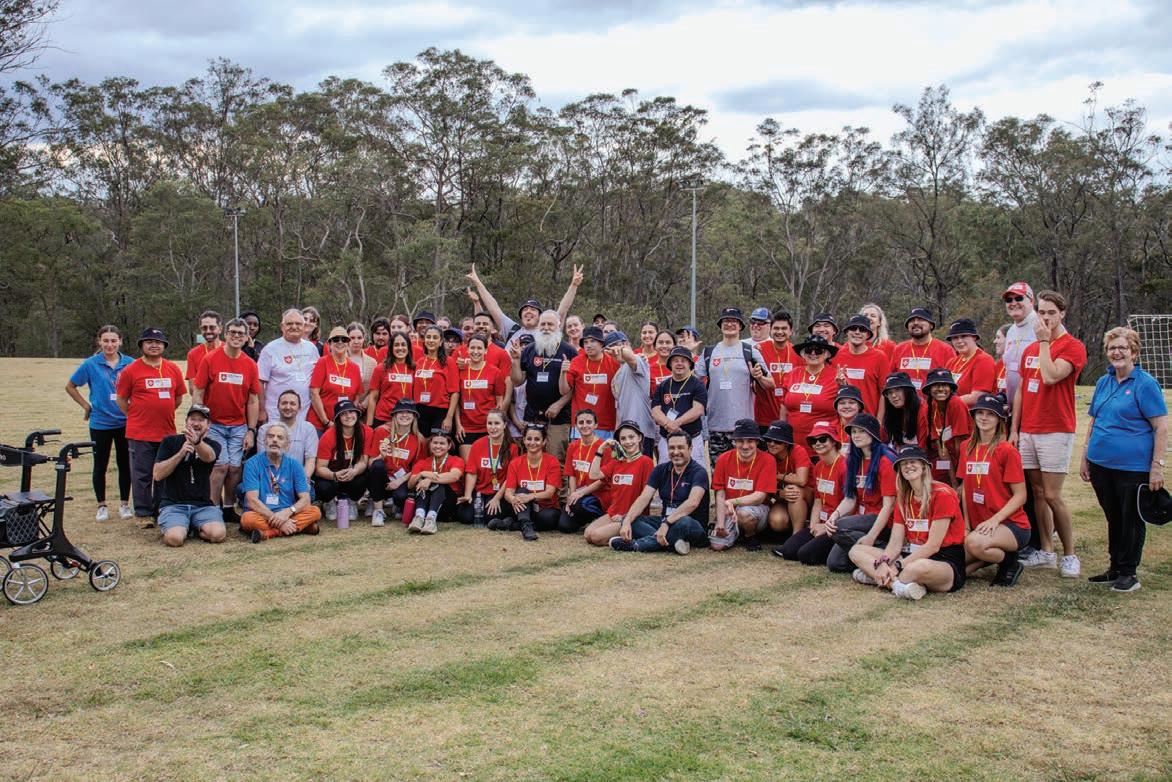


that focused on teamwork and fun and provided an excellent icebreaker for our newcomers. e focus on teamwork then followed into the evening with a Superheroes and Villains emed Games Night – complete with many campers wearing fancy dress for the occasion.
e following day involved attendees facing personal challenges as they travelled o site to Treetops Adventure Park for an actioned lled day of activities. is experience challenged participants both

mentally and physically as they overcame the aerial obstacles on the tree ropes courses and braved Australia’s fastest Zipcoaster. ere was a strong feeling of camaraderie amongst the participants as they provided support to each other as they completed the challenges.
Day two was rounded out with the always popular camp disco in the evening, themed ‘Wild West’ where guests, carers and volunteers danced the night away.
On the nal day, a er a hearty breakfast, Mass, some cra and games and a farewell lunch we said “goodbye’ to our very happy group of campers, with new friendships made and old friendships renewed – and many asking when the next camp will be!
e Order of Malta Australia hopes to undertake a Camp for Disabled Youth annually should funding permit. Each camp costs approximately $50,000 to host.

Michèle Rees talks to e Order of Malta Palestinian Ambassador Michel Bowe about the current situation with the Holy Family Hospital in Bethlehem and the current regional crisis.
In the traditional Christmas Eve Mass, Pope Francis reiterated his call for peace. “Our hearts are in Bethlehem” he cried out while cautioning against the pursuit of worldly success and power. In the city of Bethlehem, each December, Manger Square hosts a life-size nativity scene, illuminated by stars and a threestory Christmas tree. Liturgical choirs perform most nights, and the Christmas market draws visitors - Christian and Muslim alike - from all over the region and around the world. is year is di erent. “Bethlehem is locked down behind the Israeli separation wall and many
additional manned checkpoints. Most of the workforce has no salaries or work because of the closure and the absence of pilgrimages. While the war is over 40 miles away, Bethlehem su ers not from ghting or bombing, but from the halted economy” says Michèle Bowe, Ambassador of the Sovereign Order of Malta to Palestine.
Despite the cancellation of nearly all Christmas festivities by authorities, Catholics gathered at the Church of the Nativity last Sunday for Midnight Mass on Christmas Eve.
“ is year Christmas is very much like that rst Christmas 2,000 years ago.
No gi s, no celebrations, no reworks, or festivities – just a baby born on a deep winter night under a bright star. e families of Bethlehem will celebrate Christmas with Mass, prayer and sacri ce as requested by the Patriarchs. Christmas will be sombre, re ecting on the recent events in Israel, Gaza, and the West Bank. But Christmas will not be without hope” explains Ambassador Bowe.
Only a few steps away, the Holy Family Hospital is taking care of babies and mothers as it has done for the past 34 years delivering over 4,600 babies each year. Two 12-hour shi s are being implemented

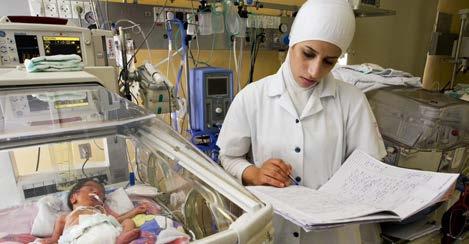

to limit sta travel. Nurses and doctors who live far out of the city have housing provided. Every measure is taken to ensure that the hospital’s personnel remain safe. e number of births has slightly decreased in the past two months, with nearly 4,000 babies born in 2023. Likewise, there has been a fall in the number of consultations due to the di culty of the patients living outside the urban area of Bethlehem to access the hospital.
“ e midwives, nurses and doctors stand ready to care for the most complicated deliveries and the mothers know to expect the very best care delivered without regard to need or creed. Some mothers, because of travel restrictions, are not able to reach the Hospital to deliver their babies

as travel is dangerous at night. ey will deliver at home, without medical care” says Michèle Bowe, highlighting the risk associated with home births and lack of medical assistance, one of the many consequences of the war.
Over 70% of the Bethlehem population was born at Holy Family Hospital, today the largest employer and trainer of medical professionals of the whole region. It is the only hospital in the region medically equipped to deliver babies born before 32 weeks. Holy Family Hospital is o en asked to accept the Bethlehem region’s most challenging medical cases. As a result, approximately 9% of all newborns delivered at the Hospital require neonatal intensive care.
Amid the sombre new realities of life in Bethlehem, the atmosphere within the Hospital remains hopeful. Despite the fear and anxiety surrounding the war in Gaza, the birth of a new baby is still a cause for celebration.
Splendour & Devotion: e Art
Collections of the Order of St John, eresa Vella.
Produced by Fondazzjoni Patrimonju Malti
Published by Kite Group
Publication date 26 April 2023
Forward by Tatiana String
e rich history of the Order of St John is o en told through descriptions of important battles and the deeds of heroic men. e loss of Rhodes, the granting of Malta to the Knights by Charles V, and the Great Siege, are perhaps the most signi cant markers in the history of the Order in the early modern period. It is therefore exciting to discover an alternative approach to the history of the Order through the lens of art appreciation, collecting and display.

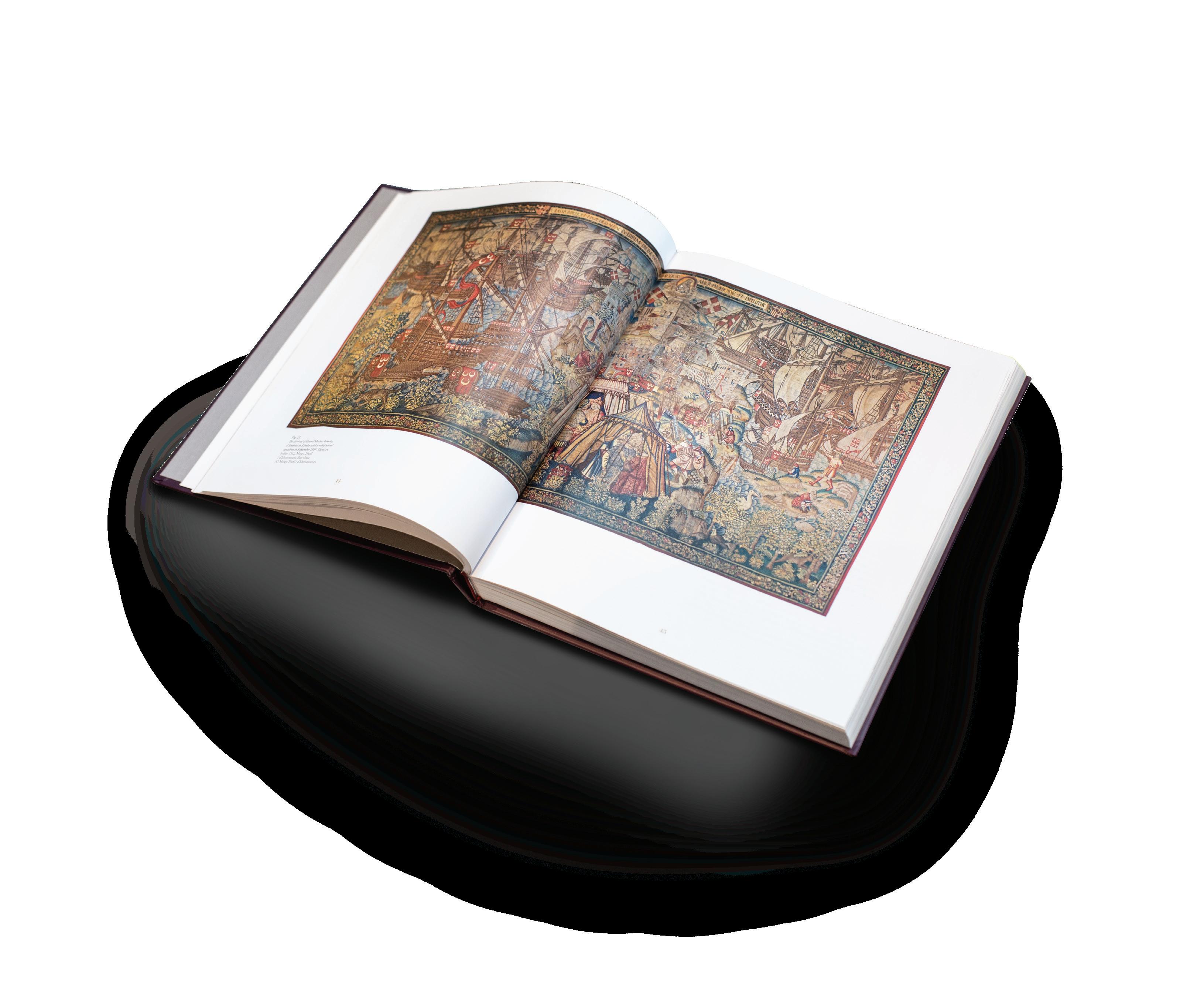



chooled in the culture and taste of the aristocratic class from which they came, and, equipped with a deep and intuitive understanding of the impact and importance of the contemporary concepts of magni cence, the Knights, who came from across Europe and made Malta their home, furnished their new apartments and palaces with painting, tapestries, maps, and works of sculpture. ey were keenly aware of the power of images in the construction of an elite identity that combined martial masculinity with a sense of cultural re nement and aesthetic appreciation.


eresa Vella’s book elegantly situates the collections and collecting practices of the Knights of Matla in the wider European context, while identifying the ways in which the Orders priorities and tastes were distinctive. Vella’s careful and penetrative research into a rich body of source material, especially inventories, wills, and correspondence, draws the reader into what it was about the Knights experience that was distinctive and speci c to them, while also placing them in the larger framework of European elite culture. Vella is immersed in the scholarship of both the Maltese situation and broader trends in continental art collecting.
e history of collecting has in recent years become an important and fascinating aspect of art historical scholarship; and Vella’s book is a major contribution to the eld. More and more, art historians ask questions about the “biography” of objects:
how they came to be commissioned, the conditions in which they were displayed, the terms in which they were appraised and commented upon, how they passed one collection to another, were bequeathed in wills, auctioned, or relocated, and even how they were discarded or lost - all these are issues that are central to both this book and current art historical practice. Vella has produced a rich study that is, therefore, timely and signi cant.
ere are revelations here that, through the author’s careful combining of their archive, contribute to our knowledge of, for
present in collections both in Malta and abroad in the Order’s commanderies. ere are also important identi cations of artists working for the Knights of Malta, and even artists who themselves became Knights. e recognisable name of Caravaggio appears frequently in the record, and his Maltese works are considered here alongside those of understudied artists whose careers were spent entirely in the service of the order. We are treated to scholarly discussions of works of art that portrayed the great men of the Order and visually commemorated its key events.

Over 2023, the Australian Association mourned the loss of ve members. We record the life stories of those members: David Jackson, Dr. Maria erese Virachanee Phromsuntorn, Dr. Ian Marshall, Joseph Borg, Monsignor Robert Aitken and Antony Macken.
By Hon James Douglas KHD KC
Confrère e Hon David Jackson KMG AM KC died on 15 May 2023. His death was not expected although his general health had su ered in recent years. He had been a member of the Order for very many years including a period as national president from 1984 to 1987. He continued to contribute to our work all his life and was a much loved and valued adviser, particularly from my point of view in matters related to constitutional changes to the Order, but also as an astute and informed observer of our place in the life of the Church in Australia and the world.
I knew him or of him for almost 60 years since I rst heard of him in my teens from my father. He was then popularly regarded as one of the most capable rising junior barristers in Brisbane. I believe it was my father who encouraged him to join the Order in the rst place. His later career, for a brief time on the bench of the Federal Court and then at the bar as a pre-eminent silk in Sydney, only con rmed his early promise.
As the Australian Bar Association president, Peter Dunning KC, said in notifying its members of his death:
• ‘Today is a signi cant day in the life of the Australian Bar, marking as it does the passing of a pre-eminent silk of nearly half a century, and the nest constitutional and High Court barrister of a generation, indeed arguably since Federation.
• David was an extraordinary advocate. e many who had the privilege of working directly with, or against, him are better judges and barristers for it. e many more who did not have the occasion of dealing directly with David will nonetheless have had their professional lives touched for the better because of the impact of his advocacy across the gamut of legal controversies before courts in their constitutional or appellate jurisdictions.
• David leaves an enduring legacy on the development of the law in Australia and the cra of barrister by his lived example
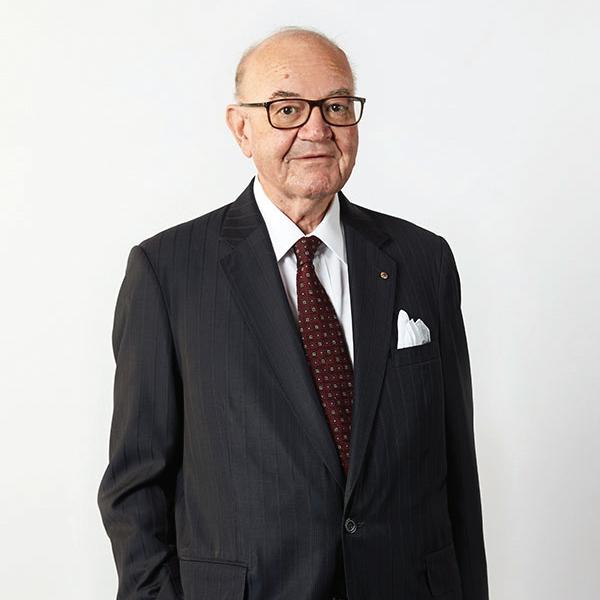
that the nest advocacy is the product of skill, industry, propriety and courtesy in equal measure.
• David was encouraging to barristers young and old, a loyal friend to many, extraordinarily generous and had a ne sense of humour.
• David lived as he worked. He was a loving and devoted husband to Monica, his wife of more than y years, father to their three daughters, Catherine, Dominique and Louise, and grandfather to their four grandchildren. On behalf of the Australian Bar Association, I express my deepest sympathy to them on this sad day.’
In delivering the eulogy at his funeral in St Mary’s Cathedral on 25 May 2023, the then Chief Justice of Australia, the Hon Susan Kiefel AC, remembered him with great admiration and a ection stemming from her early days at the bar in Brisbane to his last appearance before the High Court in 2022. She too said he was one of the nest advocates to appear in the High Court and stressed the importance he placed on Monica, his wife, his daughters and his life with his family whom he so
dearly loved. He was always courteous and generous to young barristers and a wonderful host. Justice Kiefel also reminded the congregation of his membership of the Order and said he was committed to charitable works.
Many of our members will remember him vividly for his contributions to the Order and value him for his friendship, sparkling wit and conviviality. Please pray for the repose of his soul and for his widow, Monica, their three daughters and four grandchildren.
Devoted to God, Dr. Maria erese Virachanee Phromsuntorn dedicated her life of servitude for the Church and the Society. We remember her as a perfect example of a devout Catholic who lived a virtuous life serving God. She is loved for her warm and caring dispositions and valued for her many important contributions to the Church and the society whose legacy will always remain.
Dr. Maria erese Virachanee Phromsuntorn was born on 27 June 1944. She had three siblings. She was married to Mr. Joseph Marie Suwat Benjatammatorn. Her only daughter, Dr. Maria erese Piyada is married to Dr. Joseph Chaipat Wattanasan, who gi ed the family with 3 daughters, Ms. Maria erese Kanitvipa Wattanasan, Ms. Maria Agatha Kanitpirom Wattanasan, and Ms. Frances Marie Boonyanaree Wattanasan.
Dr. Maria erese Virachanee was passionate about Education. She founded St. eresa International School in Bangkok and St. eresa International College in Ongkharak, Nakhon Nayok, ailand which o ers international Bachelor, Master, and Doctorate Degrees. Under her stewardship, the college produces competent and virtuous graduates through high quality education based on the teaching of the Church. She ensured that St. eresa International College, a Catholic Institution, is the center for evangelization in which everyone at the college can be close to God. She fully supported on Catholic fellowships at the college, gave scholarships to needy Catholic Students, and provided complimentary Bachelor and Postgraduate courses to Priests and Sisters.
In 2018, Dr. Maria erese Virachanee was appointed as the Order of Malta ailand President, a role she held until the end of 2022. Under her leadership, the Order of Malta ailand expanded and rose to greater heights. Her superb organisation skills brought the delegation numerous achievements such as nancial governance policies, the Order of Malta ailand Safeguarding Policy, the registration of Order of Malta ailand with the ai Ministry of Interior, the Order of Mata ailand website, and the hosting of the highly successful 11th Order of Malta Asia Paci c Conference and Investiture in ailand.
Dr. Maria erese Virachanee’s keen ability to engage and inspire others resulted in the Order of Malta ailand’s numerous successful humanitarian for the Sick and the Poor. Especially for the
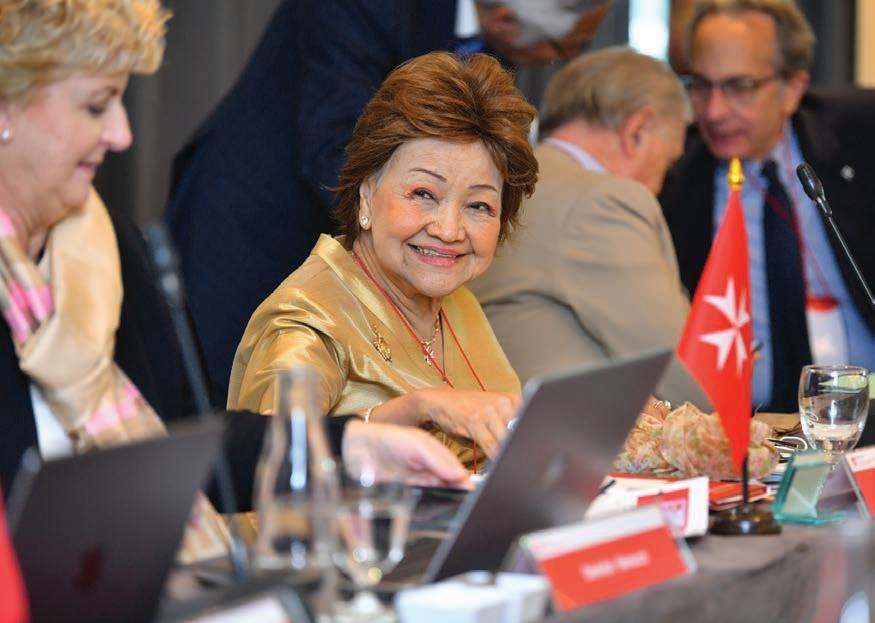
elderly, she secured a partnership with the Global Funds for Forgotten People and the Faculty of Nursing Science of St. eresa International College to provide elderly care at the college and in the surrounding communities with over 100 St. eresa International College nursing volunteers.
Dr. Maria erese Virachanee’s graceful diplomatic skills won great cooperation from religious organizations, such as Caritas of the Catholic Bishops conference of ailand, the diocesan humanitarian organizations, and the Camillian and Xavierians congregations for Order of Malta ailand’s e orts to serve the Sick and the Poor.
Beyond her accomplishments with the Order of Malta ailand, Dr. Maria erese Virachanee devoted her life to serving the Church. She served as the President of the Catholic Association of ailand, President of the Elderly Association, Chanthaburi Diocese, Vice President of the Catholic Business Executive Group (two terms), Executive Committee member of Catholic Social Communications of ailand, Executive Committee member of the Catholic Education Council of ailand, Executive Committee member of the Desk of the Laity, Catholic Bishops Conference of ailand, Executive Committee member of the St Louis Hospital Foundation, Pastoral Council executive of Phra Phu Tai Saowapa
Church, and member of the Committee for Catholic ai-English Glossary. She was a great philanthropist and an avid fundraiser for the Church. roughout her life, she supported the Seminaries in ailand, and for over 30 years, she raised funds for the Catholic Social Communications of ailand.
For her devotion and service for the Church, Dr. Maria erese Virachanee was granted the honor of the Dame of e Ponti cal Equestrian Order of Saint Gregory the Great by Pope Emeritus Benedict XVI.
During the past three years amidst the Coronavirus pandemic, Dr. Maria erese Virachanee endured the colorectal cancer that spread to her lungs and liver. She reposed on the morning of 5 March 2023 while her Husband, Daughter, Son in law, and granddaughters lovingly attended and prayed for her by her side until her nal moment.
At the Requiem Mass for Dr. Maria erese Virachanee, Members of the Order of Malta honored her with the Order of Malta procession. She laid in eternal peace adorned with the Order of Malta ag.
Dr. Maria erese Virachanee’s extraordinary legacy of devotion to God and deep compassion for others will forever inspire us to live a virtuous life to serve God and his people. May she Rest in Eternal Peace with God in Heaven.
DR IAN MARSHALL
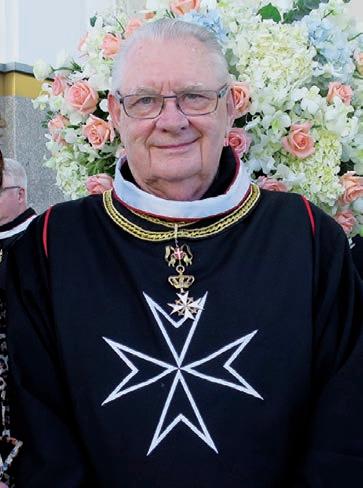
For thirty years Ian gave so much to the Order of Malta that it is di cult to encompass it all in a short tribute on behalf of the Order and its members. e Order of Malta or to give it its correct title, e Sovereign Military Hospitaller Order of St John of Jerusalem, of Rhodes and of Malta was established over 900 years ago in the Holy Land, at the time of the Crusades. It is a lay religious order of the Catholic church.
Its motto is ‘Tuitio Fideo et Obsequium Pauperum’ meaning ‘Defence of the faith and care of the poor and the sick’.
Ian, with his education through the Sisters of Mercy, the Presentation Sisters and the Christian Brothers and then his chosen career as a GP could have made the Order’s motto his own long before he was persuaded, somewhat reluctantly, to become a member of the Order in 1993.
Ian’s entry to the Order came by way of the Beaudesert Race Club that raised funds for Boys Town. Here at Beaudesert Races, through Bernie Knapp, he learnt of the Order and its involvement in Mt Olivet Hospital, now known as St Vincent’s Hospital. Mt Olivet Hospital was the rst in Queensland to recognise the need for education of GPs in the provision of Palliative Care and in providing care for the dying in their homes. Ian was part of this program recognised today as so essential in the provision of the highest quality of patient care.
A er some initial reluctance, Ian joined
the Order in 1992 through the persistent and obviously persuasive invitation of James Archibald Douglas, father of current president James Sholto, Tess Cramond, and Kevin King who were the early members of the Order of Malta and also committed to the Mt Olivet Palliative Care program,
Ian became Chairman of e Mt Olivet Charity Committee, the hospital’s major fundraising venture each year, and Founder and Chairman of the “Friends of Mt Olivet Committee”. Ian went for the bigger and better in race day fundraising and the annual Mt Olivet race day at Eagle Farm provided much needed funds for the hospital. rough these endeavours as well as through his professional involvement, Ian ensured that the motto of the Order, the care of the poor and the sick was put into practical use at a time when Palliative Care was not as well established as it has now become, and Mt Olivet Hospital continued as a signi cant focus for the Queensland Branch of the Order.
Just two years a er joining the Order, Ian became the State President in 1994, a position he held for more than a decade. In 2009 he was appointed the National Hospitaller, a position responsible for the oversight of the Order’s charitable and humanitarian works in Australia and its near neighbours.
Over this time when Ian was State President and then National Hospitaller, the Order provided funds for the formation of Priests through support for seminaries in Brisbane, in PNG and in the Solomon Islands; and directly through the Australian Defence Force Diocese. It supported e Christian Brothers Callan Services in PNG, especially the Centre for the Blind in Goroko and supported education in Palliative Care nursing at the Australian Catholic University. e Coats for the Homeless project was initiated during this time.
Ian was critical with support for the work of Ambassador David Scarf in Timor Leste in developing a clinic and other activities in Dili. Ian and Judith both visited Dili to personally oversee what was being achieved.
e clinic provides medical care and health education to the nancially disadvantaged with a focus on the care of women and children.
In 2013 Ian was appointed President of the Australian Association of the Order during a period of signi cant change and
a little unrest within the structure of the Association.
During his time as National President, the development of the Asia Paci c Conference was an endeavour close to Ian’s heart. It saw the Order established in Singapore, Hong Kong, ailand and Korea in addition to its earlier presence in the Philippines.
In 2011, in acknowledgement of Ian’s ongoing charitable and humanitarian work he was created, by Pope Benedict XVI, a Knight Commander with Star in the Ponti cal Equestrian Order of St Gregory the Great.
In 2013 Ian was promoted to the rank of Knight Grand Cross of the Order of Malta and awarded with the Grand Cross of Merit in 2018 Ian retired from his position as National President in 2019 when an election was held for a new Executive Council.
Ian’s commitment to the Order was exempli ed by his decision to take the Promise of Obedience. When discussing this decision with another member Ian said that if the Order requested him to do whatever is needed, he would not hesitate. So taking the Promise of Obedience was never of concern. e Order of Malta, its good works, its many strategic seminars and conferences around the world were committed to by Ian with the same singular purpose of obedience which made him a member of the Subpriory of the Immaculate Conception.
Ian’s involvement in the Order of St John of Jerusalem, of Rhodes and of Malta would not be complete without reference to the annual Lourdes pilgrimage. On the rst weekend in May each year members of the Order from around the world, accompanied by their malades or sick, descend on Lourdes in France. It is a weekend like no other, an emotional and spiritual experience as well as one of practical involvement in caring for the malades. Ian, o en accompanied by Judith, journeyed nine times on this Lourdes expedition.
Ian’s life was indeed well lived and his contributions to the Order, to the Church and to his fellow human beings were outstanding and the extent of those who bene tted from his endeavours cannot be counted. But he knew that he could never have done what he did without the support of many members and friends.
Ian, we love you dearly and pray that as you enjoy eternal reward we, the members of the Order of Malta, are truly grateful to you.
Joseph Borg was a true Renaissance man with a big heart. Born in Malta at the start of World War II, Joseph emigrated to Australia with his widowed mother and siblings at the age of 15. He could not be persuaded to continue his secondary school studies, but insisted on going to work to help support the family. He started work at the Commonwealth Aircra Corporation, and although not an apprentice, he took great interest in what the apprentices were doing and helped them by pointing out and correcting the errors they were making. An inspector noticed Joseph’s intelligence and encouraged him to sit for the Commonwealth Apprenticeship Commission examination, which he passed easily. Joseph then became an apprentice and began to attend night school at the Swinburne Technical College. Over time Joseph became an excellent tter and turner, draughtsman and tool designer. Having obtained a Diploma in Mechanical Engineering from Swinburne Technical College, Joseph joined the Hume Pipe-Making Company, where the management recognised his potential and paid for his studies at the University of Melbourne to obtain a degree in Mechanical Engineering. Joseph distinguished himself in many elds and positions of responsibility and successfully managed the Steel Mains Plant in Somerton in Victoria. He also did the engineering design and calculations for numerous steel sculptures in and around Melbourne.
Quite apart from his work and studies, Joseph, at such a young age, took on the responsibility of being a surrogate father to his younger brothers. Playful, curious and with an abiding love of learning, Joseph ensured that his brothers had a full and happy childhood. He resurrected a 30s era valve radio which gave many hours of enjoyment listening to radio shows and classical music. He built a telescope so that his brothers, nieces and nephews, children and grandchildren could be introduced to the wonder of the night sky. He made self-propelled tanks using cotton reels clothes pegs and rubber bands, toy planes, a billy-cart, not just to have fun with, but also to enable understanding of the principles behind them. roughout his life he always had a mechanical pencil in his pocket, which he would use to draw, design and explain complex issues on whatever was to hand, be it a paper napkin, menu or program.
Joseph had an astonishing range of interests, not only in the various branches of mathematics, but also in chess, geology, botany, archaeology, astronomy, history (especially Maltese history), classical music, opera, painting, sculpting, photography, and languages. He became a dedicated member of the Catholic Walking Club and took great
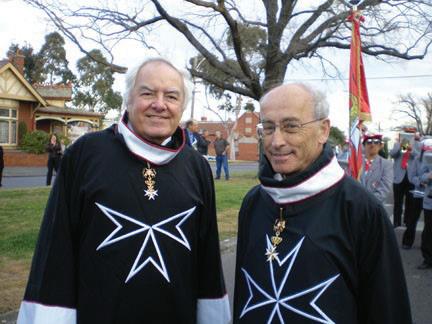
joy in the Australian bush with its unique ora and fauna, introducing his brothers and other members of the family to its great beauty. It was through the Catholic Walking Club that Joseph met the love of his life, Frances, whom he married in 1967. Joseph was ercely proud of their ve daughters and sixteen grandchildren. He was supportive and encouraging in their lives and learning, was joyful in their success and caring in their times of need.
Joseph founded the Maltese Historical
Association, giving lectures himself on many topics, ranging from the design of the forti cations in Valetta to Maltese nicknames. He contributed to the welfare of Maltese migrants as President of the Maltese Community Council of Victoria. Joseph had an unparalleled knowledge of the geology, archaeology and history of the Maltese islands and acted as an informal tour guide to many members of his family and friends who were fortunate enough to enjoy this experience.
Joseph was a very active member of the Order of Malta. He provided tutoring in mathematics to refugee children as part of the Friday Night School. He attended the Lourdes Pilgrimage. He also volunteered to document the life stories of people in palliative care as part of the biography program of Eastern Palliative Care. He visited the sick and elderly, and assisted with the monthly Masses in the Homes for the Aged. Joseph had a strong sense of justice, and would stand up fearlessly to bullies. He was clever, loyal, supportive, generous and will be greatly missed. May he rest in peace.



Monsignor Robert Francis Aitken was appointed Magistral Chaplain in the Order of Malta on 18 February 1991. He served the Order of Malta with compassion, gentleness and faith. He is remembered by members of the Order in SA as a gi ed homilist, a man of deep wisdom and as a servant of the Church dedicated to serving Our Lords the sick and the poor and in strong defence of the faith. Monsignor was a gentleman and gentle man of immense compassion and faith who profoundly in uenced the lives of all members.
His passing is with deep sadness and great joy for having known and loved this humble servant of Our Lord.
e Southern Cross Catholic Newspaper provided the following (edited) details of Monsignor’s life in a tribute published December 11 2023
Robert Francis Aitken was one of four
children born to Winnifred (nee Grealy) and Raymond, a brother to Margaret and Sr Robert (both deceased), Peter and Don. His devout nature was noticed by the parish priest and when he was 14, his mother received a letter asking if Robert would consider the priesthood.
In 1943, he joined St Francis Xavier Seminary in Rostrevor where his mother would visit him once a month. During the holidays he worked at the jam factory to help support his family. Robert completed his theological studies at Corpus Christi College in Werribee, Victoria. He was ordained a priest in St Francis Xavier’s Cathedral on July 22 1952.
His rst appointment later that year was as assistant priest at Croydon where he was well known for riding his bicycle around the parish and was chaplain to the Young Christian Workers Movement.
In 1957, he was appointed assistant priest in the Adelaide Cathedral parish and thus began his long association with the Cathedral. 10 years later he was appointed administrator of St Francis Xavier’s Cathedral, a position he held for 30 years, including when he was appointed Vicar General in 1980.
e same year the Pope bestowed on him the title of Monsignor, for his services to the Archdiocese, and was declared a ‘Protonotary Apostolic’, the rst Australian priest to receive this honour.
During his time at the Cathedral Mgr Robert demonstrated great hospitality at the Archbishop’s House, West Tce, welcoming many visiting clergy and frequently hosting local priests. He would invite his family to the House for Christmas lunch and anyone who came to the door was given a meal that he had asked the kitchen to make the day before.
Much admired for his preaching, he gave great attention to preparing his homilies and was able to incorporate many quotations from history or literature.
His generosity knew no bounds and doing God’s work was his priority, whether it be saying the Mass, school chaplaincy, supporting Sr Janet Mead’s Romero Community or helping the homeless or visiting the sick. He had a 60 plus year association with Christian Brothers College and supported religious Brothers and Sisters living in the city.
In February 2002, no doubt because of his great sense of hospitality and care for other priests, he was asked to care for the wellbeing of sick and retired priests of the Archdiocese.
Retiring in 2004, he took up residence at Glenelg and continued to be available for Masses, funerals and visiting the sick as well as celebrating Mass for the Josephite Sisters at Kensington, the Mercy Sisters and the Dominicans at Cabra. is o en involved two Masses a day. He also continued his lectures in the Catholic faith.
At his 90th birthday celebrations in 2020, members of the Cathedral parish said he was admired as ‘a preacher, a lover of ne liturgical music, a priest dedicated to the sick and dying’.
In her eulogy, niece Fiona Lardner said “I think he saw the uniqueness in every person and treated them with humanity and compassion. is informed his whole life. “ Rest in God’s gentle care dear Confrere
By Jim Dominguez KCSG CBE AM
It was on Saturday 20 January 2024 that Tony Macken, 85, died unexpectedly but very peacefully at home.
He was a man of enormous personal charisma and warmth and as a daily communicant he was blessed with a very strongly-abiding religious faith and intrinsic modesty. He was also a person of great scholarship and immense legal capability.
He was educated by the Jesuits at Riverview in Sydney but when legal duty called, he moved his residence to Melbourne. Notwithstanding, his Sydney links remained strong including the Macken family compound on Pittwater in Sydney where he and his family spent many happy times, the last being only a few weeks before his death.
His Riverview days le him with a strong a ection for the Society of Jesus.
In a text researched by Tony and circulated some years ago, he referred to Archbishop Roger Vaughan’s public tribute to Jesuits, spoken as the second Catholic archbishop of Sydney, 1877 - 1883. e occasion was the rst distribution of prizes to the Jesuit scholars at what is now St Aloysius College on 23 December 1879, a year before the foundation of Riverview.

am intimately acquainted with their spirit and have witnessed its e ects. In England and in Rome I found them to be men of great self-sacri ce, great devotion, great simplicity and courage, and animated with one abiding central in uence which ran into and vivi ed everything they did – their one
He was the leader of the College’s debating team which in 1954 won the GPS Debating Shield, for the rst time since 1940.
In the chapel at Riverview, there is a stained glass window honouring his grand uncle Bob Macken who was killed in WWI in a battle at Pozieres in France. When Bob Macken died, aged 21, his few possessions were later returned from France to his family. ey included a torch, a ynet and a prayer book. In 2004, travelling to France, members of the Macken family le a portrait of Bob Macken with the Australian War Museum at Villers-Bretonneux to give a face to a Sydney boy who died valiantly and willingly, too young, so far away from home.
is courage and spirit also marked his descendent Tony Macken. He succeeded me in 2003 as the President of the Australian Association of the Order of Malta. However, with his great modesty it took some time to persuade him to agree to his name going forward unchallenged for that position. With Tony in charge, the Order grew strongly in both members and nancially in Australia. It also acquired an extra spirituality with the establishment upon his initiative of the Sub-Priory of the
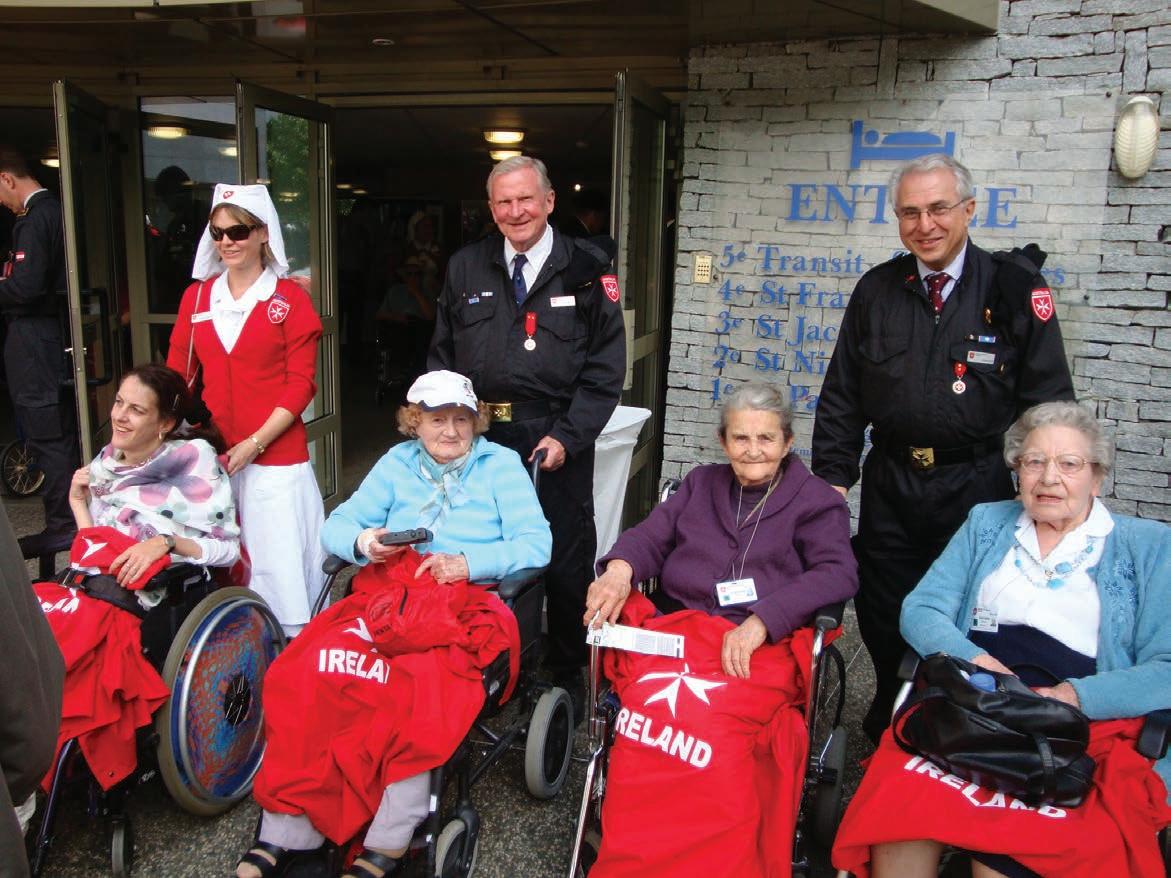

e 12th Order of Malta Asia Paci c Conference held in Seoul was a well organised a air. Many Australian representatives were present including Australian Executive Council members, Diplomats and members.
The 12th Asia Paci c Conference of the Order of Malta was held in Seoul, South Korea between October 18 and 22 2023. Over 50 representatives from National Associations, Delegations and Embassies of the Order of Malta across the two continents gathered to discuss how to strengthen works and initiatives in this area of the world.
e Asia Paci c Conferences provide an opportunity for discussion, exchange of ideas and to get guidance from the Grand Magistry. Present were the Grand Chancellor Riccardo Paternò di Montecupo, Receiver of the Common Treasure Fabrizio Colonna di Paliano
and the Prelate of the Order Msgr. Jean La tte. In their speeches at the opening of the conference, they provided an update on recent developments as well as future expectations. Msgr. Jean La tte elaborated on the theme of spirituality and formation as a fundamental factor for the growth of members within the charism of the Order of Malta.
Presidents and Hospitallers of the Order of Malta National Associations in the Philippines, Singapore, Hong Kong, Australia and of the Delegations of ailand and South Korea presented medical and social activities as well as emergency interventions in case of natural
disasters developed in their respective countries and abroad. Special sessions were attended by Malteser International, which outlined its activities on the Asian continent, and Ciomal, the Order of Malta’s special foundation for the ght against leprosy.
e Order of Malta’s embassy in Timor-Leste, one of the poorest countries in Asia, highlighted the important work being done by the Order’s clinic in the capital city of Dili to combat diseases and malnutrition.
An important part of the conference was devoted, through the intervention of experts, to fundraising and project
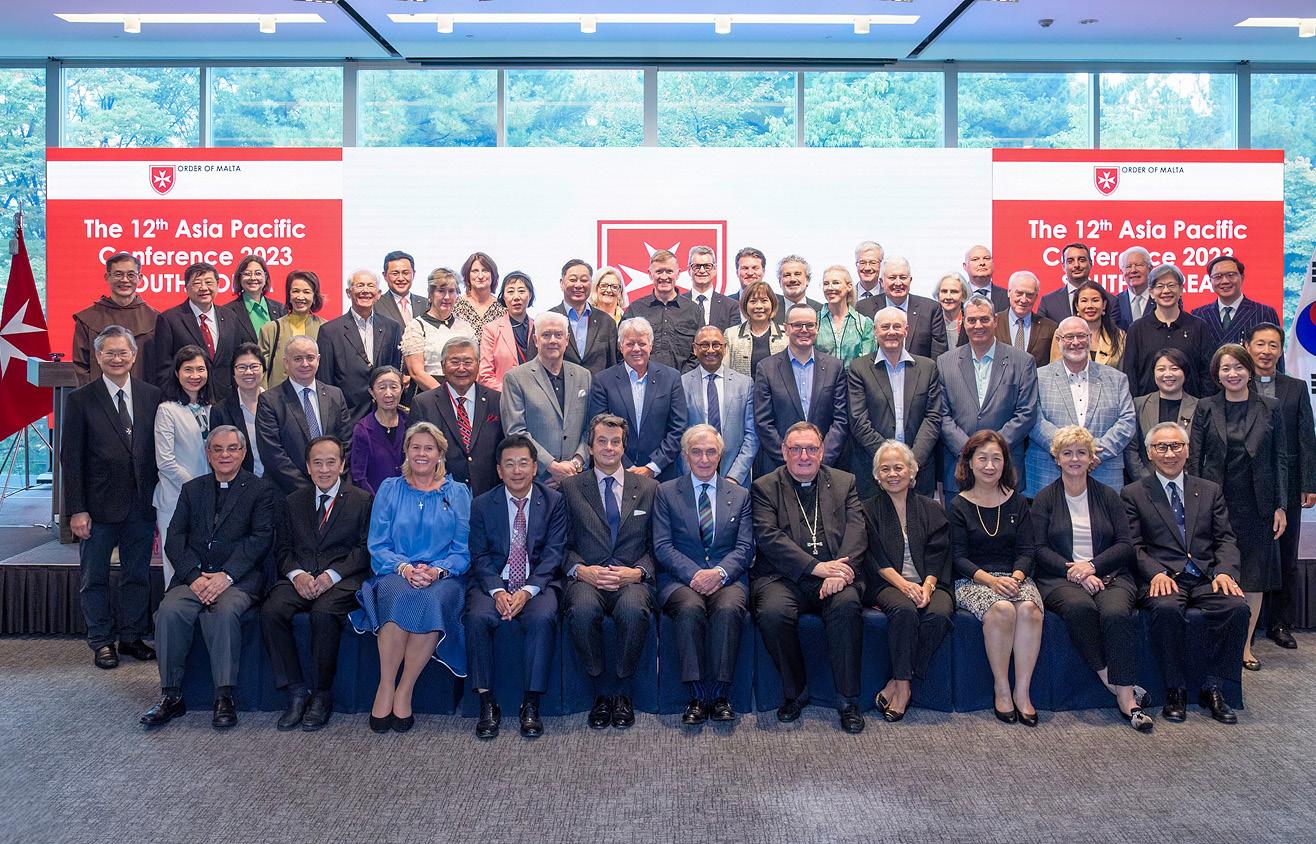



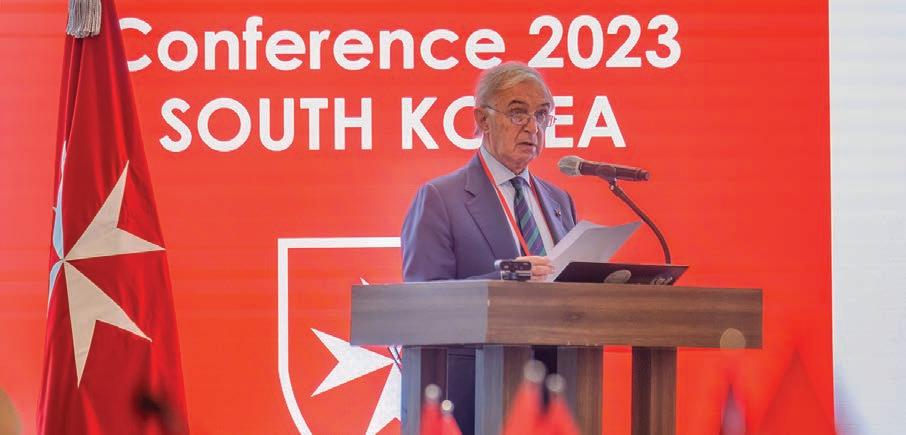

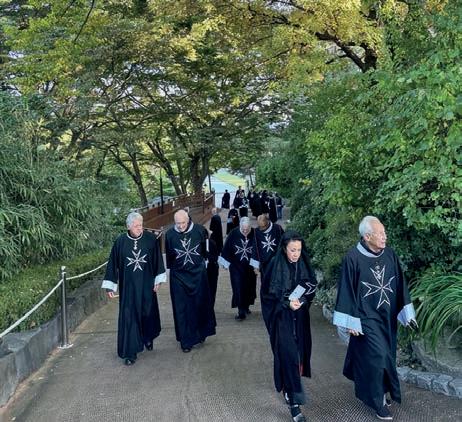
nancing activities, with the aim of strengthening the nancing capacity of the Order’s institutions.
e Asia Paci c Conference was also an opportunity for four new members of the Order to be admitted. During the Holy Mass on 21 October, celebrated by Cardinal Andrew Yeom Soo-Jung
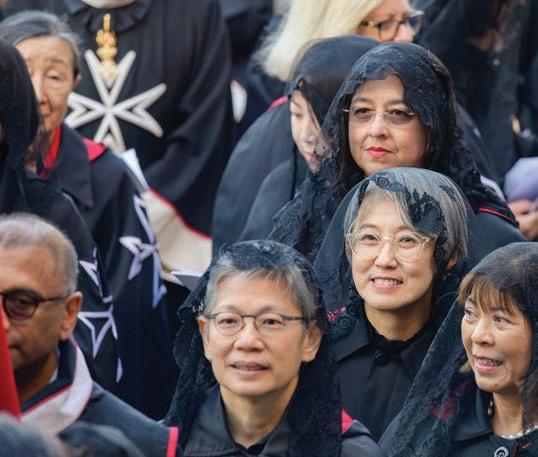

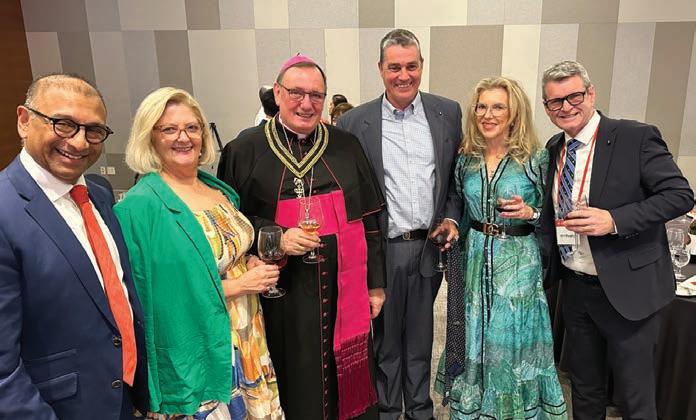
and concelebrated by the Order’s Prelate Msgr. Jean La tte at the Jeoldusan Martyrs’ Shrine in Seoul, three knights and one dame o cially joined the Order of Malta. A round of applause from Conference participants underscored the joy of the moment.
Conventual Chaplain Ad Honorem and Principal Chaplain of the Order in Australia, Archbishop Mark Coleridge at the 2023 Biennial Assembly in Brisbane examines the reasons the Order has survived and thrived in a changing world for over 900 years.
Even a casual survey of the history of the Order of Malta prompts the question “How on earth has it survived through more than 900 years?”
Other orders like the Templars have disappeared, but the Hospitallers have managed to survive against all the odds. Now, as you know, the origins reach back to 1048. When the Republic of Amal , or some of its merchants were given permission by the caliph of Egypt to establish a hospital for pilgrims, particularly poor pilgrims in Jerusalem. en by 1099, the Order of St John of Jerusalem had emerged under the leadership of Blessed Fra’ Gerard to assume responsibility for the hospital. And then in 1113, the edgling Order received o cial approval from Pope PaschaI. en with the fall of Jerusalem in 1291, the Order decamped brie y to Cyprus, and then more permanently to Rhodes in 1310. By this time, the Hospitallers had become ghters, defending Christendom against the growing threat of the Ottoman Empire. ey had assumed military functions.. And with the move to Rhodes, they also began to emerge as a naval power, which was a remarkable adaptation to a new need. By 1523, however, they were expelled from Rhodes a er a long siege by Suleiman the Magni cent who would come to regret his generosity and allowing the Knights to sail away from Rhodes with their arms. e Order was without territory until 1530 when they were permitted by Emperor Charles V with the approval of Pope Clement VII to settle in Malta. So successful were they there in resisting the Ottoman tide, that Suleiman towards the end of his very long
reign, decided to launch what he thought was the nal solution. Only to be driven away astonishingly, a er the great Siege of Malta in 1565. rough these years there was the trauma of the Reformation, which split both Western Christianity and the Order. But again, it was a trauma which shook the Order but didn’t destroy it. And then trauma of a di erent kind came in 1798, when Napoleon decided to expel the Order from Malta. e Knights then settled in Ferrara in 1826, and eventually in Rome in 1834.
In 1879, Pope Leo XIII, restored the o ce of Grand Master which had fallen into abeyance, and this presaged the resurgence of the Order through to the 20th Century. In 2016, however, there was the constitutional crisis, which has only recently been resolved. is saw the intervention of Pope Francis, who in e ect assumed control of the Order through a special delegate. With the election of the new Grand Master and the naming of a new Cardinal Patronus, the Order seems to have moved into calmer waters. Now even this quick- re thumbnail sketch shows why it makes sense to ask how the Order has survived. Given that there were so many moments the Order might have vanished into the black hole of history. A simple answer to the question is that the Order of Malta has shown through time an extraordinary capacity to change and adapt, not just to survive, but to remain faithful to the charism.
It’s worth recalling that a charism is a gi given by God to an individual or a community for the sake of the world. In the case of the Order, we can say that the gi was given through Blessed Fra’ Gerard

and his rst hospitals, not just for their own sake, or the sake of the Order as it became, or even for the sake of the Church, but for the sake of the world. ose who have come a er Gerard and his brothers have been entrusted with the same charism which eventually focused in the two-fold call of obsequium pauperum’ andTuitio dei , which I would translate as service of the poor and promotion of the faith. e great strength of ‘obsequium pauperum’ is that both are open to endless interpretation and adaptation. Neither commits the Order to a form of service or identity, which are xed to a particular time and place, and which can vanish and with them the Order once the time and place change. Now, this is what’s happening to many of the Catholic task forces founded in the 19th century, to perform particular services in areas like education and health care. ere was no one else to perform these basic services, certainly not governments. ese task forces o en became

religious congregations, think of the Sisters of Mercy and the Sisters of St Joseph. Once governments entered the eld, however, and took over the tasks, these congregations lost momentum, and recruitment became di cult. It’s a somewhat di erent story, however, for the religious congregations, like monastic communities, who are geared not to particular tasks, but to a less speci c identity grounded in things like the life of prayer, that don’t pass with changing circumstances.
And this is an important part of the answer to the question, why and how has the Order survived. It’s been geared to tasks certainly, but tasks that can be so variously interpreted and adapted that they don’t pass with time. e work of interpretation and adaptation has required of the Order through the centuries, a clear sense of the charism and a real creativity in Order to survive and even ourish. Now, this dynamic of change for the sake of delity is hardly unique to the Order of Malta. In fact, it’s found at the heart of the Bible. Ancient Israel was created and called by God to stand in the world as a counter society, of a community of slaves set free, in a world under the sway of pharaoh’s logic, which is “once a slave, always a slave”. In that sense, God’s plan was for his people to be an emblem of hope, in an o en hopeless seeming world. e history of ancient Israel was even more tumultuous than the history of the Order of Malta. And the question time and time again was, “What does it mean to live our God-given identity in such a vastly di erent setting?” e clearest expression of
ancient Israel grappling with this question is found in the great law codes of the Old Testament. ey come from di erent periods of the chosen people’s history.
And each of the law codes seeks to articulate the God-given identity in very di erent circumstances. Since Vatican II, we’ve become familiar with the biblical phrase. e people of God. But a better translation of it would be the society of God. Because in the law codes, we nd something more structured. e changing structures of a society intended to live as the counter society of God, a community of slaves set free, and an emblem of hope. In order to be faithful to that God-given identity, ancient Israel had to change and adapt time and time again. Now, the Old Testament gives abundant evidence of the process.
It’s worth noting that Judaism has been even more a miracle of survival than the Order of Malta. And through a much longer period of time, Judaism has managed to survive and even ourish against the odds, when all the great empires have vanished. Not even the Holocaust, the nal solution could do the trick. e reason for this is that Judaism through thick and thin, has clung to its charism, largely because it clung to the Torah, the law, which was and is the prime expression of who God has created, and called them to be. Many of the structures of Judaism, even the temple, could be destroyed. But the one thing they couldn’t destroy was the Torah. ey could burn the scrolls. ey always do. But the Jewish people had
memorized the text and could write it out again when the time came. And that’s why memorization of the Torah remains a linchpin of Jewish religion, especially the religious education of the young. Now, what’s true of Judaism is also true of Christianity, the Church, where we see the same dynamic of change and adaptation for the sake of delity, like Judaism, Christianity has made its way through the tumult of history, and has had to adapt to vastly changed circumstances in Order to remain faithful to the gospel of Jesus Christ, which is the core of the Church’s identity.
e Second Vatican Council was a dramatic recognition that the world was changed forever by the First and Second World Wars. at two-part apocalypse, which le us its emblems, the ash heaps of Auschwitz and Hiroshima. e Council sought to adapt the Church to this changed world, and to equip her for a new season of mission in it. Some saw this as caving into the spirit of the age, but in reality, it was yet another necessary adaptation for the sake of delity. To deny or resist the need for change, as did for example, the feminist movement was to deny history and condemn the Church to being a museum, seeking to inhabit a timeless world that doesn’t exist. In the wake of the Reformation and its traumas, the Catholic Church opted for an illusion of timelessness. Others may change, especially the reformers, but the Catholic Church did not. Also at least it was made to seem through the 19th Century in the early 20th.
is became a rejection of the modern world. But this rejection was itself rejected by Vatican II, which returned the Church to the tide of time. at’s why it’s been called the council of history.
e dynamic at work in the history of the Order therefore takes its place against a larger background of both biblical history and Church history. e Order that has had to make change has to change many times in Order to remain the same. Faithful that is to the founding charism, which remains as valid today as it was 900 years ago. e recent constitutional crisis, it may be argued, led Pope Francis to intervene, so as to defend the charism of the Order and to ensure therefore its capacity to adapt for the sake of delity to its God given identity. In other words, to prevent the Order becoming a museum. As in the past, the question now “What might obsequium pauperum and tuition dei mean at this time?’ is implies questions like, “What does poverty look like here and now? Who are the poor?”Given the charism of the hospital, this in turn implies questions like, “What does sickness mean these days?” “Who are the sick?” “What does massive government investment in social welfare and health care mean for the Order’s service of the poor and the sick?” e Order came to birth at a time when governments had little or no involvement with either social welfare or health care. e poor and the sick were le for the most part, to the care of family, community or church. at’s no longer the case. So the context in which the Order serves the poor and sick now is quite di erent. It would seem to make sense then for the auditor to ask what or who is falling between the cracks in the government services to the poor and sick? No government can do it all. One immediately obvious answer as regards the sick is palliative care, which in this state, at least, is scandalously ignored by the government. And I suspect that Queensland isn’t unique on this.
How then might the Order bring its people and resources to bear in the eld of palliative care at this time? And that’s a question that we will take up at this conference. e question strikes me is very pertinent at this time, keeping in mind that palliative care means the care of the whole person, not just the alleviation of bodily pain. As regards the poor, I’m led to re ect upon a remarkable funeral I attended recently in Melbourne and at which I preached, it was the funeral of Father Bob McGuire. He, more than any other priest, in uenced my own decision to enter the seminary, a er I’d le school to go to university with no thought of the priesthood. Bob had an extraordinary heart for those he called the unloved and the unlovely. And a genius for identifying and befriending the urban poor. His was a ministry of the streets, where many of them lived in a place where mental illness and drug abuse o en coincided. He gathered a group of supporters and over time built a ministry which no government could replicate. He gathered up what fell between the cracks of o cial institutional responses, he befriended the friendless. is isn’t the place to o er detail of Bob McGuire’s ministry in and around in South Melbourne. But it is worth mentioning, in order to see more of what obsequium pauperum might look like these days. Like Father Bob, Pope Francis has made it clear
that obsequium pauperum and tuitio dei cannot be separated in the Christian life. Both look to the gure of Christ. obsequium pauperum takes its cue from Matthew 25, where the king is heard to say, insofar as you did it to the least of my brothers and sisters, you did it to me. Servicing the hungry, the thirsty, the refugee, the naked, the sick, the imprisoned, is service done to Christ himself. As I said in my homily at the McGuire funeral, it was out on the streets among the unloved and the unlovely that Bob found Jesus and Jesus found Bob. Without this focus upon Jesus and therefore the poor, there’s always the risk that faith will degenerate into an ideology, become a wall which separates rather than a bridge which unites. It’s not an ideology that the Order is called to promote. at can’t be the meaning of tuitio dei. In fact, part of promoting the faith will be protecting it from the incursions of ideology. It will also mean looking for ways to build bridges and initiate dialogue in a bitterly fragmented and polarized world. e Order came to birth and grew strong in a world where Christendom stood over and against a burgeoning Islamic world. And this o en entailed violent con ict. But those were other times. Christendom no longer exists except as an ideological dream. And the Order has to make its way through a very di erent landscape, where the voice of God, it seems to me, is heard in the papal summons, found in Fratelli Tutti, which echoing the words of St Francis calls all Christians to a new commitment to universal fraternity. One of the most striking stories about St Francis is his death-defying encounter with the Sultan of Egypt. So, as St Bonaventure describes the meeting, the Sultan asked the two friars, by whom and why and in what capacity they had been sent, and how they’d got here. Francis replied that they had been sent by God, not by men, to show the Sultan and his subjects the way of salvation, and to proclaim the truth of the gospel. When the Sultan saw Francis’s enthusiasm and courage, he listened to him willingly and pressed him to stay with him. ere in Bonaventure’s account, Francis greeted the sultan with the words, “May the Lord give you peace” , which are similar to the traditional Muslim greeting ,“Assalamu alaykum (Peace be upon you)”. is surprised the Sultan, who was very quickly impressed by the saint’s holiness. Francis proceeded to preach the gospel in such a way that the sultan was not o ended, and didn’t have Francis executed immediately for blasphemy.
e Sultan could sense the love that owed from Francis and was astonished by his boldness. ey spoke together of the spiritual life and re ected on each other’s tradition. e two friarsin fact stayed in the Muslim camp for several days and departed on peaceful terms, as they le the Sultan o ered Francis lavish gi s but the saintrefused because of his vow of poverty. ese two astonished the Sultan. Francis eventually accepted the single gi of an ivory horn, which I’m told is still on display in Assisi. e encounter changed the Sultan, who not only gave passage to Francis and his companions, but also began to treat Christian prisoners of war with unexpected moderation even kindness. e Sultan was used to dealing with crusading forces, who saw themselves as promoting the faith as servants of tuition dei.
A simple answer to the question is that the Order of Malta has shown through time an extraordinary capacity to change and adapt, not just to survive, but to remain faithful to the charism.
And in dealing with them he was brutal for answers to showhimself as promoting the faith, but by radically di erent means. e question for the Order now is “Which of the two the Crusaders or the friars more truly and e ectively embodied tuition dei?” Or “Which of the two points in the right direction for the Order now?” In grappling with questions such as these, the auditor will need to be as bold and creative now as those who went before us as they sought to adapt to dramatically changed circumstances, not just looking back upon a long and glorious history, in a kind of narcissistic nostalgia, but scrutinizing the signs of the times with the eyes of faith, asking where God is in the maelstrom and how God wants us to respond now and into the future. To live obsequium pauperum in our time will demand as it always has, that we enter more deeply into our own poverty and into the poverty of God. Unless we do that our service of the poor will almost certainly become a kind of patronization, a gesture which may make us feel better, but which does little or nothing for the poor. God chooses to be poor in the Incarnation, when he chooses to become one of us. e Son of God, born in a stable has nowhere to lay his head, and will end up in the utter poverty of Calvary. As St Paul says, in Philippians , “He emptied Himself, taking the form of a slave. And being found in human form, he humbled himself and became obedient even unto death, death on a cross”. Here we nd the key Pauline word “kenosis”, which means emptying the poor. God empties himself so that we might be lled with the utter fullness of God, so that our abject poverty might be turned to his in nite riches. ough many members of the Order are by worldly standards wealthy and in uential people, all are called to the same self-emptying to make our own the poverty of God, so that our Lord’s the poor and sick might be enriched as God wills. is means that we too are poor people, that we too are sick. But we know in faith that we are made rich in Christ who heals all our wounds, all our sickness, which he takes upon himself. Here I think of the gure of St Damien of Molokai, who went to live among lepers, entering into their world of desperate illness to the point where he contracted the disease and died of it. He’s a sage because we see in him the image of who God is for us. ough Damien died in obscurity, he will never be forgotten, and will live forever as a sign of hope. Not just to the lepers he served, but to the world.
His ministry and his eventual death were no accident. ey were conscious choices of a man who knew he was poor and sick, and who knew the saving power of Christ cruci ed in his own life, and was determined
to o er it to the lepers of Molokai. I also think again of St Francis. e story is told of Francis meeting a leper while riding his horse near Assisi. As with any one of his time, Francis had a horror of leprosy. Yet he got o his horse, kiss the leper, and gave him some money. When he mounted his horse again and looked around the leper had vanished. And it said, Francis realized that it was Jesus, he had kissed. Now, this was a transforming moment in Francis’s early life, he was able to kiss the leper, only because he’d kissed the leper in himself. And because he recognized the presence of Christ in the leper. at’s what it means to accept our own poverty, and the poverty of God. And that’s what obsequium pauperum may look like. So to live tuitio dei in our time, will demand that we enter more deeply into the faith we have in God, and into the faith God has in us. Obviously, we need to possess the faith we seek to promote. If we don’t, then the Order would be just another NGO. So what is the faith that the Order is to promote?
We can begin by saying what it’s not. It’s not an ideology, not a philosophy, not an ethic, not a political program. ough it may give birth to these from time to time. e faith the Order is to promote is a response to the encounter with the risen Christ. A yes to Him, allowing Him to lead even where we would rather not go. For the Christian, the virtuous life is part of discipleship, but it’s a response to the encounter with the risen Christ. In that sense, the fruit of faith. It’s not a substitute for the encounter with Christ.It is a substitute, then Christianity becomes a kind of moralism, a path of self-improvement in which I try to earn my own salvation. e letter of James makes it clear that faith without works is dead. But these works are the fruit of faith, not a substitute for it. For the Order, obsequium pauperum, whatever it might mean from time to time, is the fruit of faith. e works which ensure that our faith is not dead, the works ow from faith and strengthen it in turn. We say that Abraham is our father in faith. And so he is. Out of the blue Abraham encounters God or rather God encounters him. A god he doesn’t know urges Abraham to leave his familiar world and set out on a journey into the unknown, on the strength of God’s promise to give him a son and a land of his own. e promise seems impossible, all the land is taken. And Sarah, Abraham’s wife is barren. God doesn’t o er him a roadmap or a GPS. He simply says that Abraham must follow wherever He leads. e encounter with God is ongoing, therefore, in the sense that Abraham must keep his eye and his ear on the only one who does know where the journey is going. And that’s God. ings go well for Abraham, he keeps his eye and ear on God. But they go very

badly indeed, when he loses his nerve, takes his eye and ear o God, and takes control himself. Now his story tells the story of what faith means for us. is Abrahamic faith isn’t opposed to reason, though something it is. It was St Pope John Paul II who said that faith and reason are like two wings on which the human spirit rises to the contemplation of truth. It’s very hard to y on one wing. Faith and reason require each other. Faith without reason withers into superstition. Reason without faith withers into one dimensional rationalism. Our culture tends to presume that the only thing which quali es as knowledge is empirical knowledge, the god of knowledge we call scienti c. But the Bible in the indeed art more generally, make it clear that there are other kinds of knowledge, not in opposition to empirical knowledge, but extending its range into the world of the unseen faith is a communion with the unseen, which produces a very real kind of knowledge, and allows reason to reach beyond the empirical to attain its true goal. Ultimately, faith is communion with the unseen God. e God in whom we put our

faith is also the God who puts his faith in us. One of the creators most extraordinary decisions was to give the human being the gi of freedom. at was because God wanted a response of love from his creature and love is always free, if it’s love at all.
But the gi of freedom also made sin possible when human beings freely decide to oppose God, and even attempt to replace God. But true faith nds its way to a harmony with God’s glory and our glory are in no way opposed. On the contrary, the human being nds true glory, only in glorifying God. At that point, faith comes to its fullness. Now, I began with the question “Why and how has the Order of Malta survived when so many others have gone under?” e answer I’ve given is that the Order was able to adapt to dramatically changed and changing circumstances. at was because it’s charism focused in obsequium pauperum and tuitio dei allowed for such exible interpretation and adaption. e Order was also able to stay focused on the charism and to keep asking, “What does it mean to live the charism? In these times?” e same question is posed to the Order today, if it is not to become a museum, a community which knows how to look back, but not how to read the signs of the times now or to look forward. It was for centuries a great maritime
power, building its empire on its trade with the east, which depends upon its galleys, its naval power in the Mediterranean. But Venice was so successful for so long that it was unable or unwilling to change. Its galleys were outstripped by new naval design and technology, but still La Serenissima ploughed on with its galleys. ey had worked brilliantly in the past. Why would they not work brilliantly now? Venice was also overtaken once the Portuguese rounded the Cape of Good Hope, in the late 15th century, and found a quicker sea route to the east and its riches. But Venice kept ploughing on more slowly across the Mediterranean as it had always done, allowing others to beat it to the markets of the East. us began the long slow decline that culminated in Napoleon’s abolition of the republic in 1798. at is distantly why Venice is now a little more than a combination of museum and theme park. No one surely wants the Order of Malta to su er anything like the same fate. And that’s why the question I have posed matters, and why it matters that the Order grapple with the question of change. With no less faith and charity, no less boldness and creativity. en did Blessed Gerard and all those who have gathered beneath the Maltese cross since the late 11th century.
In 2020, candidates in their year of preparation, initiated the Our Lady of Philermos Rose project that had both spiritual signi cance and hands-on engagement with our Lord, the Poor and Sick.


Band 190 plants now grow at aged care facilities, cathedrals, parishes, an Australian Catholic University Campus and member’s homes across Australia. A plant is also growing in the gardens of the Order of Malta’s Magistral Villa in Rome. In 2024, further locations will be added and volunteers will begin distributing roses to patients in palliative care facilities, care homes and hospitals. e charitable act of gi ing the rose, and the interaction with volunteers, intends to

bring the recipients comfort and joy.
St John Henry Newman provides thoughts of the connection between Mary and the Rose:“MARY is the most beautiful ower that ever was seen in the spiritual world. It is by the power of God’s grace that from this barren and desolate earth there have ever sprung up at all owers of holiness and glory. And Mary is the Queen of them. She is the Queen of spiritual owers; and therefore, she is called the Rose, for the rose is tly called of all owers the most beautiful.”
Roses have long been considered in classical culture as the most noble of owers. For Christians they have become a symbol of the beauty, love and purity of the Mother of God and have led to the creation of the Rosary and other devotional prayers. e Order of Malta rose, named a er Our Lady of Phiilermos, embraces this symbolism.
Another spiritual element of the project is the accompanying hymn, “Your Beauty So Bright”. It was written by Confrère David Macintosh with an imprimatur and music composed by the late Christine McCarthy, mother of our Order’s Chaplain Father James McCarthy and wife of Confrère HE John McCarthy John McCarthy KC KGCPO KSG. . e hymn was professionally recorded by ConsoeurAnjarat Suthat Na Ayuthya, a member in ailand.
When the Rose for the Order of Malta was rst conceived no one would have imagined that it would grow into something so special and spiritual, with members of the Order across Australia embracing it:
Deirdre Page DMG (OB)
I go to practice with my Ukulele group and always visit the Statue of Our Lady and the beautiful Our Lady of Philermos Roses at her feet. I can feel her presence and the spirituality is growing with
the roses and the sense of her pleasure. Our Lady becomes more important every time I see her with the fragrant roses being there and listening!
Rev Father James McCarthy
PP Magistral Chaplain
Witnessing the process of Christine and David Macintosh composing this hymn is a pleasured memory of faith, family and the outreach of the Order of Malta. I recall the delight my mother had when the initial score was digitized, her encouragement when we listened together to our recording of the hymn when she was su ering in ICU a few weeks prior to her death, the unity with Christ’s death when the hymn was sung at her funeral with my siblings, full choir and orchestra, and the intensity of praying the hymn at her graveside when she was buried. Finally, I recall the prayerfulness and Christmas joy of congregants when the hymn was sung as part of St Mary’s Cathedral Sydney Carols Service just a fortnight a er my mother’s funeral. We all called to unite our life with Christ, and this beautiful hymn helps in the highs and lows, the joys and su erings of everyday life.
Rev Father Gerard McMorrow
PP Magistral Chaplain
To me this rose is a material symbol of Mary, who is the epitome of beauty, humility, love, kindness and so much more. It is a constant reminder of what I strive for.
Far le : Ben Frasco and his daughter Rosie at the Little Sisters of the Poor. Le : Hymn to Our Lady of Philermos.
Right: Deirdre Page DMG (OB) standing with a statue of Our Lady.
H.E John McCarthy KC KGCPO KSG
Christine was greatly pleased with her musical accompaniment for the hymn by David Macintosh in honour of Our Lady of Philermos. She believed it was not di cult to play or sing and the combination of words and music would be a ne anthem for the Order of Malta both in Australia and internationally. Christine thought the Order’s daily prayer with the reference to Our Lady of Philermos would be enhanced and the spirituality of Order members deepened.
Michael Murphy KMG
Our Lady of Philermos Roses as with all masterpieces care and waiting is required. It takes time to blossom. Just as a mother and her newborn baby. A er a mother has smiled at her child for many days, perhaps weeks, she nally receives s smile in response. She has awakened in the heart of her child its rst sign that it knows it is loved. Like the Rose of Our Lady, something awakens in us when we encounter something beautiful.
Joseph Mastrangelo Jr KMG
e Our Lady of Philermos Rose, nestled beside a statue of the Blessed Virgin Mary at my home’s entrance, serves as a public symbol of God’s abundant grace and spiritual blessings. Both the statue and the rose inspire my contemplation on Catholic virtues, leading towards the Beati c Vision. Inspired by the esteemed history of the Order, the red petals hold signi cant symbolism, as does the entire plant, from its rich black soil to its healthy green stem and leaf canopy. e thorns serve as poignant reminders to defend Christ’s Church against heresy, to serve the poor and sick. In essence, the entirety of the plant acts as a guiding in uence, steering my thoughts and actions on Christ Jesus.
Frank Testa KMG (OB)
My parents, Mary and George have a small grotto in their backyard with a statue of Our Lady of Fatima. ey have placed the Our Lady of Philermos rose at the foot of the grotto so that the bush and owers can be a living tribute to Our Lady.
e beauty of this Our Lady of Philermos Rose is an earthy reminder of the delicate beauty of our mother Mary. e thorns of these stems remind us of Mary’s sorrows. e evergreen leaves remind us of life eternal with God through our Mother’s constant intercession. Mother Mary, we ask for your protection.
Ben Frasco
e roses gi ed to the Little Sisters of the Poor symbolise the united mission of serving the sick and poor, shared by our Orders. ese roses, embodying the Rosa Mystica and re ecting our cherished Icon of Our Lady of Philermos, underscore the spiritual heritage of the Knights and Dames of the Order of Malta.
Roses for purchase, the hymn, its musical score and recordings are available from www.orderofmalta.org.au/rose.
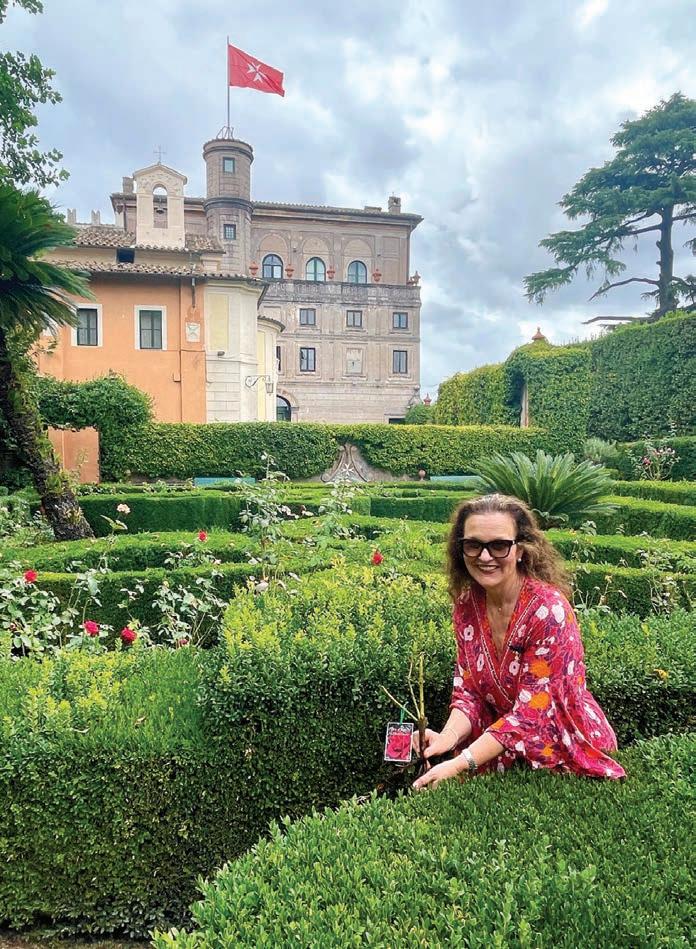

is examination of conscience guide structured around the Daily Prayer of the Order, may be used as a tool to give members a bearing on how they are living their commitments in the Order of Malta.
Lord Jesus, ou has seen t to enlist me for y service amongst the Knights and Dames of St John of Jerusalem
1. Lord Jesus, remembering commitments I made to you when I entered the Order, have I disappointed your trust in me in any way?
I humbly entreat ee through the intercession of the most holy Virgin of Philermos, of St John the Baptist, Blessed Gerard and all the Saints, to keep me faithful to the traditions of our Order.
2. Have I actively modelled myself a er the examples of our patrons Our Lady of Philermos and St John the Baptist, our founder Blessed Gerard?
3. Have I regularly served those in need, especially the poor and sick, in the tradition of our founder and predecessors throughout the history of our Order?
Be it mine to practise and defend the Catholic, the Apostolic, the Roman faith against the enemies of religion.

4. Have I consistently and ardently practiced the Catholic faith – in prayer, Eucharist and Confession, in retreats, in learning about my faith, and in works?
5. Have I failed to stand up in word and action when attacks against our faith are made whether in ignorance or hostility?
7. Have I been unloving or disinterested to those close to me in my life?
8. Have I been indi erent to those in need, especially the poor and the sick I see, as well as others in need – the homeless, lonely, marginalised, displaced – all who are lowly and vulnerable in our community?
9. Have I failed to show up for works of the Order due to lack of interest, laziness, or failure to give space in my life to the
Give me the strength I need to carry out this my resolve, forgetful of myself, learning ever from y holy Gospel a spirit of deep and generous Christian devotion, striving ever to promote God’s glory, the world’s peace, and all that may bene t the Order of St John of
10. Have I regularly made the e ort to expand and deepen my understanding of the holy Gospel and let the Word of God penetrate my heart?
11. Do I love God with all my heart, soul, and strength? Is God the centre of my life, and so, do I love all other people, things, and activities in light of my rst love of God?
12. Have I been a peacemaker, building and supporting positive relationships among fellow members, staying out of gossiping, scandalising, quarrelling, and politicking?
13. Have I actively pursued opportunities to help the interests of the Order of Malta?
Composed by Daniel Kwok KGCMG (Ob)in discussion with the Most Reverend Bishop Danny Meagher Conventual Chaplain ad honorem.
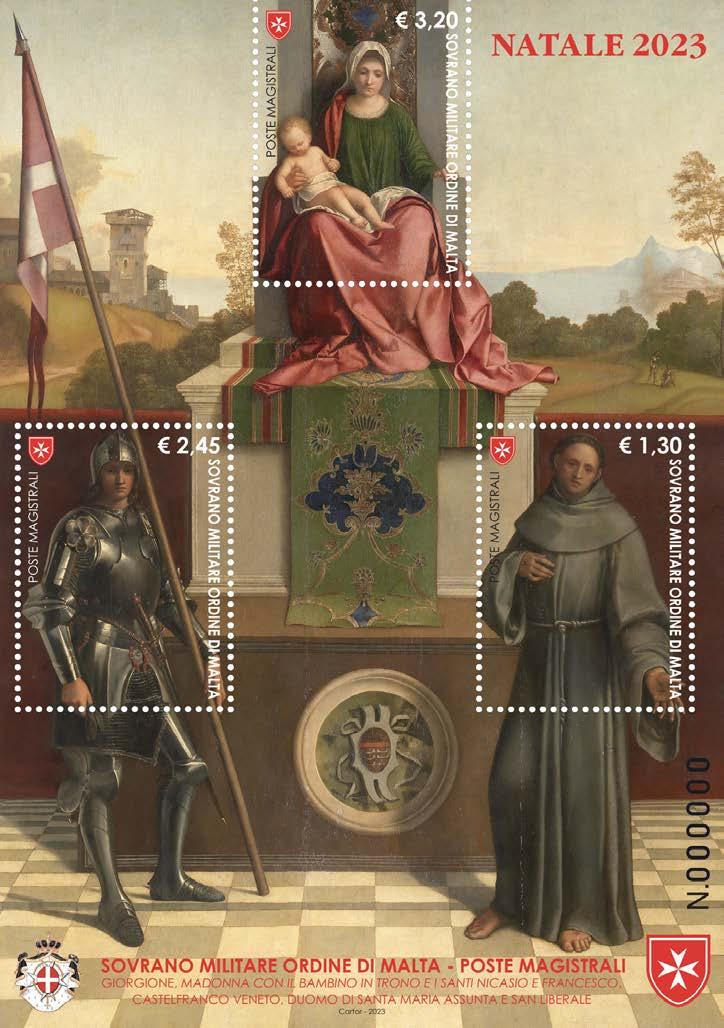

The Order’s website in Australia: www.orderofmalta.org.au /orderofmalta.org.au /orderofmaltaau The Order’s international website: www.orderofmalta.int The Malteser International website: www.malteser-international.org
